Sony AD021022 Licensed Transmitter User Manual VF Nanami UG R1A
Sony Mobile Communications Inc Licensed Transmitter VF Nanami UG R1A
Sony >
Contents
- 1. Exhibit 8 User Manual part 1
- 2. Exhibit 8 User Manual Part 2
- 3. Exhibit 8 user manual part 1
- 4. Exhibit 8 user manual 2
Exhibit 8 User Manual part 1

1
Introduction
In this part of the user guide you find a table of contents which
offers a general outline of the guide. To find more specific informa
tion about your phone’s functionality, please refer to the index at
the back of the user guide.
You will also find information about what is included in the box
when you unpack your phone.
VF_Nanami_UG_R1A.book Page 1 Tuesday, June 14, 2005 10:00 AM
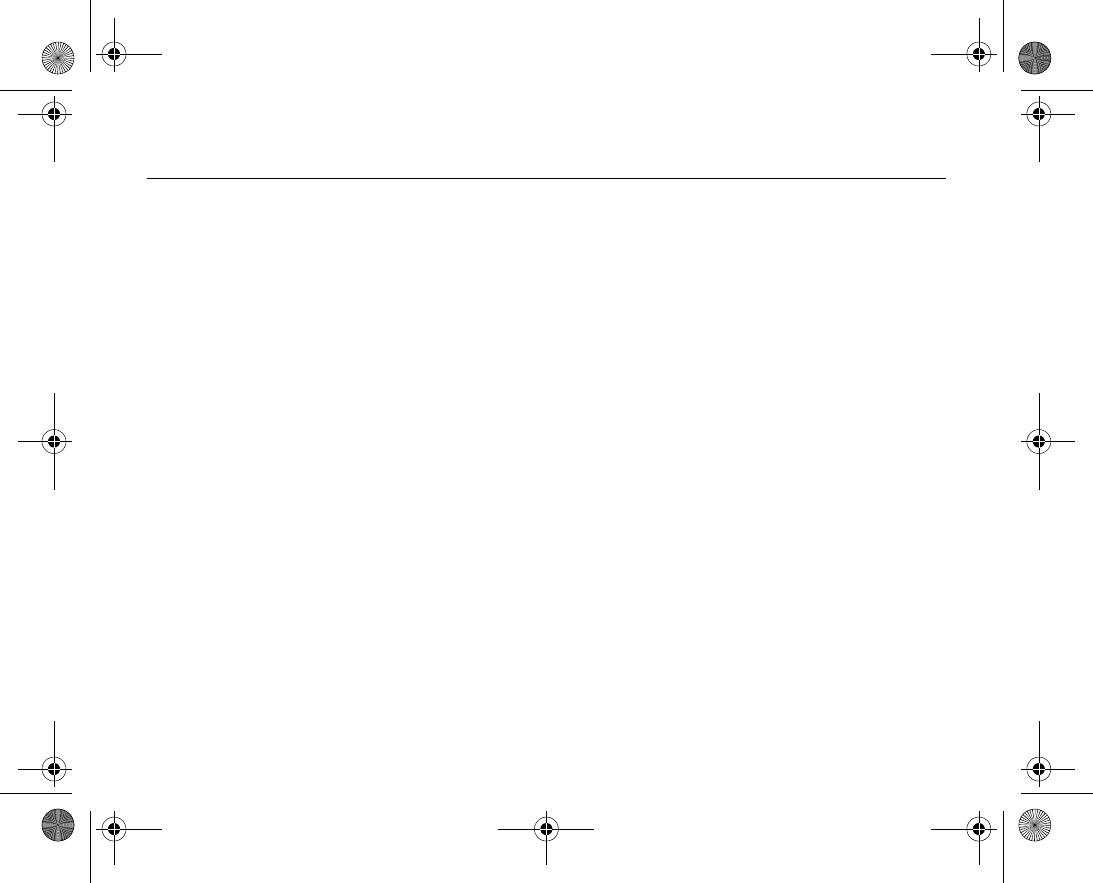
2
Congratulations 1.1
Congratulations and thank you for choosing the Sony Ericsson V600i (customized for
Vodafone live!).
We hope that you will be pleased with this new 3G phone. It will bring you the best of
mobile telephony, including faster 3G access to Vodafone live!, video calling, video mes
saging, video and music clip download (saved to your phone or streamed to your phone
to view now).
VF_Nanami_UG_R1A.book Page 2 Tuesday, June 14, 2005 10:00 AM
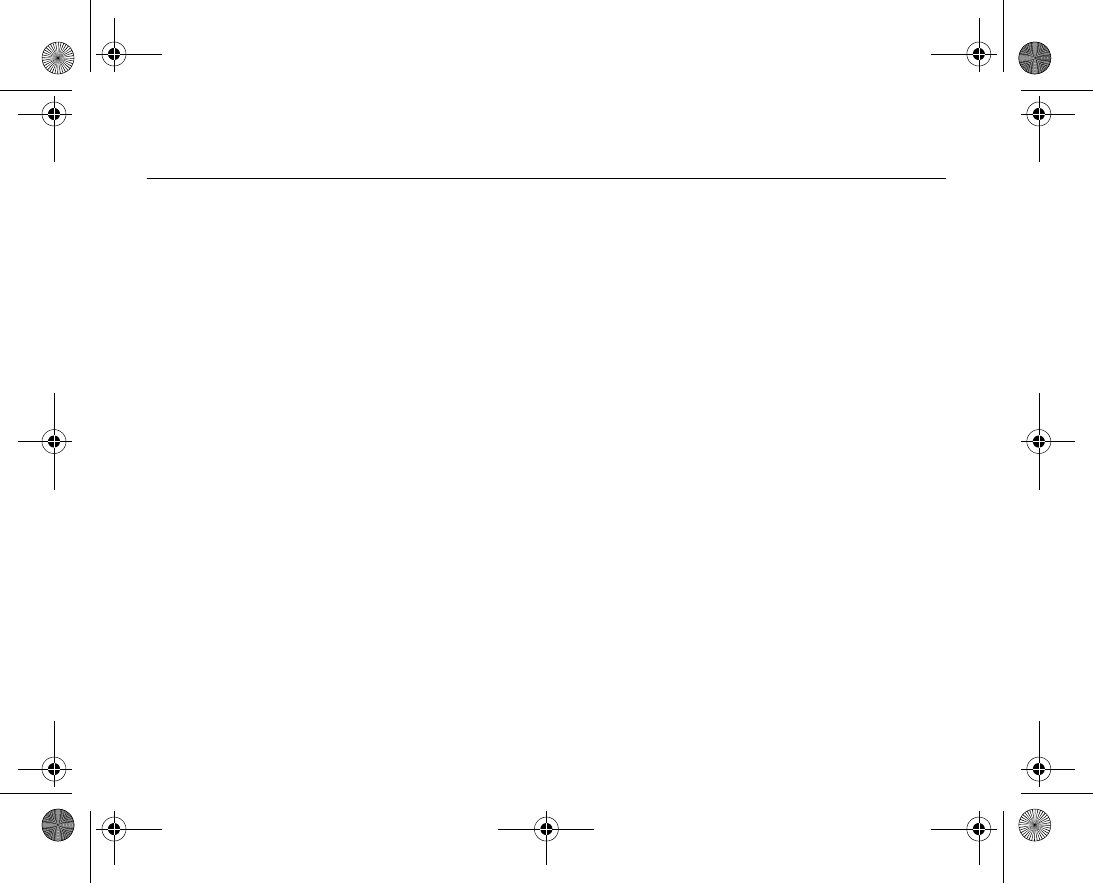
3
1.2 Legal information
Sony Ericsson
UMTSGSM 900/1800/1900
First edition (April 2005)
This user guide is published by Sony Ericsson Mobile Communications AB, without any
warranty. Improvements and changes to this user guide necessitated by typographical
errors, inaccuracies of current information, or improvements to programs and/or equip
ment, may be made by Sony Ericsson Mobile Communications AB at any time and with
out notice. Such changes will, however, be incorporated into new editions of this user
guide.
All rights reserved.
©Sony Ericsson Mobile Communications AB, 2005
Publication number: AE/LZT 108 7765 R1A
Please note:
Some of the services in this user guide are not supported by all networks.
This also
applies to the GSM International Emergency Number 112
.
Please contact your network operator or service provider if you are in doubt whether you
can use a particular service or not.
Please read the
Guidelines for safe and efficient use
and the
Limited warranty
chapters
before you use your mobile phone.
VF_Nanami_UG_R1A.book Page 3 Tuesday, June 14, 2005 10:00 AM

4
Your mobile phone has the capability to download, store and forward additional content,
e.g. ringtones. The use of such content may be restricted or prohibited by rights of third
parties, including but not limited to restriction under applicable copyright laws. You, and
not Sony Ericsson, are entirely responsible for additional content that you download to
or forward from your mobile phone. Prior to your use of any additional content, please
verify that your intended use is properly licensed or is otherwise authorized. Sony Erics
son does not guarantee the accuracy, integrity or quality of any additional content or any
other third party content. Under no circumstances will Sony Ericsson be liable in any
way for your improper use of additional content or other third party content.
The Bluetooth word mark and logos are owned by the Bluetooth SIG, Inc. and any use of
such marks by Sony Ericsson is under license.
3GPP is a trademark of ETSI in France and other jurisdictions.
QuickShare™, MusicDJ™, PhotoDj™ and VideoDJ™ are trademarks or registered
trademarks of Sony Ericsson Mobile Communications AB.
Real is a trademark or a registered trademark of RealNetworks, Inc.
Microsoft, Windows and PowerPoint are either registered trademarks or trademarks of
Microsoft Corporation in the U.S and other countries.
Mac OS is a trademark of Apple Computer, Inc., registered in the U.S. and other coun
tries.
T9™ Text Input is a trademark or a registered trademark of Tegic Communications.
T9™ Text Input is licensed under one or more of the following: U.S. Pat. Nos.
5,818,437, 5,953,541, 5,187,480, 5,945,928, and 6,011,554; Canadian Pat. No.
1,331,057, United Kingdom Pat. No. 2238414B; Hong Kong Standard Pat. No.
HK0940329; Republic of Singapore Pat. No. 51383; Euro.Pat. No. 0 842
VF_Nanami_UG_R1A.book Page 4 Tuesday, June 14, 2005 10:00 AM

5
463(96927260.8) DE/DK, FI, FR, IT, NL, PT, ES, SE, GB; and additional patents are
pending worldwide.
Java and all Java based trademarks and logos are trademarks or registered trademarks
of Sun Microsystems, Inc. in the U.S. and other countries.
Enduser license agreement for Sun™ Java™ J2ME™.
1. Restrictions: Software is confidential copyrighted information of Sun and title to all
copies is retained by Sun and/or its licensors. Customer shall not modify, decompile,
disassemble, decrypt, extract, or otherwise reverse engineer Software. Software
may not be leased, assigned, or sublicensed, in whole or in part.
2. Export Regulations: Software, including technical data, is subject to U.S. export con
trol laws, including the U.S. Export Administration Act and its associated regulations,
and may be subject to export or import regulations in other countries. Customer
agrees to comply strictly with all such regulations and acknowledges that it has the
responsibility to obtain licenses to export, reexport, or import Software. Software
may not be downloaded, or otherwise exported or reexported (i) into, or to a national
or resident of, Cuba, Iraq, Iran, North Korea, Libya, Sudan, Syria (as such listing may
be revised from time to time) or any country to which the U.S. has embargoed goods;
or (ii) to anyone on the U.S. Treasury Department's list of Specially Designated
Nations or the U.S. Commerce Department's Table of Denial Orders.
3. Restricted Rights: Use, duplication or disclosure by the United States government is
subject to the restrictions as set forth in the Rights in Technical Data and Computer
Software Clauses in DFARS 252.2277013(c) (1) (ii) and FAR 52.22719(c) (2) as
applicable.
Part of the software in this product is copyright © SyncML initiative Ltd. (19992002).
All rights reserved.
VF_Nanami_UG_R1A.book Page 5 Tuesday, June 14, 2005 10:00 AM

6
Contains Macromedia® Flash™ technology by Macromedia, Inc. Copyright © 1995
2003 Macromedia, Inc. All rights reserved.
Macromedia, Flash, Macromedia Flash, and Macromedia Flash Lite are trademarks or
registered trademarks of Macromedia, Inc. in the United States and other countries.
Other product and company names mentioned herein may be the trademarks of their
respective owners.
Any rights not expressly granted herein are reserved.
VF_Nanami_UG_R1A.book Page 6 Tuesday, June 14, 2005 10:00 AM
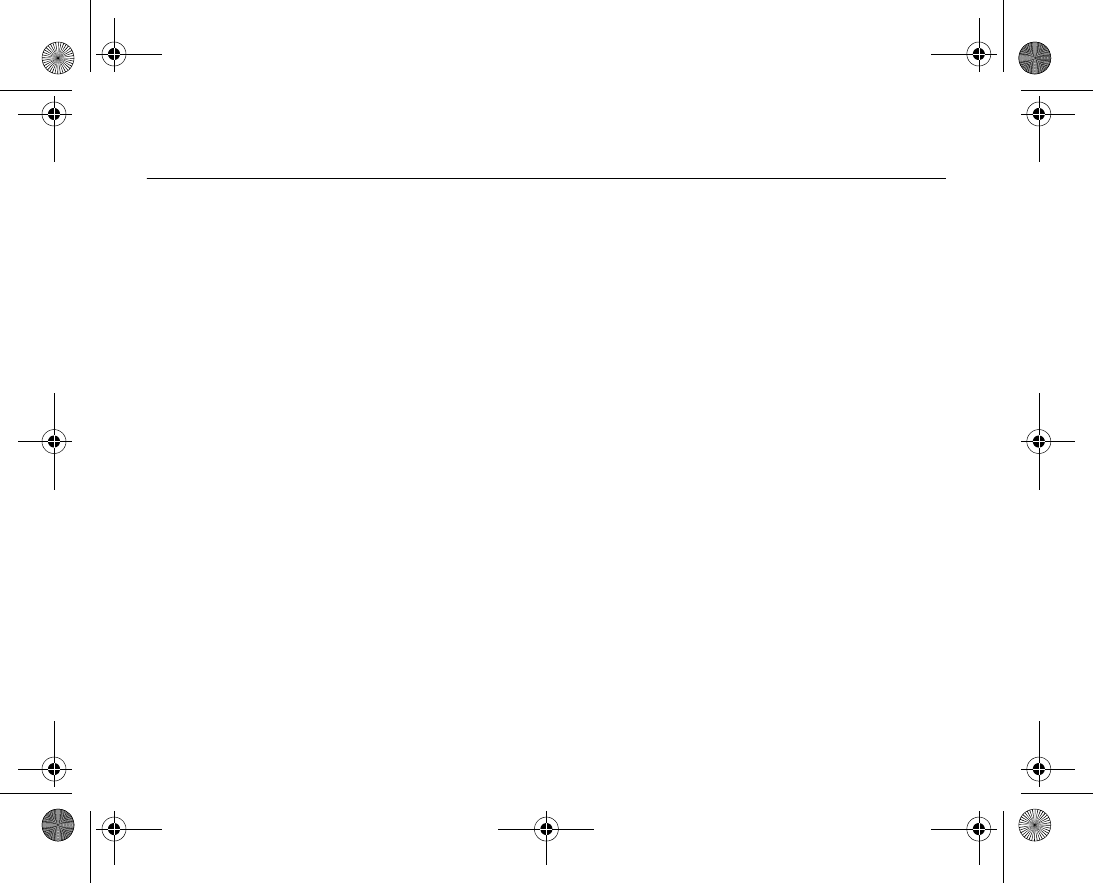
7
1.3 Contents
Introduction .......................................................................1
Congratulations ................................................................2
Legal information .............................................................3
Contents ..........................................................................7
Instruction symbols ........................................................11
What´s in the box ...........................................................12
Basics ..............................................................................13
Getting to know your phone ............................................14
Menu overview ...............................................................15
Getting started ...............................................................16
Keys and navigation .......................................................19
Calling ...........................................................................23
Video call .......................................................................27
Entering letters ...............................................................30
My items .......................................................................33
Contacts ........................................................................35
Call list ..........................................................................41
Speed dialling ................................................................42
Voicemail .......................................................................43
Voice control ..................................................................44
Diverting calls ................................................................48
More than one call .........................................................49
More call features ..........................................................51
VF_Nanami_UG_R1A.book Page 7 Tuesday, June 14, 2005 10:00 AM

8
Messaging .......................................................................57
Text messaging (SMS) ....................................................58
Picture messages (MMS) ................................................62
Voice messages .............................................................66
Postcard ........................................................................67
Email .............................................................................68
Vodafone Messenger ......................................................71
Area information ............................................................73
Pictures and sounds .......................................................75
Camera and video recorder .............................................76
Pictures .........................................................................81
Radio ............................................................................84
Composing melodies ......................................................86
Creating movies .............................................................88
Sound recorder ..............................................................90
Vodafone live! and Internet ...........................................91
Vodafone live! ................................................................92
Internet .........................................................................94
Downloading ................................................................100
live! Studio ..................................................................101
Media Player ................................................................102
Connectivity ..................................................................107
Synchronizing ..............................................................108
Bluetooth™ wireless technology ...................................110
Infrared port ...............................................................115
Transferring files using the USB cable ...........................117
VF_Nanami_UG_R1A.book Page 8 Tuesday, June 14, 2005 10:00 AM

9
Settings .........................................................................119
Setup wizard ................................................................120
Time and date ..............................................................121
Startup screen and power save ....................................122
Themes .......................................................................123
Ringtones and melodies ................................................124
Profiles ........................................................................126
SIM card lock ...............................................................127
Keypad lock .................................................................129
Phone lock ...................................................................130
More features ................................................................131
Calendar ......................................................................132
Tasks ..........................................................................134
More useful features ....................................................136
Troubleshooting ............................................................143
Master reset ................................................................144
Error messages ............................................................145
Troubleshooting ...........................................................148
Icons ..............................................................................153
List of icons shown in standby ......................................154
Index ..............................................................................157
Index ...........................................................................158
Health & Safety ..............................................................165
Guidelines for Safe and Efficient Use .............................166
VF_Nanami_UG_R1A.book Page 9 Tuesday, June 14, 2005 10:00 AM

10
Limited Warranty .........................................................173
Declaration of Conformity .............................................177
VF_Nanami_UG_R1A.book Page 10 Tuesday, June 14, 2005 10:00 AM
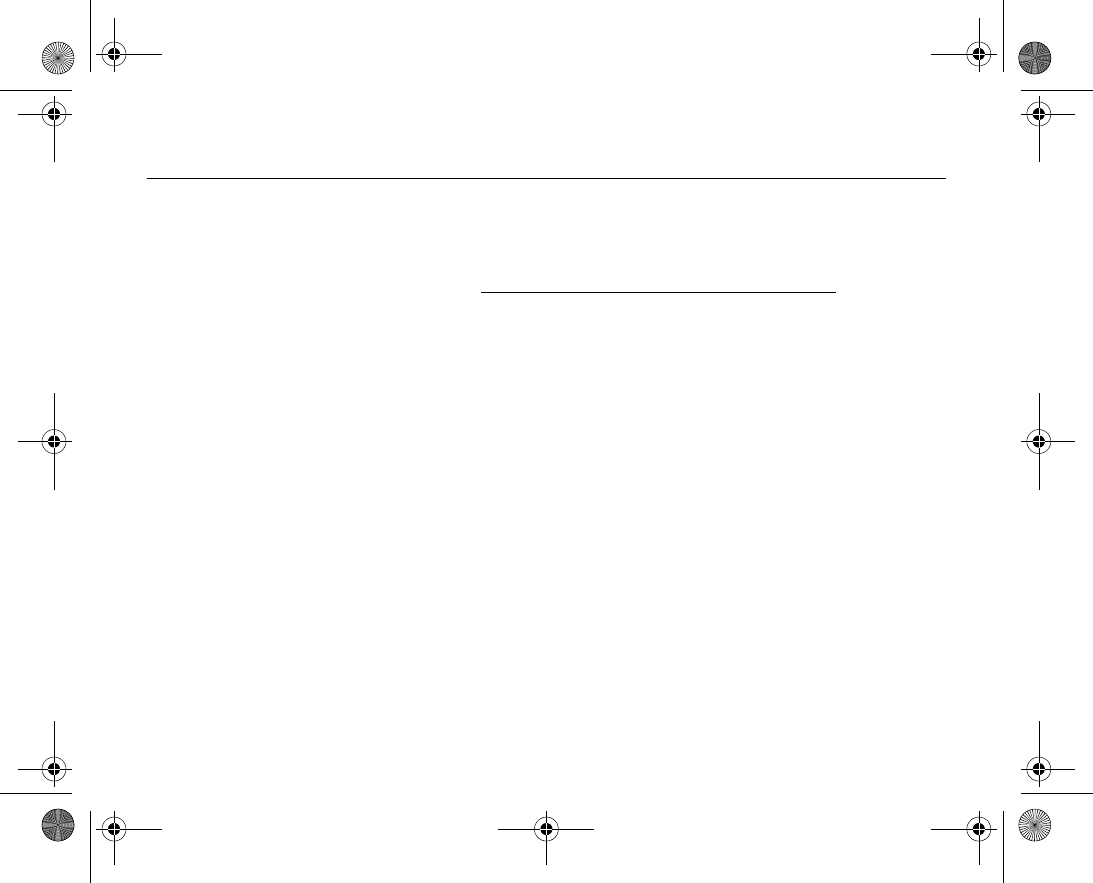
11
1.4 Instruction symbols
The following instruction symbols appear in this user guide:
Please also see %
19 Keys and navigation
for more useful information.
}Use the selection keys or the navigation key to scroll and
select.
%See also page ...
VF_Nanami_UG_R1A.book Page 11 Tuesday, June 14, 2005 10:00 AM
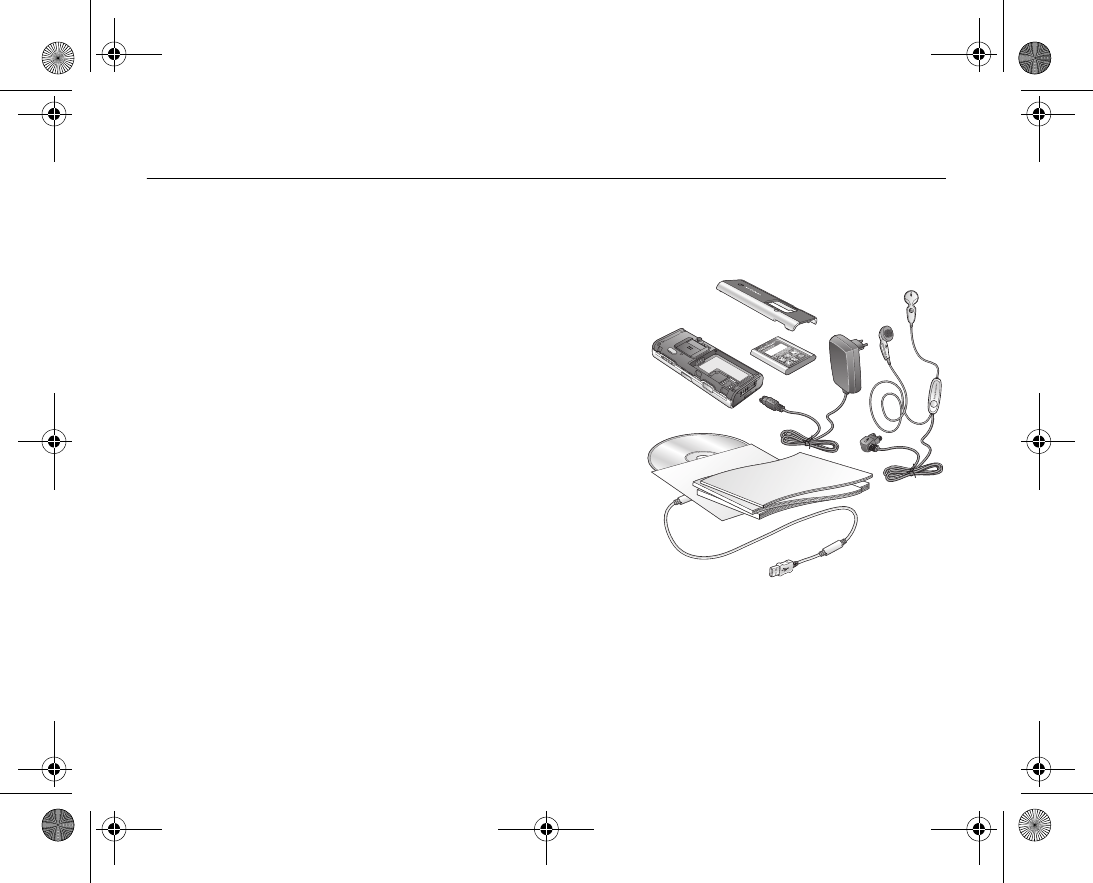
12
What´s in the box 1.5
In the box you will find:
• a phone
• a standard battery
•a charger
•a USB cable
• a portable stereo handsfree headset
• a CD including PC software
• a Vodafone live! Quick start guide
• a user guide (you are reading it now)
%
16 Getting started
for information on how to assemble and start using your phone.
VF_Nanami_UG_R1A.book Page 12 Tuesday, June 14, 2005 10:00 AM

13
Basics
This chapter gives you the basics for getting started with your
phone. You’ll learn how to assemble and turn on your phone, and
then you can use the setup wizard to quickly set up your phone.
You’ll learn how to use call functions such as making voice or video
call, how to use contacts and how to enter text.
There´s also a quick overview of the parts of your phone, the main
functions of the keys, and what´s available in the menus.
VF_Nanami_UG_R1A.book Page 13 Tuesday, June 14, 2005 10:00 AM
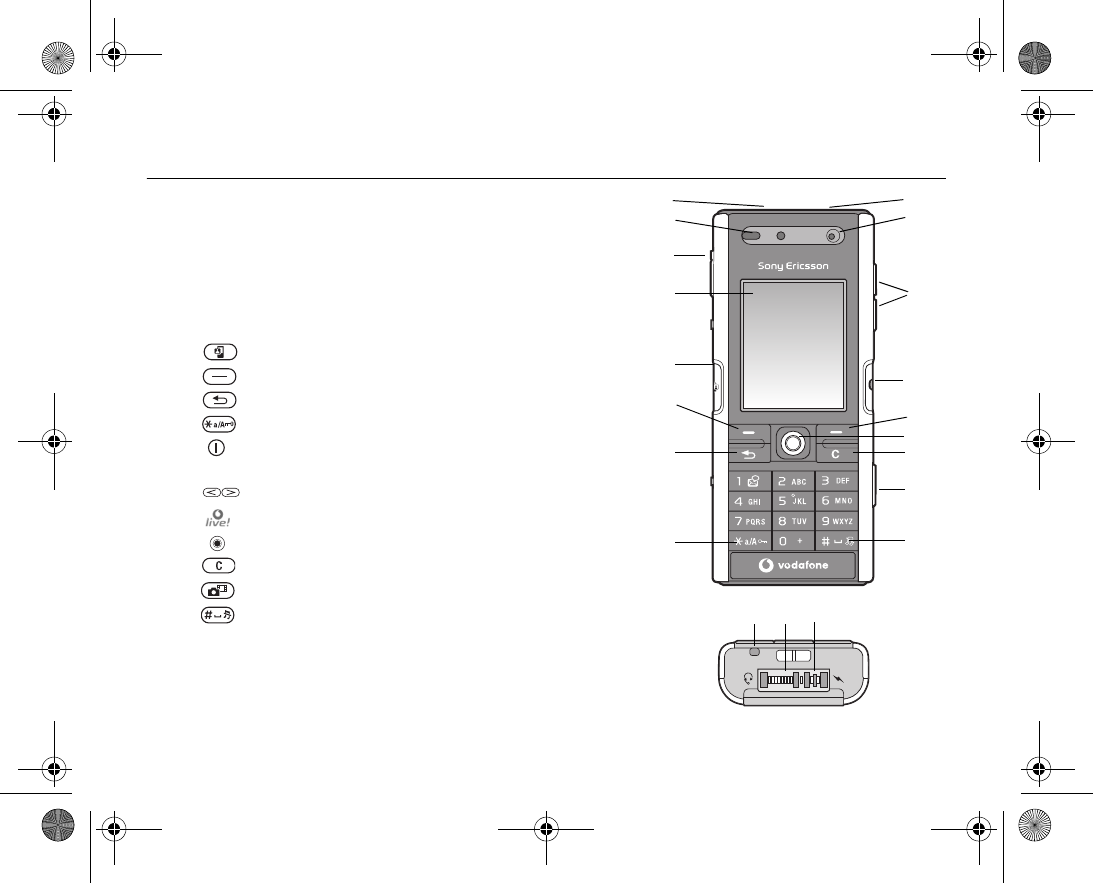
14
Getting to know your phone 2.1
Phone overview
For more information on keys and navigation, %
19 Keys and navigation
.
1 Infrared port
2 Ear speaker
3 USB port
4 Screen
5 Video call key
6,13 Selection keys
7 Back key
8 Photo light key
9 Power on/off button
10 Video call camera
11 Camera zoom, volume buttons
12 Vodafone Live!
14 Navigation key
15 Clear key
16 Camera button
17 Silent key
18 Microphone
19 Stereo headset
20 Charger connector
9
10
11
12
13
14
15
16
17
1
2
3
4
5
6
7
8
18 19 20
VF_Nanami_UG_R1A.book Page 14 Tuesday, June 14, 2005 10:00 AM
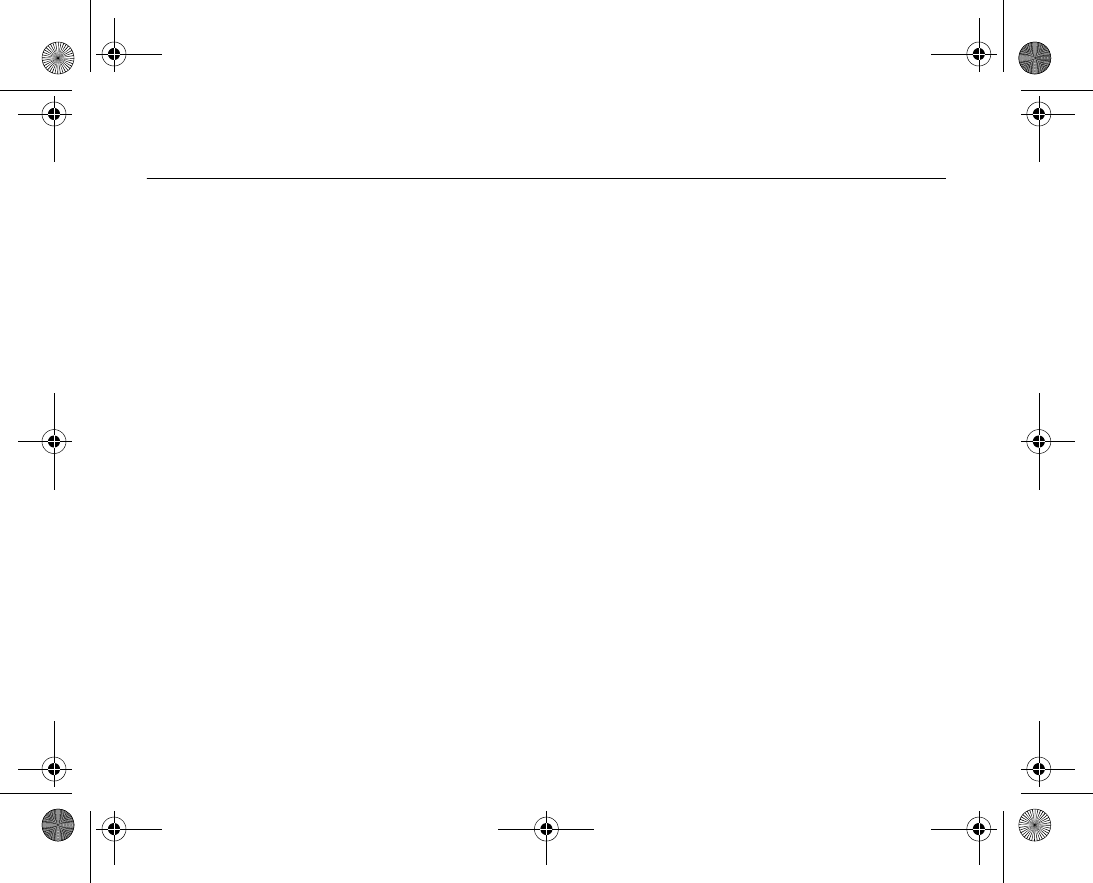
15
2.2 Menu overview
1. Entertainment
Games
VideoDJ™
PhotoDJ™
MusicDJ™
Record sound
2. Vodafone live!*
3. Media Player
4. Camera
5. Messaging
Create new
Inbox
Drafts
Outbox
Sent messages
Messenger
Call voicemail
Email
Saved messages
Templates
Media Album
Settings
6. My Items
Pictures
Videos
Sounds
Themes
Web pages
Games
Applications
Other
7. Organiser & Tools
Online services**
Applications
Alarm
Calendar
Tasks
Notes
Light
Remote control
Timer
Stopwatch
Calculator
Code memo
8. Contacts
Options:
Speed dial
Contacts
My business card
Groups
SIM contacts
Special numbers
Advanced
New contact
9. Online services**/
Alarms
10. Radio
11. Calls
12. Settings
General
Profiles
Time & date
Language
Voice control
New events
Phone status
Shortcuts
Startup menu
Locks
Setup wizard
Tips and tricks
Master reset
Sounds & alerts
Ring volume
Ringtone
Silent mode
Increasing ring
Vibrating alert
Message alert
Key sound
Display
Wallpaper
Themes
Startup screen
Screen saver
Brightness
Sleep mode clock
Edit line names**
Calls
Divert calls
Switch to line 1/Switch to line 2**
Manage calls
Time & cost
Show or hide no.
Handsfree
Connectivity
Bluetooth
Infrared port
Synchronization
Device mgmt.
Mobile networks
Data comm.
Internet settings
Streaming settings
Settings for Java™
Accessories
* Vodafone! live. Offline webpage with direct links to online services.
**This service is not available in all countries.
VF_Nanami_UG_R1A.book Page 15 Tuesday, June 14, 2005 10:00 AM
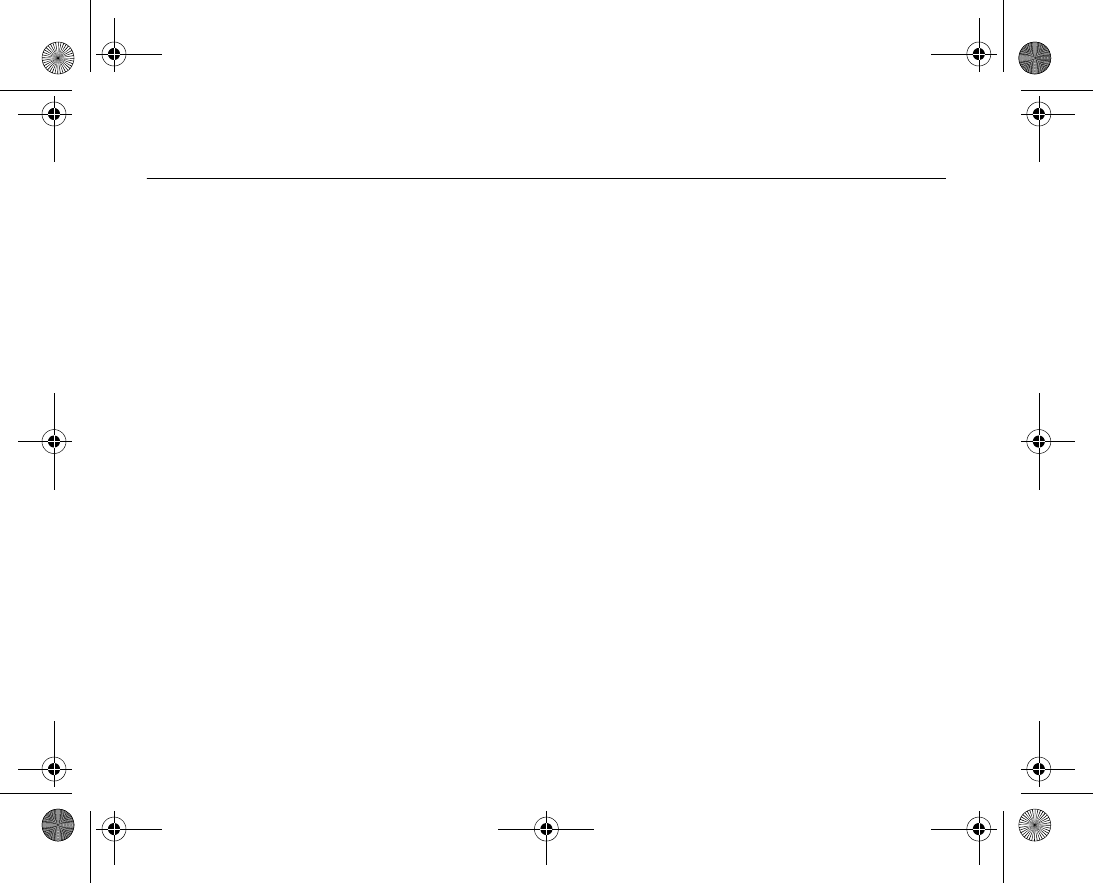
16
Getting started 2.3
Assembling the phone
Before you can use your phone you need to:
• Insert the SIM card.
• Attach and charge the battery.
SIM card
When you register as a subscriber with Vodafone, you get a SIM (Subscriber Identity
Module) card. The SIM card contains a computer chip that keeps track of your phone
number, the services included in your subscription, and names and numbers in your
contacts, among other things.
Note:
If you have been using a SIM card in another phone, make sure that your information is
saved to the SIM card before you remove it from the other phone. For example, contacts
may have been saved in the phone memory.
SIM card and battery information
Always turn off the phone and detach the charger before you insert or remove a SIM
card.
Note:
It may take up to 30 minutes before the battery icon appears when charging.
VF_Nanami_UG_R1A.book Page 16 Tuesday, June 14, 2005 10:00 AM
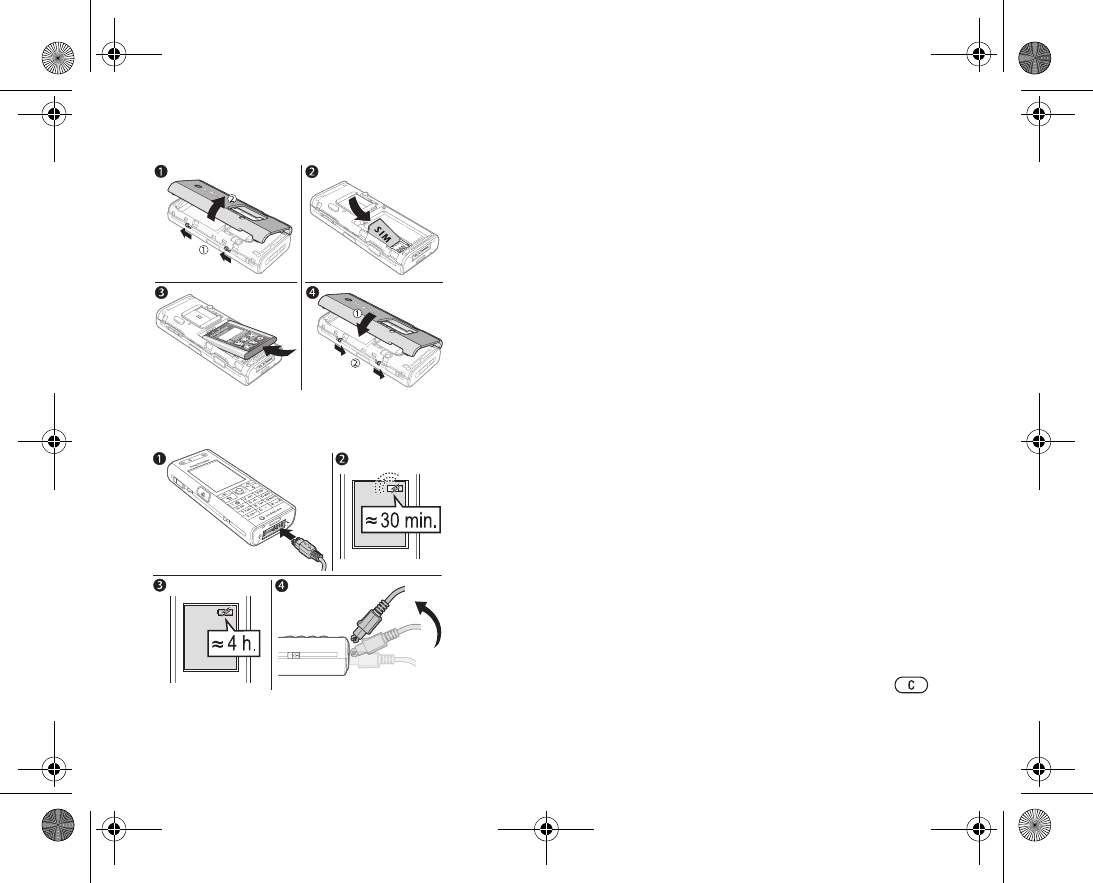
17
To insert SIM card and battery
1. Remove the battery cover by sliding the two catches on the side of the phone and
lifting it away as shown in the picture.
2. Slide the SIM card into its holder. Make sure that the gold contacts of the SIM card
are facing down, and the cut off corner is correctly aligned.
3. Place the battery on the back of the phone with the label side up and the connectors
facing each other.
4. Place the battery cover as shown in the picture and slide the two catches back into
place.
To charge the battery
1. Connect the charger to the phone. The symbol on the charger plug must face
upwards.
2. It may take up to 30 minutes before the battery icon appears on the screen.
3. Wait approximately 4 hours or until the battery icon indicates that the battery is fully
charged. If you do not see the battery icon after this time, press a key to activate the
screen.
4. Remove the charger by tilting the plug upwards.
PIN (Personal Identification Number)
You may need a PIN (Personal Identification Number) to activate the services in your
phone. The PIN is associated with your SIM card, and not with the phone. Your PIN is
provided by Vodafone. When you enter your PIN, each digit appears as *, unless your
PIN starts with the same digits as an emergency number, for example 112. This is so
that you can see and call an emergency number without entering a PIN.
If you make a mistake while entering your PIN, delete the number by pressing .
VF_Nanami_UG_R1A.book Page 17 Tuesday, June 14, 2005 10:00 AM
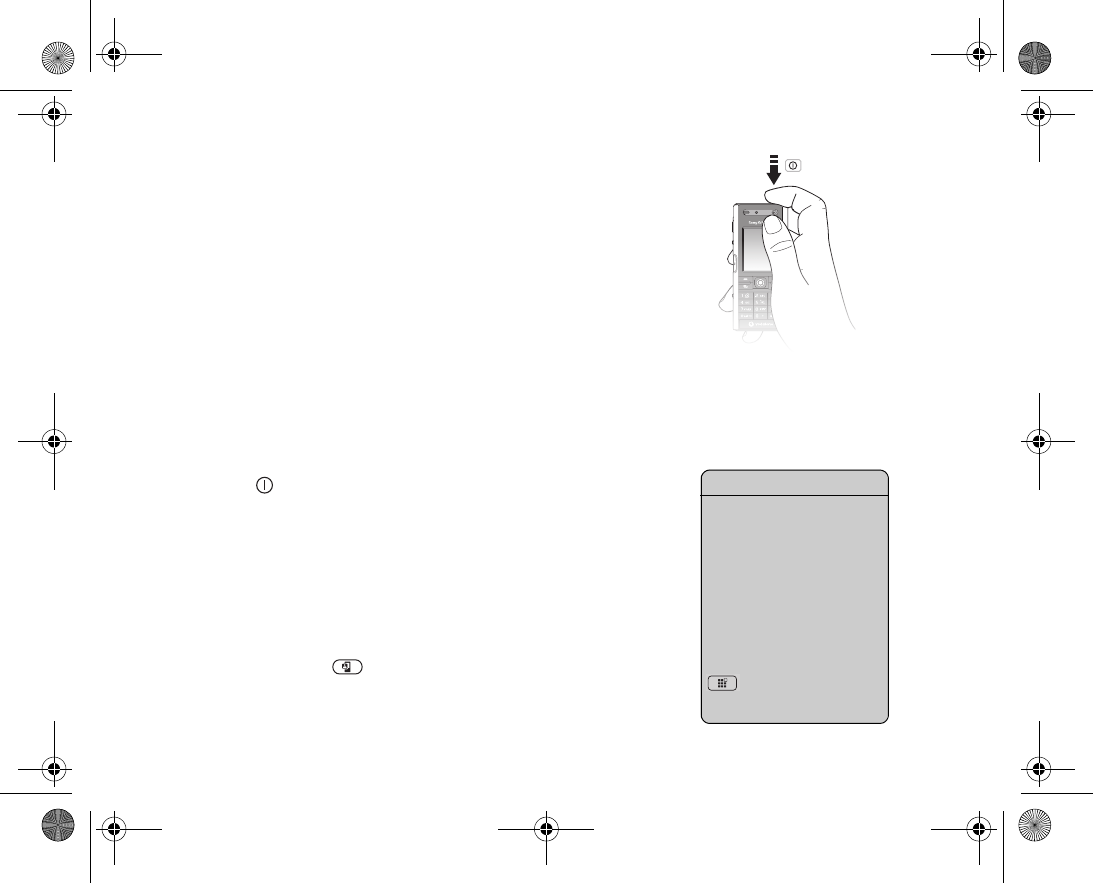
18
Note:
If you enter the wrong PIN three times in a row, the SIM card is blocked and the mes
sage PIN blocked appears. To unblock it, you need to enter your PUK (Personal Unblock
ing Key),
%
127 SIM card lock.
Available Services
Some services and functions described in this user guide are network or subscription
dependent. Because of this, all menus may not be available in your phone. Please con
sult Vodafone Customer Care for more information about your subscription.
Turning on the phone and making calls
Make sure that the phone is charged and your SIM card is inserted before you turn it on.
When you have turned the phone on, you can use the setup wizard to quickly and easily
prepare your phone for use.
To turn on the phone
1. Press and hold .
2. Enter your SIM card PIN, if requested.
3. At first startup, select the language you want for your phone menus.
4. }Yes if you want the setup wizard to help you get started, and follow the instructions
that appear. You can start the wizard from the menu system at any time, } Settings
} the General tab } Setup wizard.
To make and receive calls
Enter the phone number (with international prefix and area code if applicable) } Call to
make the call, or press and hold to make a video call. } End call to end the call.
When the phone rings } Answer.
Setup wizard
You can use the setup wizard
to help you get started with the
basic settings in your phone.
The wizard also gives you tips
on how to use the keypad.
You can start the wizard from
the menu system at any time.
} Settings } the Gen
eral tab } Setup wizard.
VF_Nanami_UG_R1A.book Page 18 Tuesday, June 14, 2005 10:00 AM
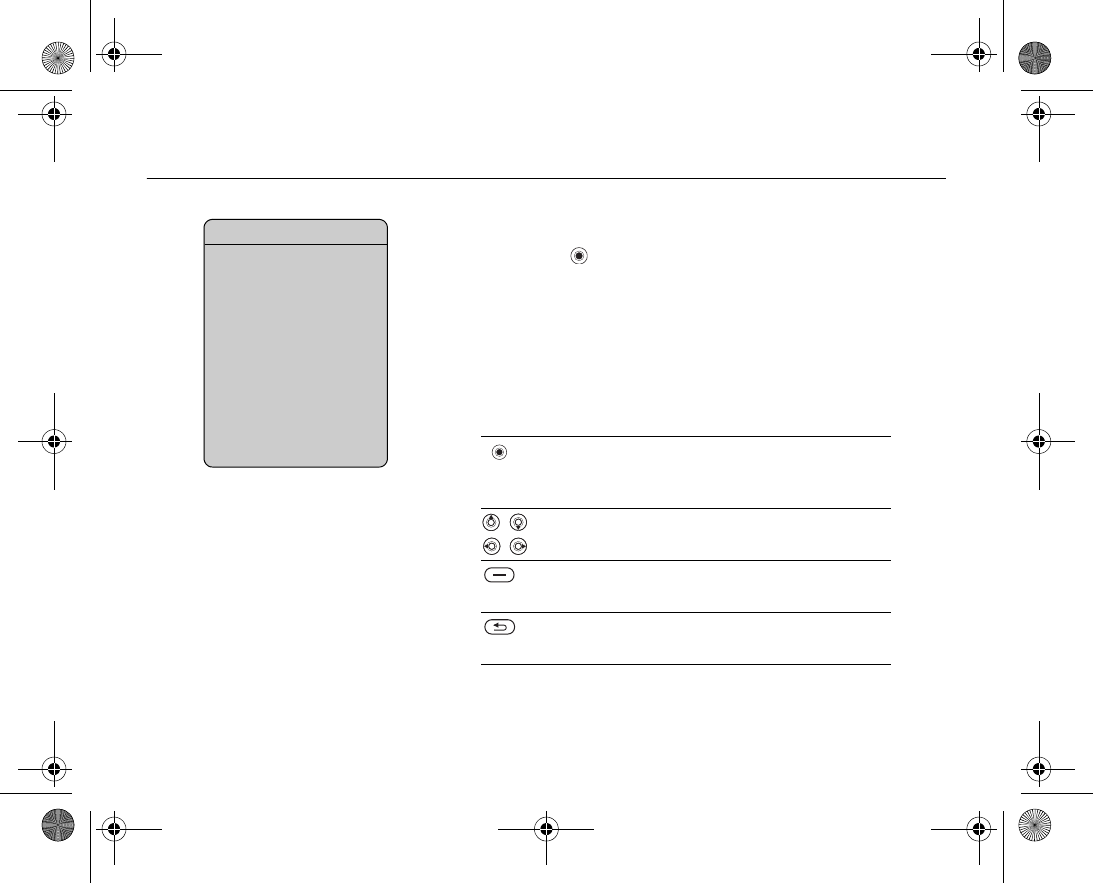
19
Keys and navigation 2.4
Standby screen and main menu and status bar
From standby, press to enter the
main menu
, where the menus are shown as icons.
Some submenus include tabs. Scroll to a tab using the navigation key and select an
option.
The status bar at the top of the screen contains icons, which give information related to
the phone and its activities, %
154 List of icons shown in standby
.
Keys and buttons
Press to enter the main menu from standby.
Press to select highlighted items.
During a call, press to view a list of options.
Move through menus and tabs.
Press to select the options shown immediately above
these keys on the screen.
Press to go back one level in the menus.
Press and hold to return to standby or end a function.
What is the standby screen?
The
standby screen
is dis
played when you are not call
ing or using the menus. This is
where you can see, for exam
ple, the name of your opera
tor, the time and the date. At
the top of the standby screen
you find the status bar.
VF_Nanami_UG_R1A.book Page 19 Tuesday, June 14, 2005 10:00 AM
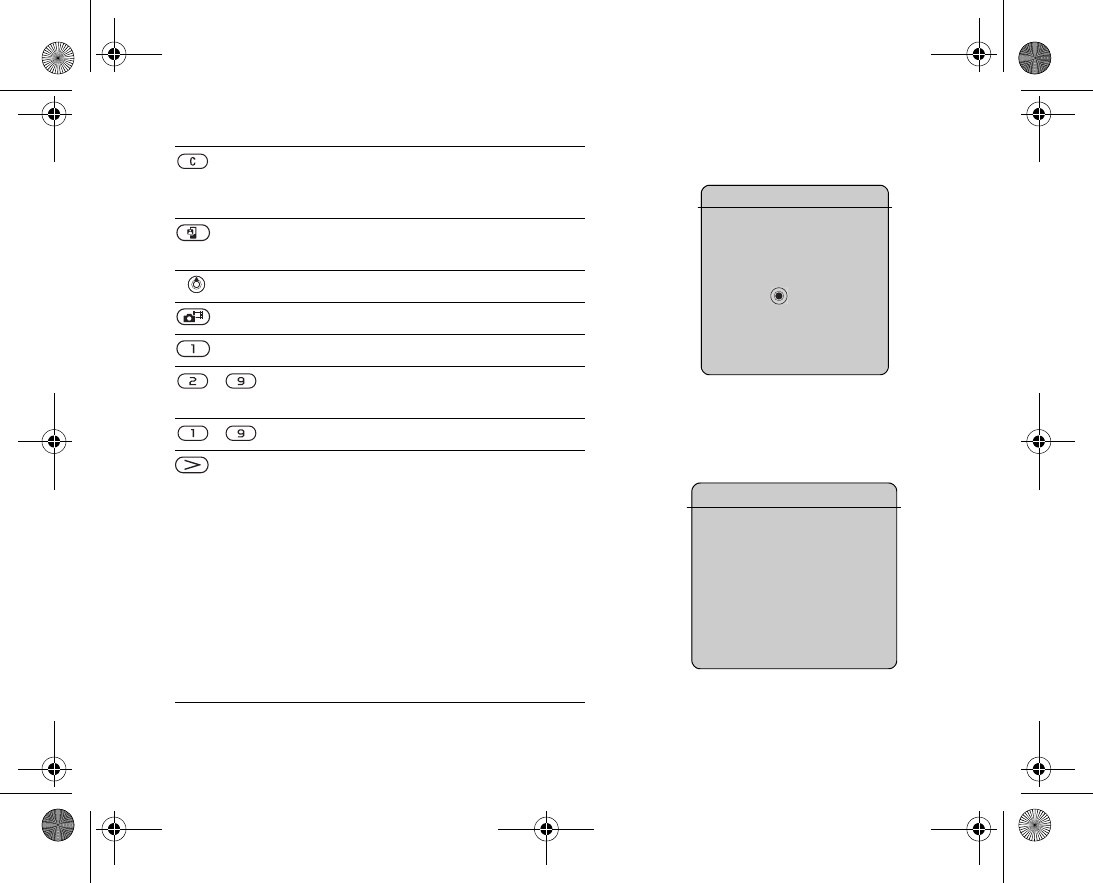
20
Press to delete items, such as pictures, sounds and
contacts.
During a call, press and hold to mute the microphone.
Press and hold to make a video call or to enter video
call mode.
Press to open the activity menu, %
55 Activity menu
.
Press to take a picture or to record a video clip.
Press and hold to call your voicemail service (if set).
Press and hold any of these keys to reach a contact
beginning with a specific letter.
Press any of these keys and press Call to speed dial.
In standby, press to view status information.
To reject a call, quickly press twice when receiving a
call.
Press once to turn off the ringtone when receiving a
call.
During a call, press to increase the volume.
When using the media player (also when minimized),
press to increase the volume. Press and hold to go
back one track.
When using the camera, press to zoom in.
Press and hold to voice dial, alternatively say your
magic word (if set), %
44 Voice dialling
.
What is the desktop?
The desktop is where all the
main menu icons are. From
standby you reach the desktop
by pressing . At the top of the
desktop you find the status bar.
More options
When in the menus, } More to
enter a list of options.
There are different alternatives in
the list of options depending on
where you are in the menus.
VF_Nanami_UG_R1A.book Page 20 Tuesday, June 14, 2005 10:00 AM
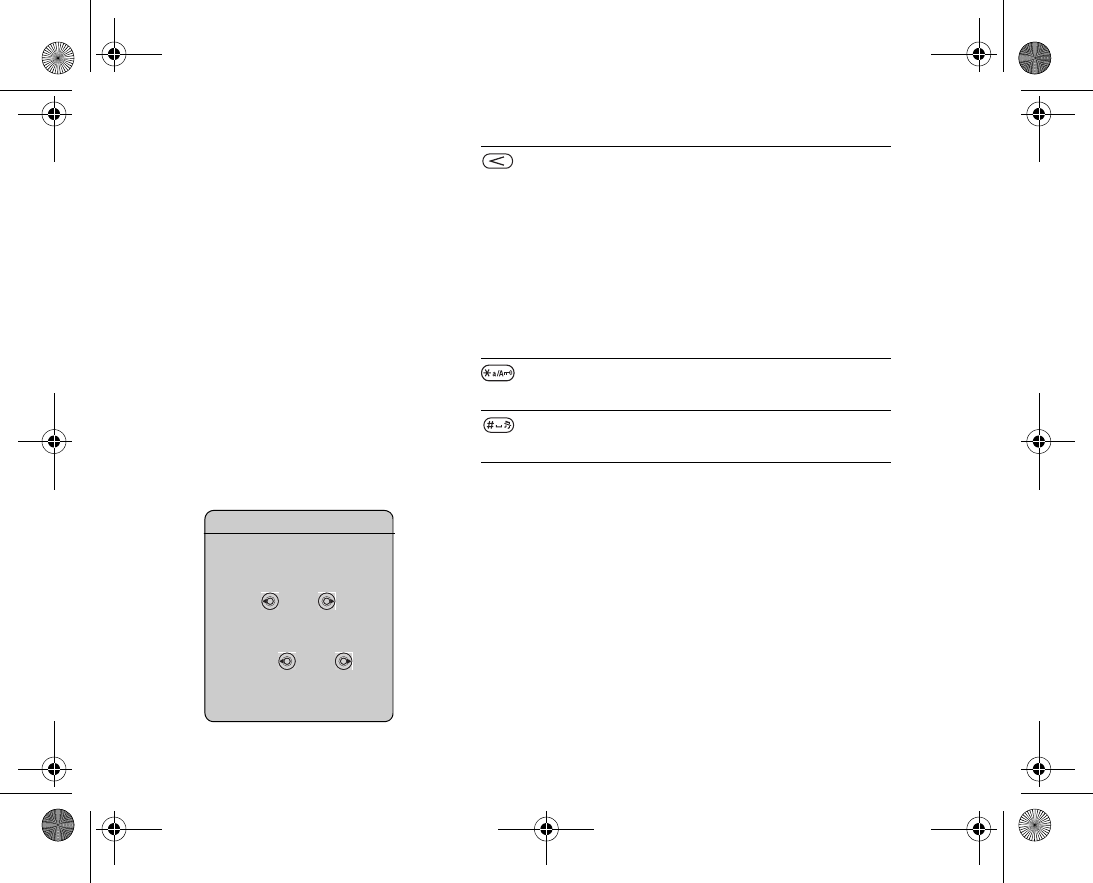
21
Phone language
Most SIM cards automatically set the language used in the menu to the language of the
country where you bought your SIM card. If this is not the case, the predefined lan
guage is English.
To change the phone language
1. } Settings } the General tab } Language } Phone language.
2. Select a language.
In standby, press to view status information.
To reject a call, quickly press twice when receiving a
call.
Press once to turn off the ringtone when receiving a
call.
During a call, press to decrease the volume.
When using the media player (also when minimized),
press to decrease the volume. Press and hold to go
forward one track.
When using the camera, press to zoom out.
When using the camera, press to turn on the photo
light.
Press and hold to set the phone to silent. Press once to
turn off the ringtone when receiving a call.
Getting back to your language
You can always choose lan
guage according to SIM by
pressing 8888 in
standby.
You can always choose English
by pressing 0000 in
standby
VF_Nanami_UG_R1A.book Page 21 Tuesday, June 14, 2005 10:00 AM
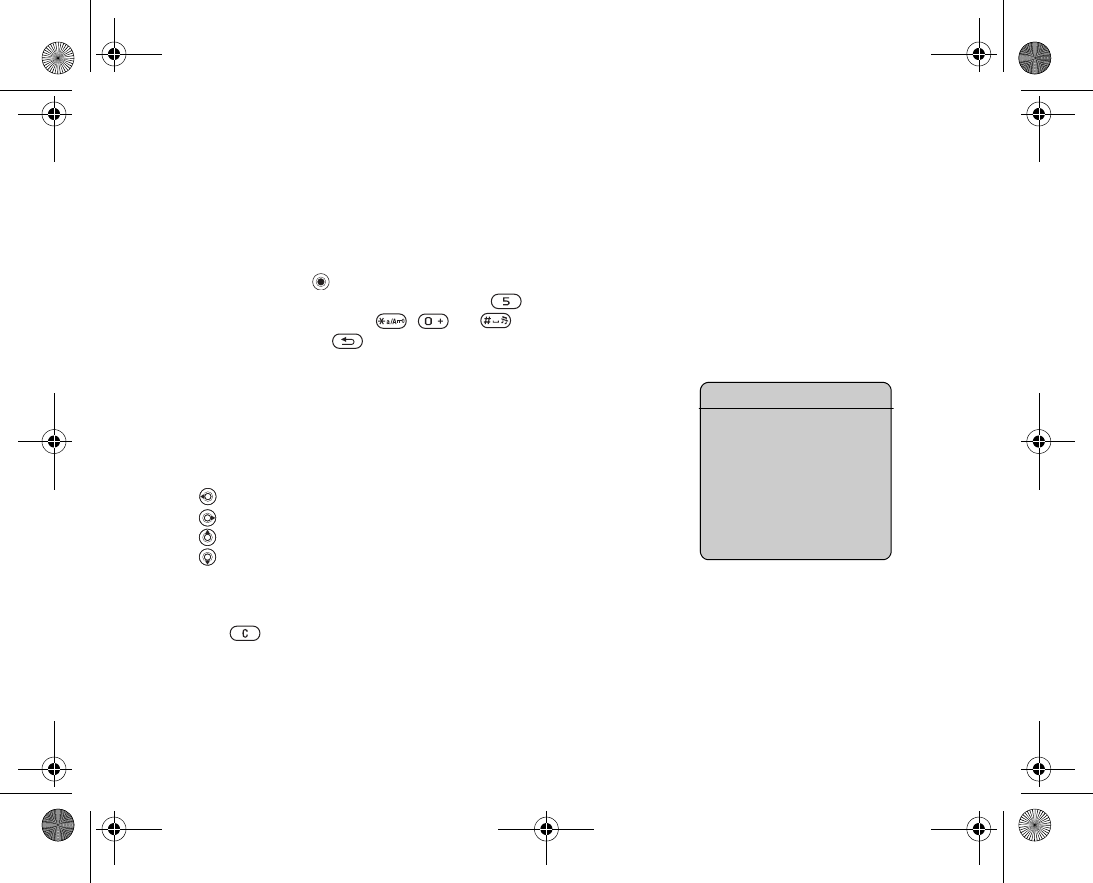
22
Shortcuts
A quicker way to move through the menus is to use shortcuts. You can use desktop
shortcuts to quickly go to a menu, and you can use predefined standby shortcuts to
quickly reach certain functions.
Using desktop shortcuts
Enter the menus by pressing and then enter the number of the menu to which you
want to go. For example, to reach the fifth menu item, press . To reach the tenth,
eleventh and twelfth menu items, press , and respectively. To go
back to standby, press and hold .
Using standby shortcuts
You can use the predefined shortcuts and use the navigation keys to go directly to that
function in standby.
Predefined standby shortcuts
In your Vodafone live! phone, the following shortcuts are predefined in standby:
• Press to use Create new message.
• Press to use Calendar.
• Press to go to Activity menu.
• Press to use Contacts.
To edit a standby shortcut
} Settings } the General tab } Shortcuts and select which shortcut you want to edit
} Edit. Press if you want to delete the shortcut.
Getting help
More information, explanations
or tips about selected features,
menus or functions available in
your phone.
Scroll to a menu item }Info.
VF_Nanami_UG_R1A.book Page 22 Tuesday, June 14, 2005 10:00 AM
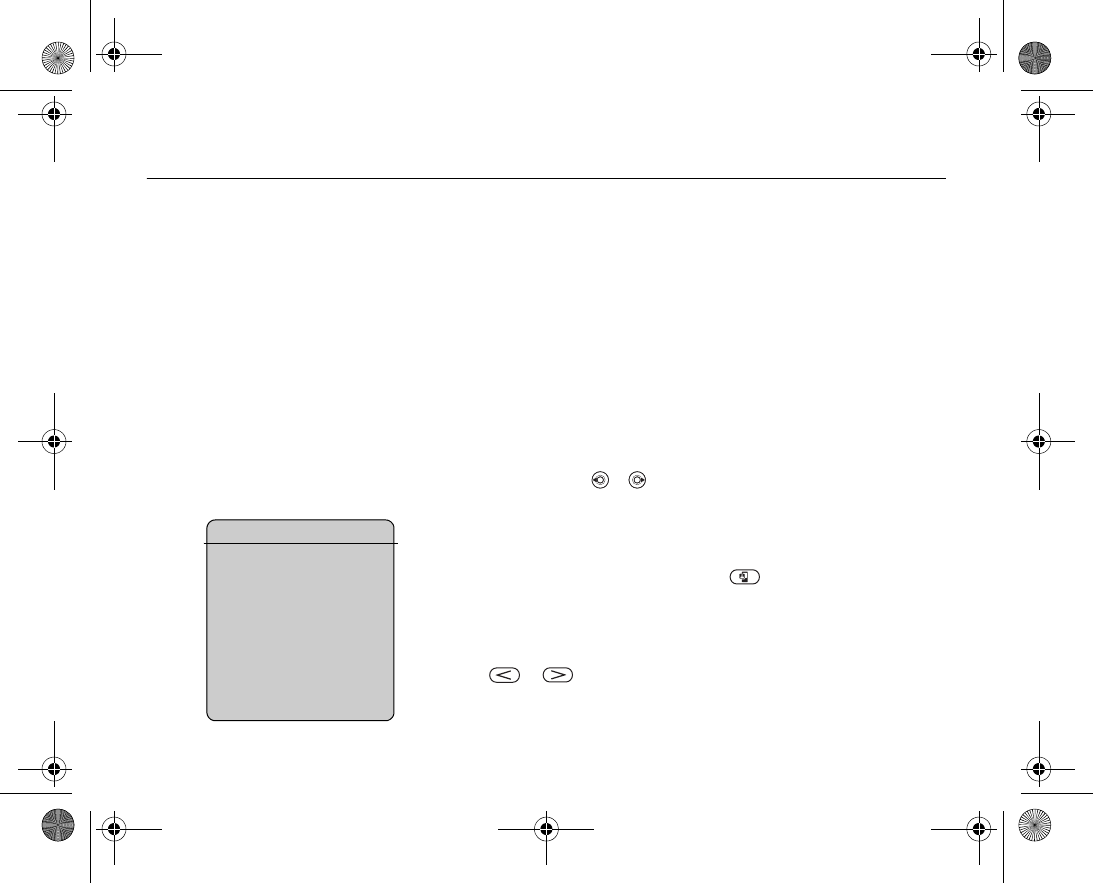
23
2.5 Calling
Making calls
Before you can make or receive any calls, you must turn on the phone and be within
range of a network. %
18 Turning on the phone and making calls
. To make a video call,
%
27 Video call
.
Networks
When you turn on the phone, it automatically selects your home network if this is within
range. If it is not within range, you may use another network, provided Vodafone has an
agreement that allows you to do so. This is called roaming.
You can select the network you want to use, or you can add a network to your list of
preferred networks. You can also change the order in which networks are selected dur
ing an automatic search. For all such options } Settings } the Connectivity tab }
Mobile networks. Use or to scroll between the tabs.
To make a call
1. Enter the phone number (with international country code and area code if applica
ble).
2. } Call to make a voice call, or press and hold to make a video call. } More to
view options.
3. } End call to end the call.
To change the ear speaker volume
Press or to increase or decrease the ear speaker volume during a call.
More ways of making calls
You can call numbers from the
call list and contacts, %
41 Call
list
, and %
35 Contacts
. You can
also use your voice to make
calls, %
44 Voice control
.
VF_Nanami_UG_R1A.book Page 23 Tuesday, June 14, 2005 10:00 AM
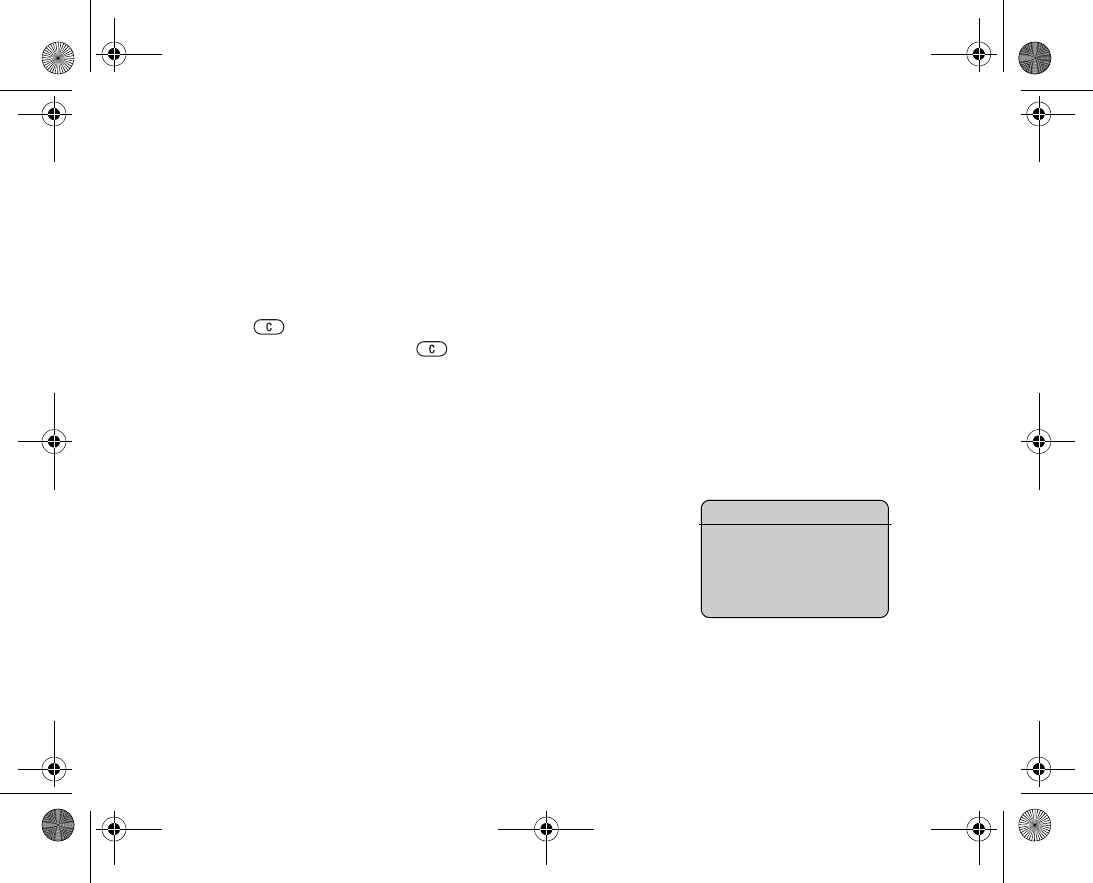
24
To use the loudspeaker during a voice call
1. } More } Turn on speaker to turn on the loudspeaker.
2. } More } Turn off speaker to turn off the loudspeaker.
Note:
Do not hold the phone to your ear while using the loudspeaker. This could damage your
hearing.
To turn off the microphone
1. Press and hold .
2. To resume the conversation, press and hold again.
Receiving calls
When you receive a call, the phone rings and the caller’s number is displayed (if your
subscription includes the Calling Line Identification service and the caller’s number is
identified).
If the number is in your contacts, the name, number, and picture (if assigned) are dis
played. If the number is a restricted number, Withheld is displayed.
To answer a call
} Answer.
To reject a call
} Busy or quickly press a volume button twice.
Missed calls
If you have missed a call, and if New events is set to Activity menu, the missed call
appears in the Activity menu. } Call to call the missed number.
Voice control
You can use your voice to
answer or reject calls, %
46
Voice answering
VF_Nanami_UG_R1A.book Page 24 Tuesday, June 14, 2005 10:00 AM
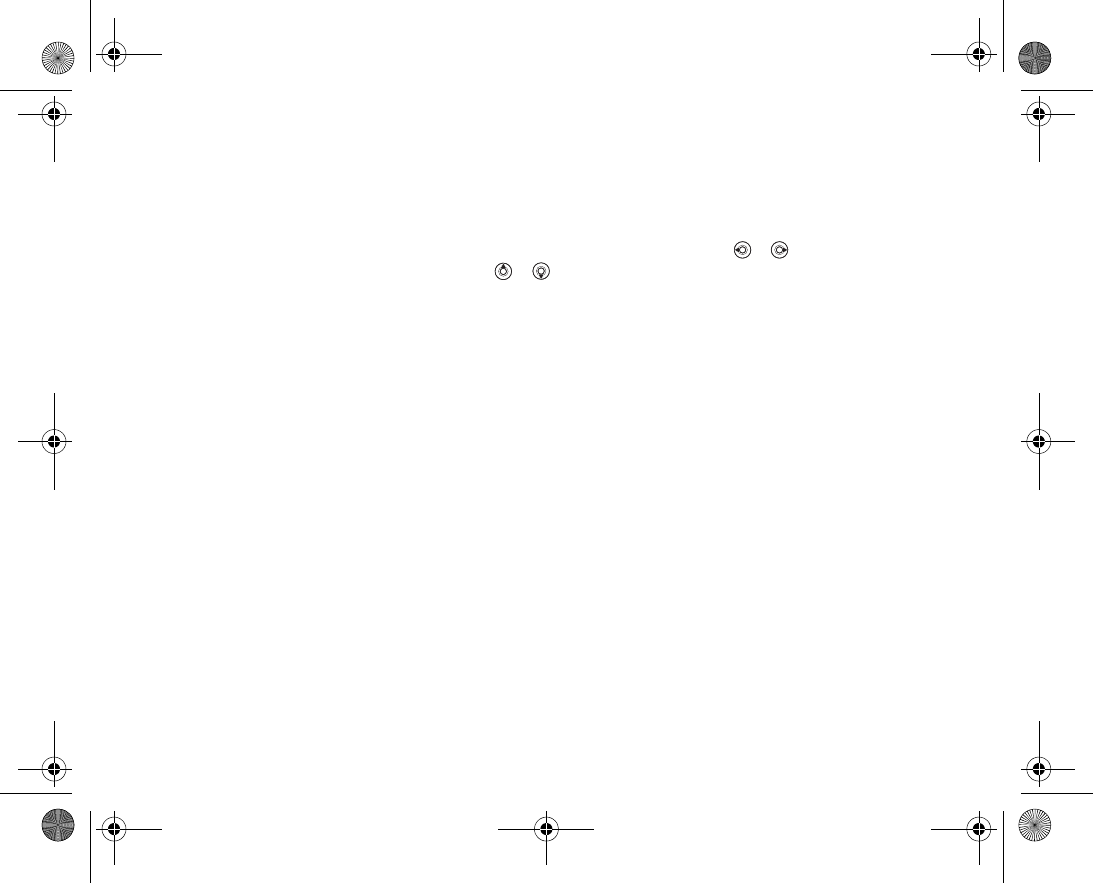
25
If New events is set to Popup, Missed calls: appears, indicating the number of
missed calls. To view the missed calls in the call list } Yes. If you want to view the
missed calls later } No.
To check your missed calls
1. From standby } Calls } the Missed tab. Use or to scroll between the tabs.
2. Use or to scroll to a number and } Call to call a number.
Automatic redialling
To redial a number
If the connection of the call failed and Retry? is displayed } Yes.
Note:
Do not hold the phone to your ear while waiting. When the call is connected, the phone
gives a loud signal.
The phone redials the number up to ten times or until:
• The call is connected
• You press Cancel
• You receive a call
Automatic redialling is not available for data calls.
Making international calls
When you make an international call, the + sign replaces the international prefix
number of the country from which you are calling. You can make a call from abroad,
using another network, provided Vodafone has an agreement with that network.
VF_Nanami_UG_R1A.book Page 25 Tuesday, June 14, 2005 10:00 AM
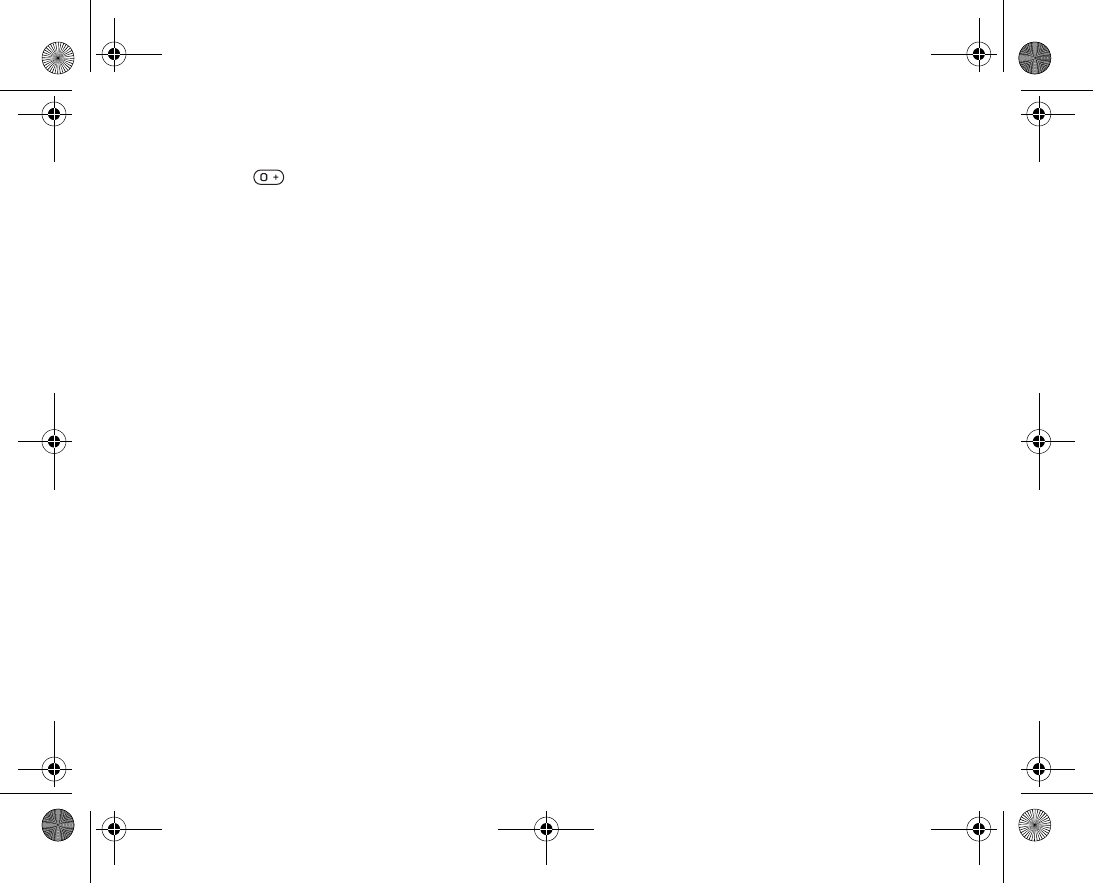
26
To make international calls
1. Press and hold until a + sign appears on the screen.
2. Enter the country code, area code (without the leading zero) and phone number }
Call.
Emergency calls
Your phone supports the international emergency numbers, for example, 112 and 911.
This means that these numbers can normally be used to make an emergency call in any
country, with or without a SIM card inserted, if a 3G (UMTS) or GSM network is within
range.
Note:
In some countries, other emergency numbers may also be promoted. Vodafone may
therefore have saved additional local emergency numbers on the SIM card.
To make an emergency call
Enter, for example, 112 (the international emergency number) } Call.
To view your local emergency numbers
} Contacts } Options } Special numbers } Emergency nos..
VF_Nanami_UG_R1A.book Page 26 Tuesday, June 14, 2005 10:00 AM
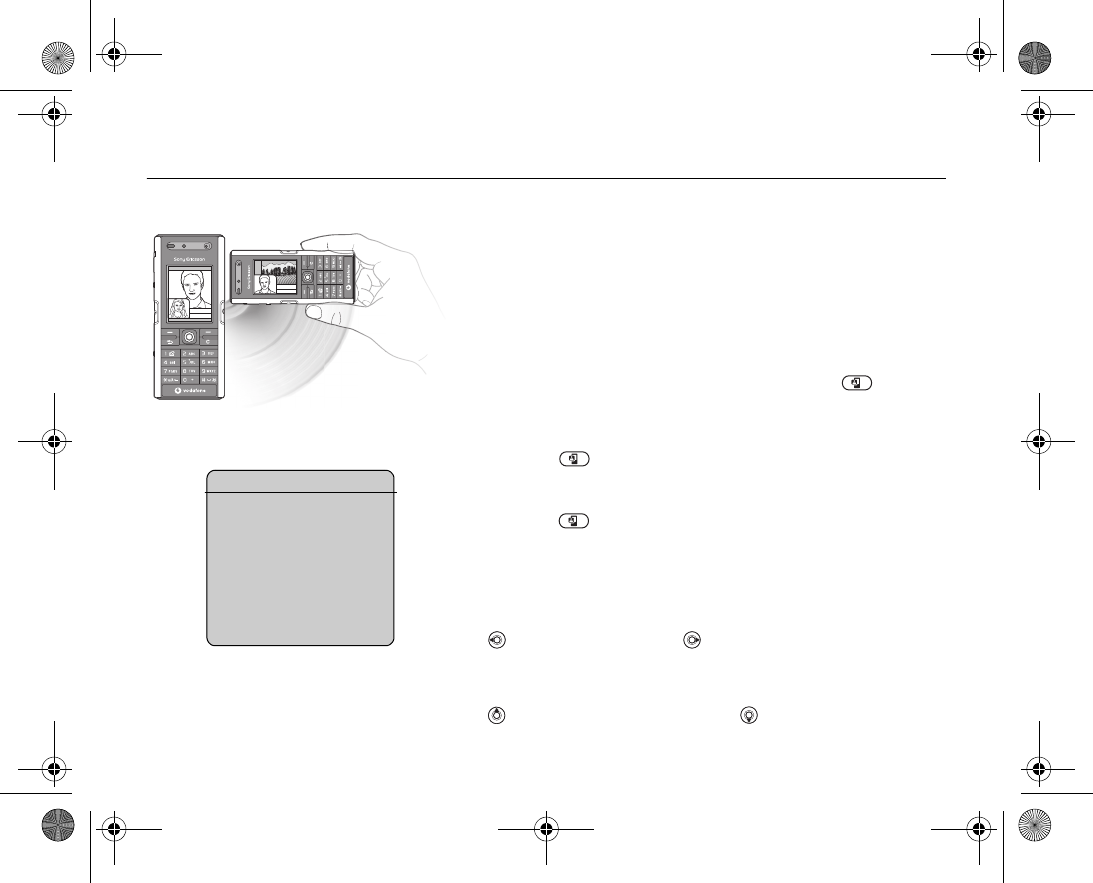
27
2.6 Video call
With video call, you can see the person you are talking to on your screen.
Before you start
To make a video call, both you and the person you are calling need a subscription that
supports the 3G (UMTS) service, and you need to be within range of a 3G (UMTS) net
work. 3G (UMTS) service is available when the 3G icon appears in the status bar.
Video call demo mode
You can use the video call functions without making a call, if you, for example, want to
prepare a view and check how it looks before calling. Press and hold . Most video
call functions are available in the demo mode.
To make a video call
1. Press and hold when 3G (UMTS) service is available.
2. Enter the phone number and press Call. To retrieve a phone number from your con
tacts } Call... } Contacts and scroll to the phone number you want to call } Call or
press and hold .
3. Press Camera or open the lens cover to switch cameras from the front camera to
the back camera. Hold the phone horizontally, so that the person you are talking to
will see the image at a correct angle.
To adjust the brightness of the outgoing video
Press to decrease the brightness, or to increase the brightness of the outgoing
video picture.
To zoom the outgoing video in or out
Press to zoom in the outgoing video and press to zoom out.
3G network icon
When the 3G network icon is
displayed in the status bar at
the top of the screen, you are
able to make and receive video
calls to and from other 3G tele
phones.
VF_Nanami_UG_R1A.book Page 27 Tuesday, June 14, 2005 10:00 AM
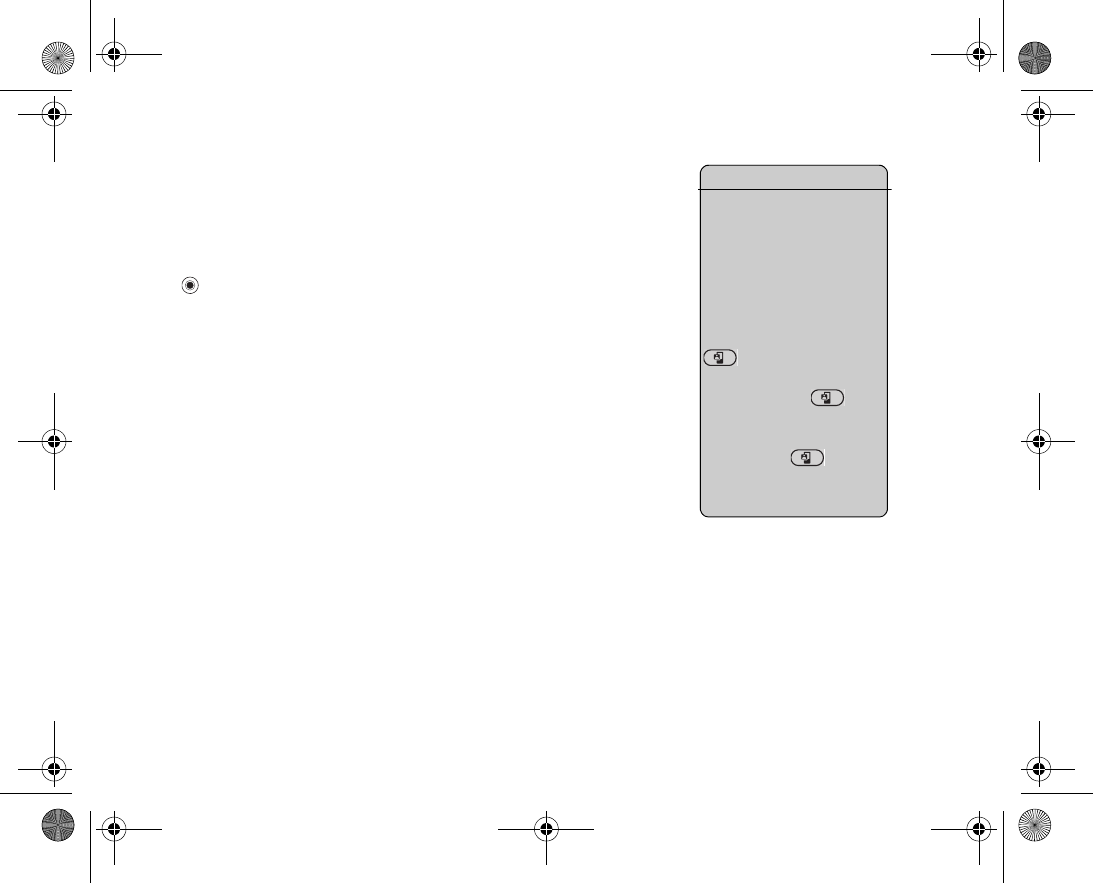
28
To accept an incoming video call
Press Answer.
To end a video call
During an ongoing video call, press End call.
Video call options
Press when using the front camera to view, and select from the following options:
•Stop camera/Start camera – turn off and on the outgoing video camera. An alter
native picture is showed when the camera is off.
•Turn off speaker/Turn on speaker – turn off and on the incoming sound during a
video call.
•Mute microphone/Unmute mic. – turn off and on the microphone during a video
call (this option is available during calls).
•Switch pictures – choose between showing the incoming or the outgoing video in
full size display.
•Hide small pic./Show small pic. – choose if you want to hide or show the small
picture.
•Night mode – use when the lighting conditions are poor. This setting affects the
outgoing video.
•Advanced – to view, and select, the following options:
•Alternative pic. – this picture will be shown to the other party when you have
turned off the camera.
•Answer mode – choose whether the front camera should be on or off when you
answer a video call. If you answer with the front camera turned off, you can easily
turn it on by pressing Camera.
•Camera quality – select what picture quality to use for the outgoing video. This
setting will take effect at the next call – not during an ongoing call.
Video calls
You can also make video calls
from standby or from other
applications, such as contacts
or messages.
In standby, Calls, highlight a
number and press and hold
.
In contacts, highlight a number
a n d p r e s s a n d h o l d .
In a message, highlight a
number in the message and
press and hold .
VF_Nanami_UG_R1A.book Page 28 Tuesday, June 14, 2005 10:00 AM

29
•Mirror image – you will see a mirror image of the outgoing video. If you turn mir
ror image on, you will see yourself as you would in a mirror. The other party will
see the picture nonmirrored.
•Contacts – select a contact to view during an ongoing call – useful, for example,
when you want to check a number or an email address for a contact (this option is
visible during calls).
•Transfer sound – transfer the sound to and from handsfree equipment using
Bluetooth.
•Demo clip – turn demo clip on or off.
VF_Nanami_UG_R1A.book Page 29 Tuesday, June 14, 2005 10:00 AM
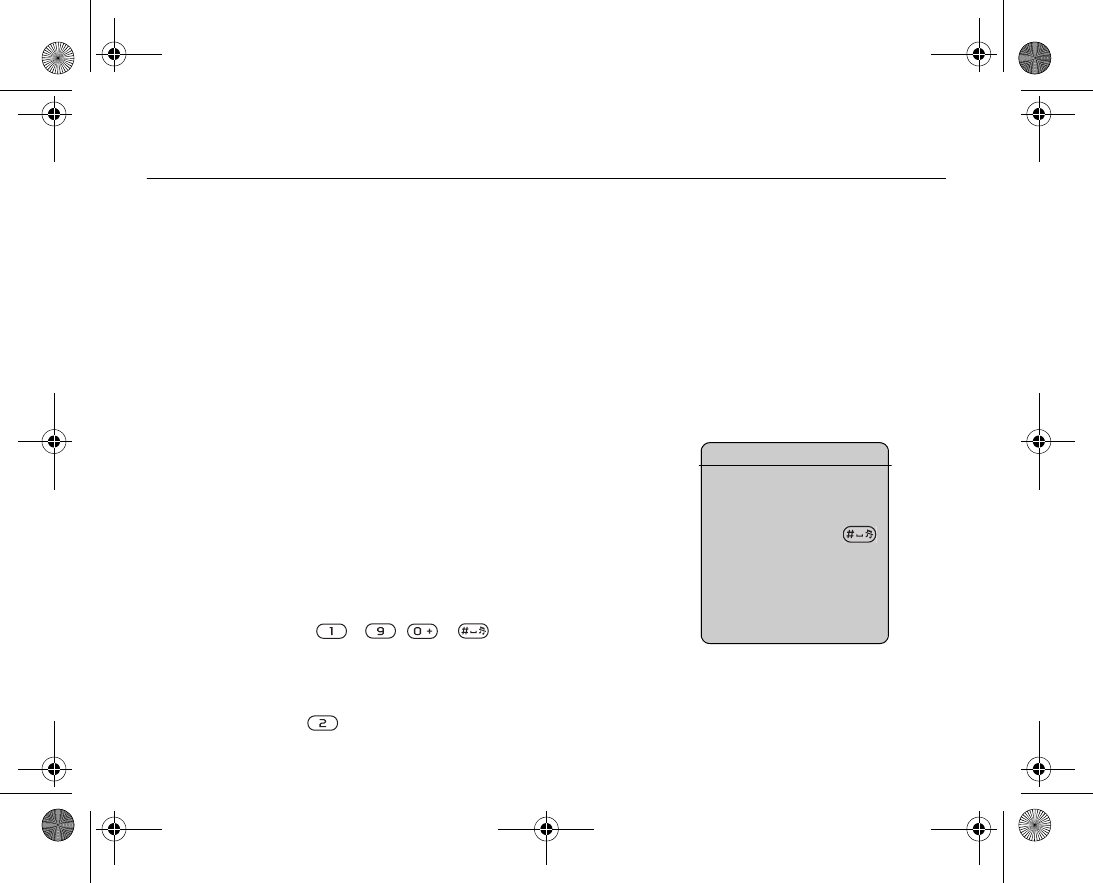
30
Entering letters 2.7
There are two ways of entering letters, for example, when writing a message or writing
a name in contacts:
• Multitap text input
You press each key as many times as needed to show the letter you want.
• T9™ Text Input
The T9 Text Input method uses a builtin dictionary to recognize the most commonly
used word for each sequence of key presses. This way, you press each key only
once, even if the letter you want is not the first letter on the key.
Writing languages
Before you start entering letters, you need to select the languages that you want to use
when writing.
To select writing language
1. } Settings } the General tab } Language } Writing language.
2. Scroll to each language that you want to use and mark it. } Save to exit the menu.
To enter letters using multitap text input
1. To enter text, you have to be in a function where text input is possible, for example }
Messaging } Create new } SMS.
2. Press the appropriate key, – , or , repeatedly until the char
acter you want appears on the screen. You can see which characters you can choose
in the box in the top right corner of the screen.
Example:
• To enter an ‘A’, press once.
Switching writing language
When writing, you can switch to
one of your selected languages
by pressing and holding .
VF_Nanami_UG_R1A.book Page 30 Tuesday, June 14, 2005 10:00 AM
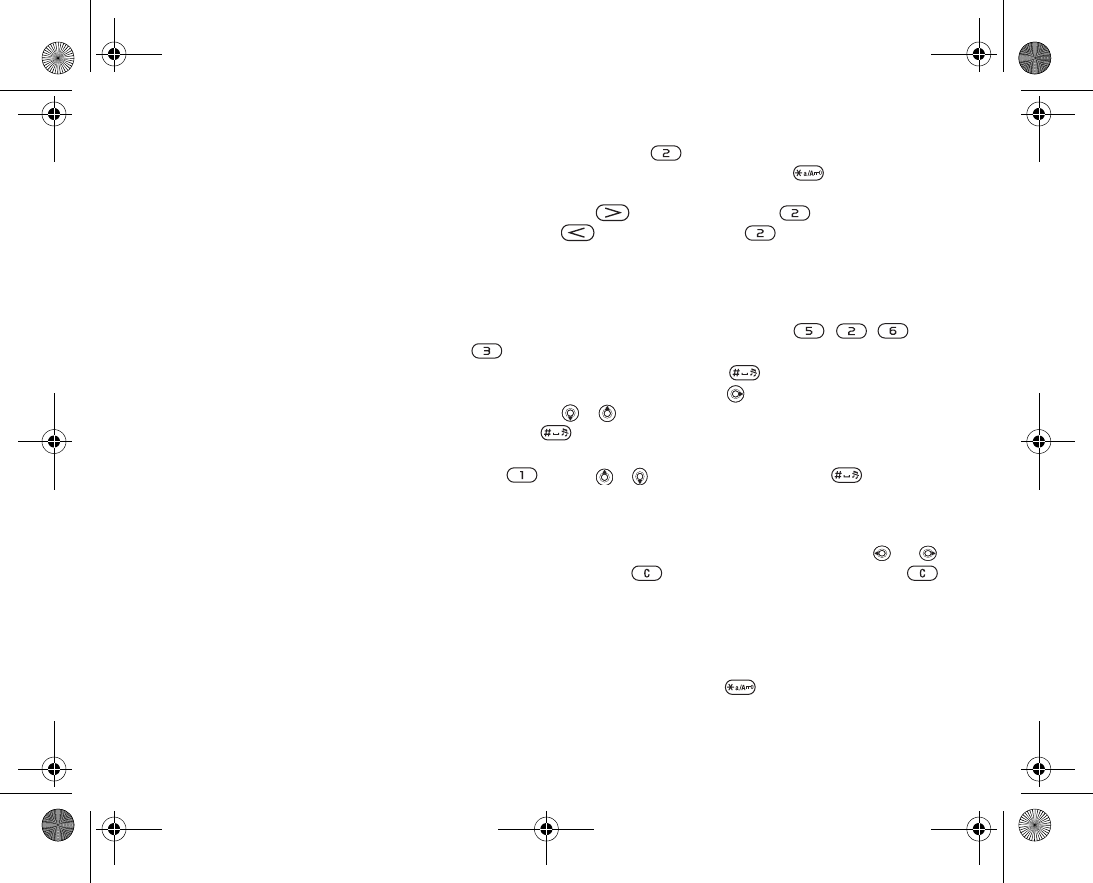
31
• To enter a ‘B’, quickly press twice.
• To shift between capital and lowercase letters, press , then enter the letter.
• You can use the volume buttons as a shortcut to certain letters. To enter a ‘B’,
press and hold the volume button and press . To enter a ‘C’, press
and hold the volume button and press .
To enter letters using T9™ Text Input
1. To enter text, you have to be in a function where text input is possible, for example }
Messaging } Create new } Text message.
2. For example, if you want to write the word “Jane”, press , , ,
.
3. If the word shown is the one you want, press to accept and add a space. To
accept a word without adding a space, press . If the word shown is not the one
you want, press or to view alternative words. Accept a word and add a space
by pressing .
4. Continue writing your message. To enter a full stop or other punctuation marks,
press and then or repeatedly. Accept by pressing .
To add words to the T9 Text Input dictionary
1. While entering letters } More } Spell word.
2. Edit the word by using multitap input. Navigate between the letters with and .
To delete a character, press . To delete the entire word, press and hold .
3. When you have edited the word } Insert. The word is added to the T9 Text Input
dictionary. Next time you enter this word using T9 Text Input, it will appear as one of
the alternative words.
To select another writing method
Before, or while entering letters, press and hold to select another writing method.
VF_Nanami_UG_R1A.book Page 31 Tuesday, June 14, 2005 10:00 AM
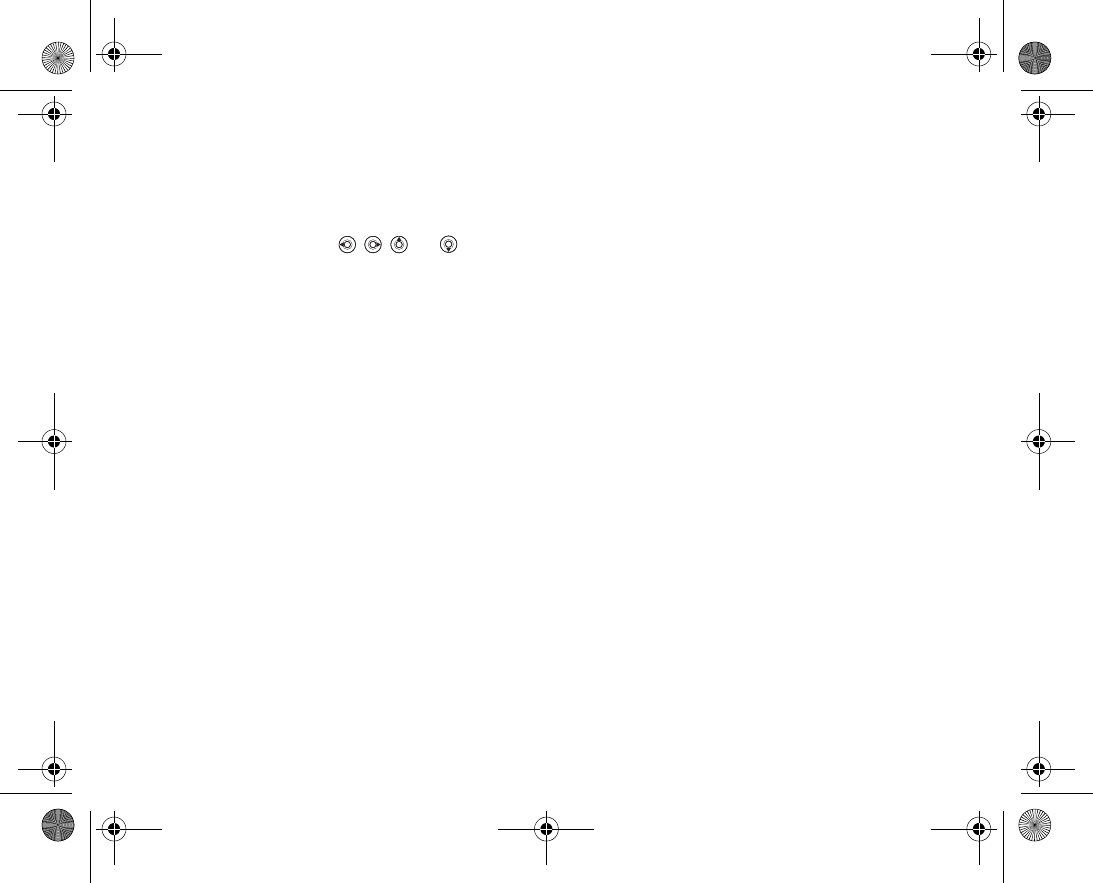
32
Options list
Before, or while entering letters, } More to view a list of options. The list may contain
some or all of the following:
•Add symbol – symbols and punctuation marks such as
?
and
,
are shown. Move
between the symbols by using , , and .
•Add item – pictures, melodies, sounds, templates and animations.
•Spell word – for T9 Text Input only. Edit the suggested word by using multitap text
input.
•Writing language – a list of available languages is shown.
•Writing method – a list of methods available for the current language is shown.
•Dictionary (T9) – turn T9 Text Input dictionary on or off.
•Word suggestions – select to view, or not, word suggestions when writing a word.
•My words – manage the words that you have added to the dictionary.
•National chars. – Turn off languagespecific characters to save space. This option
appears only for some writing languages.
VF_Nanami_UG_R1A.book Page 32 Tuesday, June 14, 2005 10:00 AM
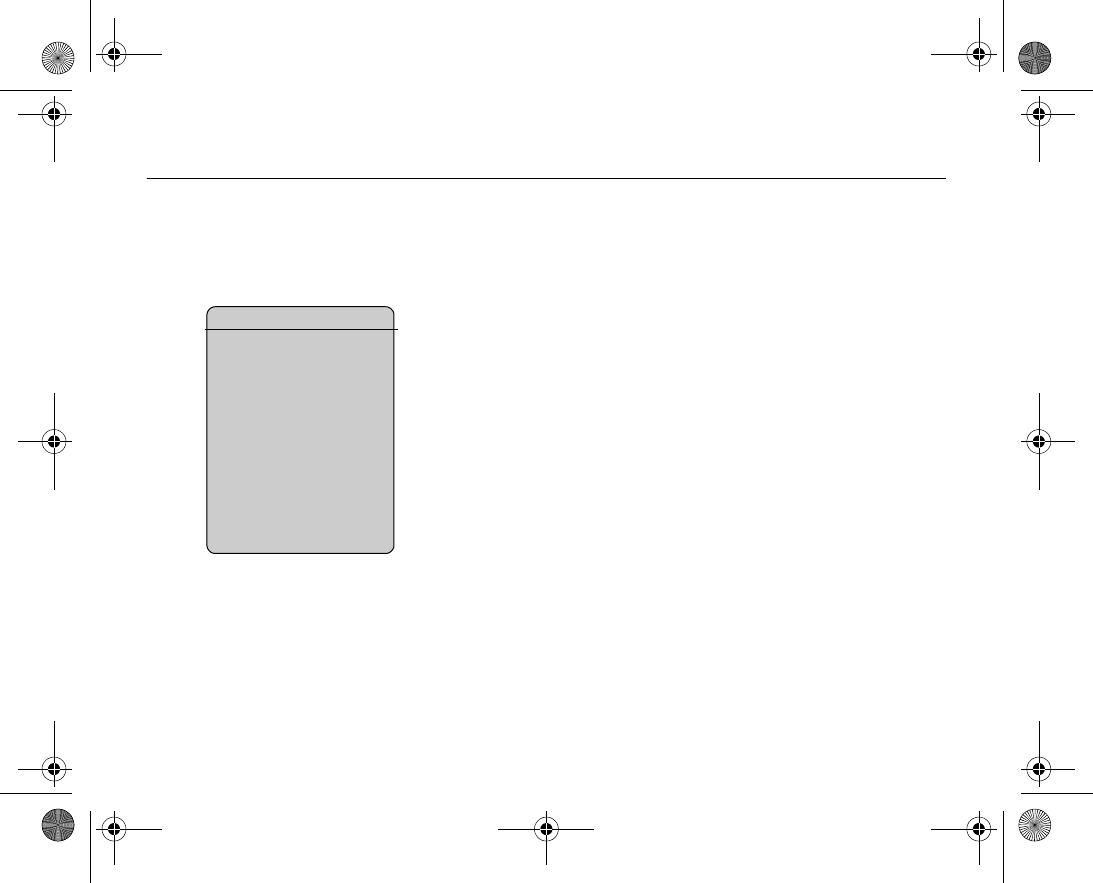
33
2.8 My items
Use the My Items to handle files saved in the phone memory. Items such as Pictures,
Videos, Sounds, Themes, Games, Applications, and Web pages are saved as files
in folders. All files that the phone cannot recognize are saved in the Other folder. You
can create your own subfolders in some predefined folders, to which you can move your
saved files. You can also transfer the saved files to a computer, %
114 File transfer
using Bluetooth
and %
117 Transferring files using the USB cable
.
To move a file to a folder
1. } My Items and open a folder.
2. Scroll to a file, for example, a picture that you want to move } More } Manage
files } Move to folder.
3. Select the folder you want to move the file to, or select New folder and name the
folder } OK.
To create a subfolder
1. } My Items and open a folder.
2. } More } New folder and enter a name for the folder.
3. } OK to save the folder.
To select several files
1. } My Items and select a file } More } Mark } Mark several.
2. Scroll and select more files by pressing Mark or Unmark.
To select all files in a folder
} My Items and select a file } More } Mark press Mark all or Unmark all to
remove the selection.
Using items
If you highlight a file in the Pic
tures or Sounds folder } More
} Use as, you can use the file
for several purposes.
You can, for example, set a
sound as a ringtone, set a pic
ture as screen saver, or add a
picture to a contact.
VF_Nanami_UG_R1A.book Page 33 Tuesday, June 14, 2005 10:00 AM

34
To move or copy files to a computer
%
114 File transfer using Bluetooth
and %
117 Transferring files using the USB cable
File information
Items that are downloaded, or received using one of the available transfer methods,
may be copyrightprotected. If a file is protected, you may not be able to copy or send
that file. You can select to view information for the file.
VF_Nanami_UG_R1A.book Page 34 Tuesday, June 14, 2005 10:00 AM
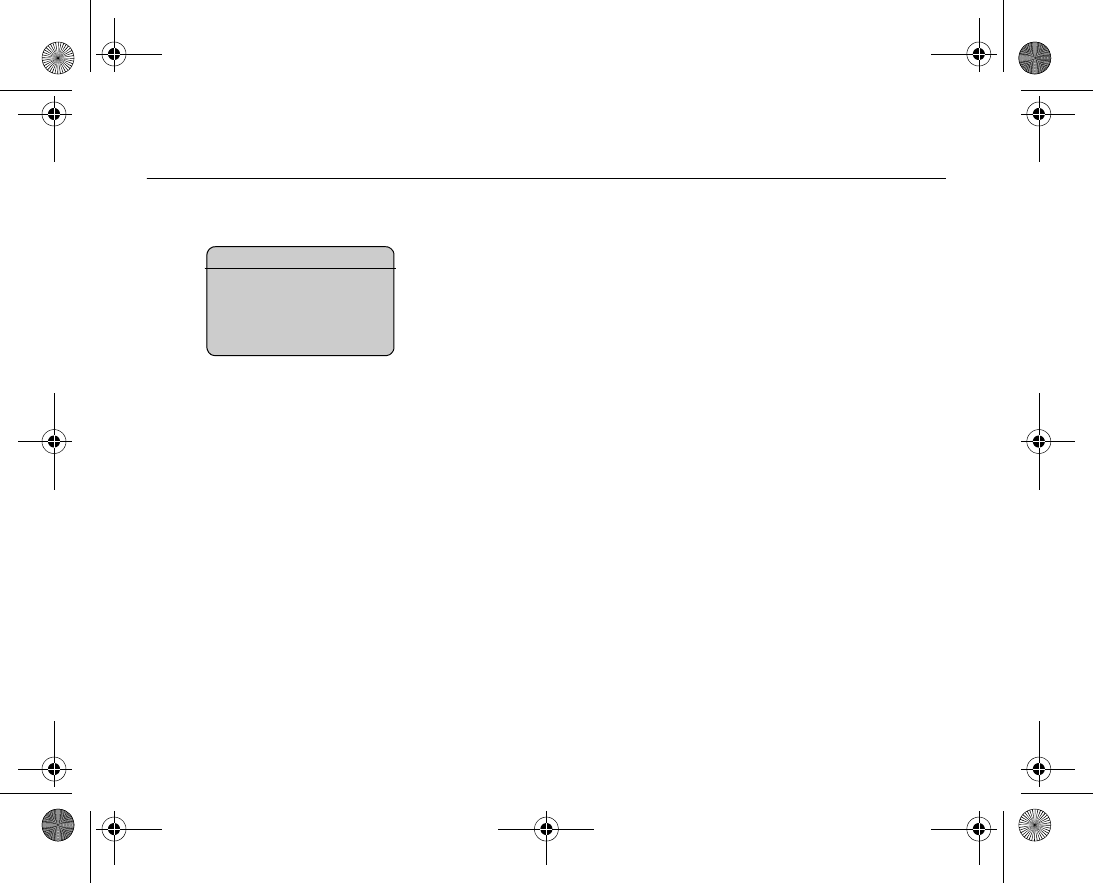
35
2.9 Contacts
You can save your contact information in the phone memory as contacts, or on the SIM
card as names and numbers. You can choose which contacts information – Phone
contacts or SIM contacts – is shown as default.
Default contact
If you select to use Phone contacts as default, your contacts will show all information
saved in Contacts. If you select SIM contacts as default, the contacts will only show
names and numbers saved on the SIM card.
To select default contacts
1. } Contacts } Options } Advanced } Default contacts.
2. Select Phone contacts or SIM contacts.
Contacts
Contacts is like an address book, in which you can store names, phone numbers and
email addresses. You can also add pictures, ringtones and personal information, such
as birthday, email, Web and street addresses, to the contacts.
When you add information to a contact, the information is organized under five tabs.
To add a phone contact
1. } Contacts } New contact } Add.
2. Enter the name directly or press Add and enter the name } OK.
3. Enter the number directly or press Add and enter the number } OK.
4. Select a number type.
Contacts options
For useful information and set
tings } Contacts } Options.
VF_Nanami_UG_R1A.book Page 35 Tuesday, June 14, 2005 10:00 AM

36
5. Scroll between the tabs using and . Select fields to enter more information. To
enter symbols, for example, @ in an email address } Symbols and select a symbol
} Insert.
6. When you have entered the information } Save.
SIM contacts
On your SIM card, you can save entries as a name with a single number. The number of
entries you can save depends on the amount of memory available on the SIM card, see
Contacts } Options } Advanced } Memory status.
Note:
Contact Vodafone for more information.
To add a SIM contact
If SIM contacts are default contacts, follow the same steps as for adding a phone con
tact. You can add only name and number to SIM contacts.
Always save on the SIM card
You can set the phone to save entries automatically to the SIM card. With this setting,
names and phone numbers that you add to or edit in your phone contacts in the phone
memory are also saved on the SIM card. The number of phone numbers that can be
saved depends on the type of SIM card.
To automatically save names and phone numbers to the SIM card
1. } Contacts } Options } Advanced } Auto save on SIM.
2. Select On.
Checking the memory
With the memory status function, you can check how many positions you have left in
the phone memory and SIM memory.
VF_Nanami_UG_R1A.book Page 36 Tuesday, June 14, 2005 10:00 AM
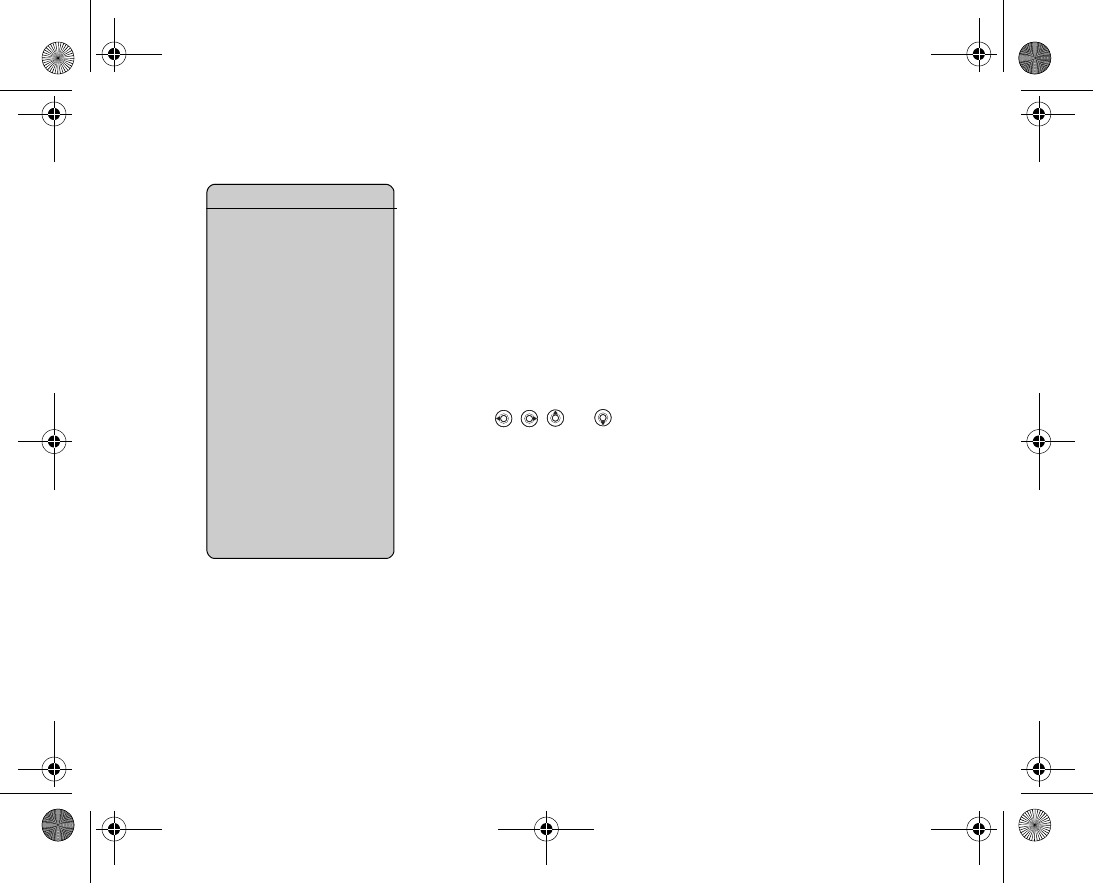
37
If the memory is full, you must delete contacts to be able to add new contacts, %
39 To
delete a contact
.
To check the memory
} Contacts } Options } Advanced } Memory status.
Pictures and personal ringtones
You can add a picture and a personal ringtone to a phone contact. When that person
calls, the picture is displayed (provided your subscription supports the Calling Line Iden
tification service) and the ringtone is played.
To add a picture or a ringtone to a phone contact
1. } Contacts and select the contact you want to add a picture or ringtone to } More
} Edit contact.
2. Use , , and to scroll to the relevant tab. } Picture: or Ringtone }
Add.
3. Select a picture or sound. } Save to save the contact.
Calling contacts
You can call one of the numbers saved for one of your contacts, or a number on your
SIM card.
If phone contacts are set as default, you can choose to call from contacts or from the
SIM card.
If SIM contacts are set as default, you can only call the numbers on the SIM card.
To call a phone contact
1. } Contacts. Scroll to, or enter the first letter or letters of the contact you want to
call.
Adding numbers
You can update your contacts
with numbers that you have
dialled and with numbers from
calls that you have received or
missed.
1. } Calls from standby and
select a tab in the call list.
2.Scroll to the number you want
to add to contacts } More }
Save number.
3.Add the number to a new
contact or to an existing con
tact.
VF_Nanami_UG_R1A.book Page 37 Tuesday, June 14, 2005 10:00 AM
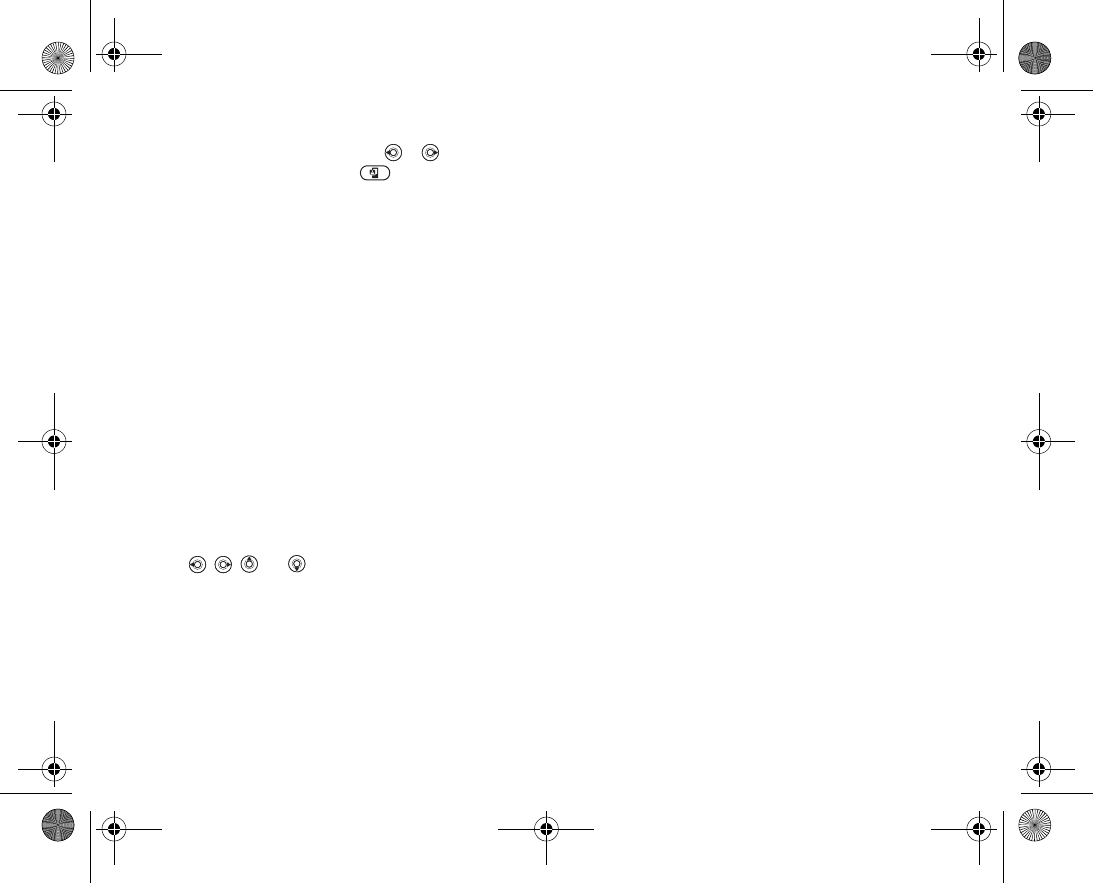
38
2. When the contact is highlighted, press or to select a number } Call. To
make a video call, press and hold when the contact is highlighted.
To call a SIM contact
1. } Contacts. If SIM contacts are set as default, select the name and number you
want to call from the list } Call.
2. If phone contacts are set as default } Contacts } Options } SIM contacts and
select the name and number you want to call from the list } Call.
Ask to save
When you end a call or receive a message, the phone can prompt you to add a phone
number or email address to your contacts.
To activate ask to save
} Contacts } Options } Advanced } Ask to save } On.
Updating contacts
You can easily update and edit any information in your contacts.
To edit a phone contact
1. } Contacts and select a contact } More } Edit contact.
2. Use , , and to scroll to the relevant tab and edit the information you
want to edit } Save.
To edit a SIM contact
1. If SIM contacts are set as default } Contacts and select the name and number you
want to edit. If phone contacts are set as default } Contacts } Options } SIM
contacts. Select the name and number you want to edit.
2. } More } Edit and edit the name and number.
VF_Nanami_UG_R1A.book Page 38 Tuesday, June 14, 2005 10:00 AM
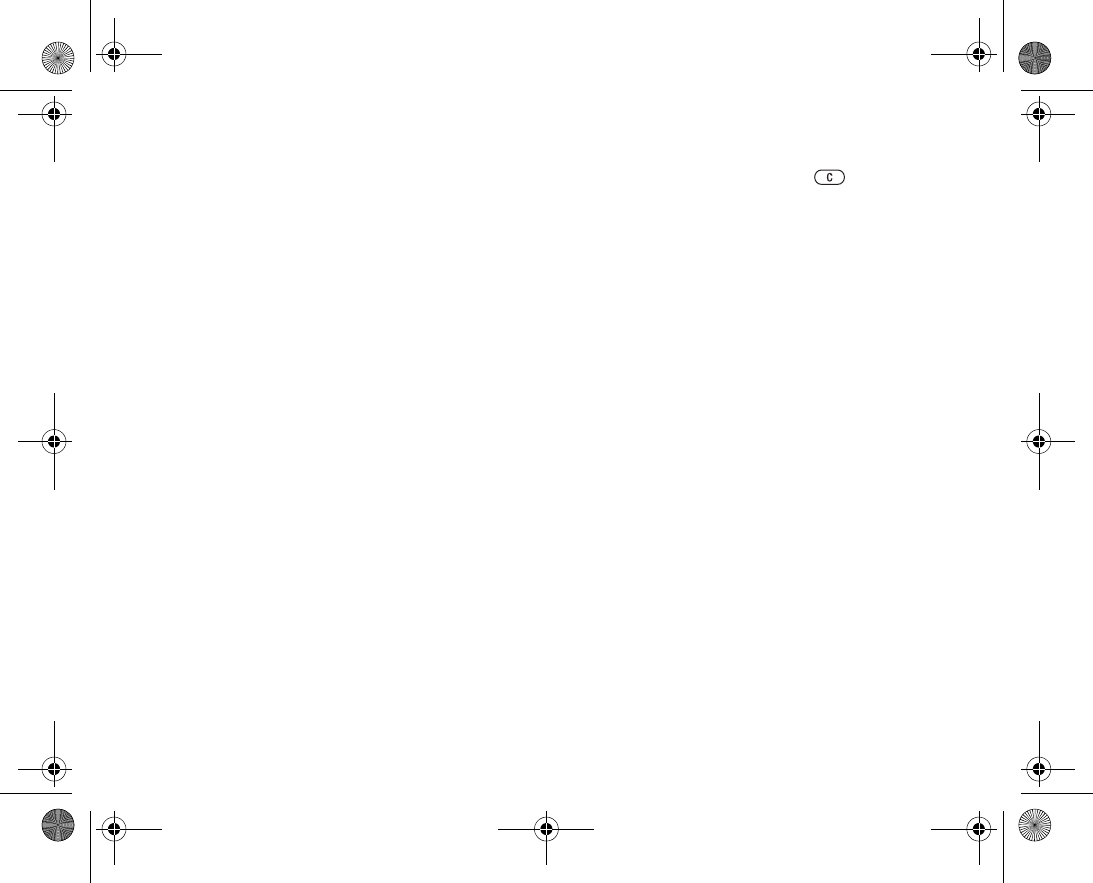
39
To delete a contact
} Contacts and scroll to the contact you want to delete, press .
To delete all contacts
1. } Contacts } Options } Advanced } Delete all contacts.
2. } Yes and enter the phone lock code } OK. The default phone lock code is 0000.
Names and numbers that are saved on the SIM card are not deleted.
Default items for phone contacts
A default item is displayed in the first position for a phone contact, and is therefore
quicker to access. You can set the default item – a phone number, email address or a
Web address – to be displayed first for each contact. If you do not set your own default
item, the mobile phone number is the default item.
To set the default item for a contact
1. } Contacts and scroll to a contact } More } Default number.
2. Select the phone number, email address or Web address that you want as default
item.
Sending contacts
You can send contacts using one of the available transfer methods.
To send a contact
} Contacts and select a contact } More } Send contact and select a transfer
method.
To send all contacts
} Contacts } Options } Advanced } Send all contacts
and select a transfer
method.
VF_Nanami_UG_R1A.book Page 39 Tuesday, June 14, 2005 10:00 AM

40
Synchronizing contacts
You can back up and synchronize your contacts with the Vodafone live! network.
1. } Contacts } Options } Sync. contacts.
2. If you have more than one account, select which account to use } Select. If you do
not have an account in the phone, %
109 To enter the remote synchronization set
tings
.
Note:
Visit www.vodafone.com for details. This service is not available for all countries.
Copying contacts
You can copy names and numbers to and from your phone contacts and the SIM card.
Choose if you want to copy all numbers, or a single number.
Note:
When you select to copy all contacts from the phone to the SIM card, all existing infor
mation on the SIM card will be replaced.
To copy names and numbers to the SIM card
1. } Contacts } Options } Advanced } Copy to SIM.
2. Select Copy all or Copy a number.
To copy names and numbers to phone contacts
1. } Contacts } Options } Advanced } Copy from SIM.
2. Select Copy all or Copy a number.
VF_Nanami_UG_R1A.book Page 40 Tuesday, June 14, 2005 10:00 AM
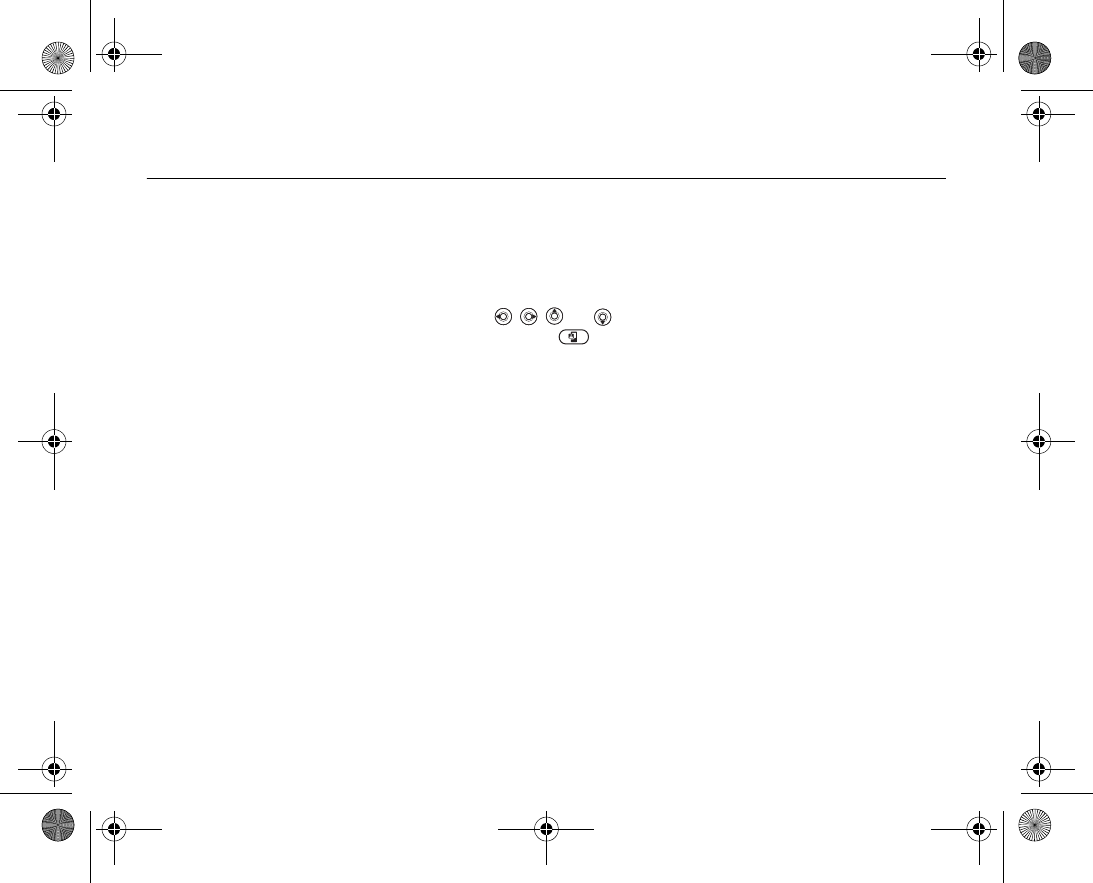
41
2.10 Call list
The numbers of the most recent calls are saved in the call list. Dialled, answered and
missed calls are listed under separate tabs.
To call a number from the call list
1. } Calls from standby and select a tab.
2. Use , , and to scroll to the name or number you want to call } Call, or
press and hold to make a video call.
To add a number from the call list to contacts
1. } Calls from standby and select a tab.
2. Scroll to the number you want to add } More } Save number.
3. } New contact to create a new contact, or select an existing contact to add the
number to.
To clear the call list
} Calls } the All tab } More } Delete all.
VF_Nanami_UG_R1A.book Page 41 Tuesday, June 14, 2005 10:00 AM
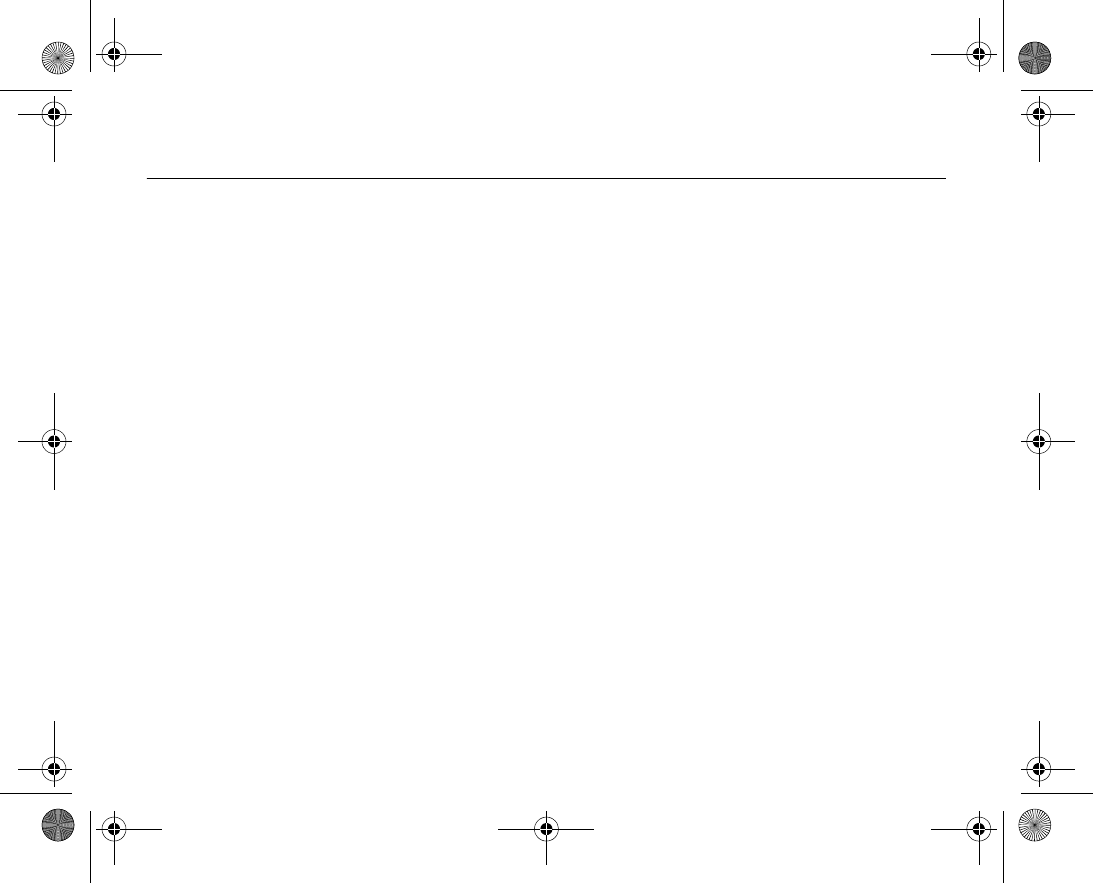
42
Speed dialling 2.11
You can save the phone numbers that you want to reach easily in positions 19 in your
phone.
To speed dial
From standby, enter the position number and } Call.
To set or replace speed dialling numbers
1. } Contacts } Options } Speed dial.
2. Scroll to the position in the list } Add or } Replace.
3. Select an existing contact to add the position number to.
VF_Nanami_UG_R1A.book Page 42 Tuesday, June 14, 2005 10:00 AM
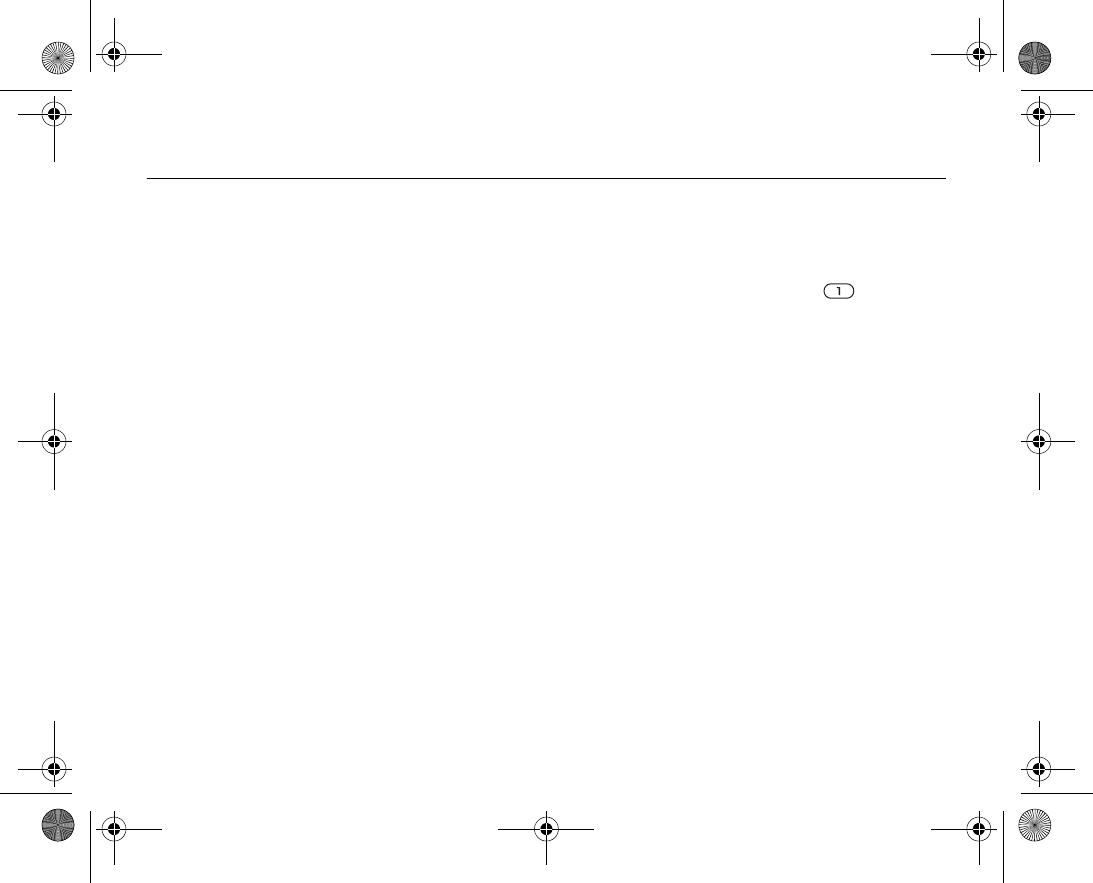
43
2.12 Voicemail
If your subscription includes an answering service, callers can leave a voicemail mes
sage when you cannot answer a call.
Calling your voicemail service
You can easily call your voicemail service by pressing and holding . If you have not
set your voicemail number, you will be asked if you want to enter the number. } Yes to
enter the number. You get the number from your network operator.
To enter your voicemail number
} Messaging } Settings } Voicemail number.
VF_Nanami_UG_R1A.book Page 43 Tuesday, June 14, 2005 10:00 AM
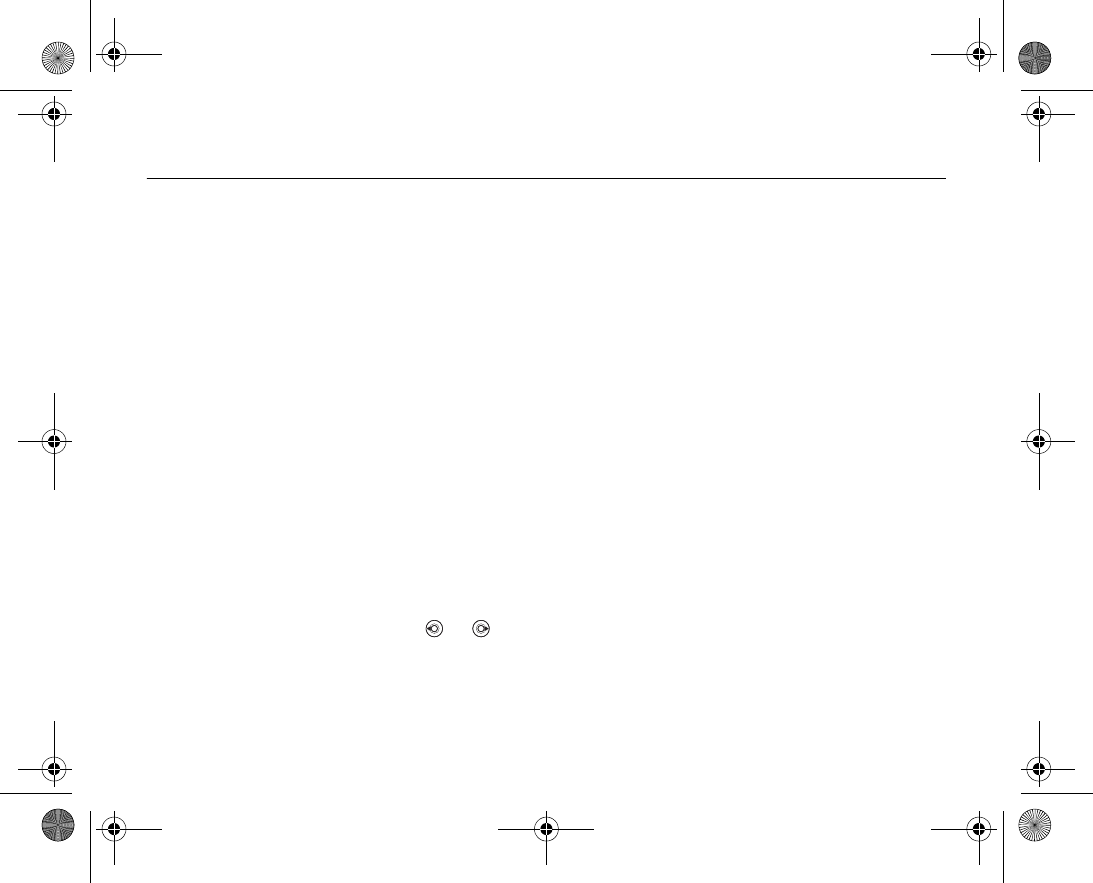
44
Voice control 2.13
With your phone, you can use your voice to:
• Voice dial – call someone by saying the name.
• Activate voice control by saying a “magic word”.
• Answer and reject calls when using a handsfree kit.
Voice commands can only be saved in the internal phone memory, not on the SIM card.
When recording, make sure that you are in a quiet environment and try to use names
that are distinct from each other, %
47 Tips when recording and using voice com
mands
.
Voice dialling
You can voice dial by saying a prerecorded voice command. Start voice dialling from
standby using the phone, a portable handsfree, a Bluetooth headset or by saying your
magic word.
You must first activate the voice dialling function and record your voice commands. An
icon appears next to a phone number that has a voice command.
To activate voice dialling and record names
1. } Settings } the General tab } Voice control }Voice dialling } Activate }
Yes }New voice } Add and select a contact.
2. If the contact has more than one number, use and to view the numbers.
Select the phone number to which you want to add the voice command. Now you are
going to record a voice command such as “John mobile” for the phone number you
selected.
VF_Nanami_UG_R1A.book Page 44 Tuesday, June 14, 2005 10:00 AM

45
3. Instructions appear. Wait for the tone and say the command that you want to record.
The voice command is played back to you.
4. If the recording sounds ok } Yes. If not } No and repeat step 3.
5. To record another voice command for a contact } New voice } Add again and
repeat steps 24 above.
To make a call from the phone
1. From standby, press and hold one of the volume buttons.
2. Wait for the tone and say the name you recorded earlier, for example “John mobile”.
The name is played back to you and the call is connected.
To make a call with a handsfree
From standby, press the handsfree button, or the Bluetooth headset button.
Caller name
You can choose whether you want to hear the recorded contact name when you receive
a call from that contact.
To turn the caller name on or off
} Settings } the General tab } Voice control } Play caller name.
The magic word
You can record a magic word and use it as a voice command to allow totally handsfree
access to voice dialling. Instead of pressing and holding a volume button to voice dial,
you say the magic word and then one of your recorded voice commands. The magic
word is especially suitable when using a car handsfree kit.
Note:
Choose a long, unusual word or phrase that can easily be distinguished from ordinary
background speech.
VF_Nanami_UG_R1A.book Page 45 Tuesday, June 14, 2005 10:00 AM

46
To activate and record the magic word
1. } Settings } the General tab } %
44 Voice control
} Magic word } Activate.
2. Instructions appear. } Continue. Wait for the tone and say the magic word.
3. Instructions appear. } Continue and select the environments in which you want
your magic word to be activated. You can select several alternatives.
Voice answering
You can answer or reject incoming calls by using your voice, when using a portable or
car handsfree kit.
Note:
You can only use a MIDI, WAV, EMY or IMY file as a ringtone with voice answering.
To activate voice answering and record voice answer commands
1. } Settings } the General tab } Voice control } Voice answer } Activate.
Instructions appear. } Continue. Wait for the tone and say “Answer”, or another
word. If the recording sounds ok } Yes. If not } No and repeat step 2.
2. Say “Busy”, or another word } Yes.
3. Instructions appear. } Continue and select the environments in which you want
voice answering to be activated. You can select several alternatives.
To answer a call using voice commands
When the phone rings, say “Answer” and the call is connected.
To reject a call using voice commands
When the phone rings, say “Busy”. The call is rejected. The caller is diverted to voice
mail, if activated, or hears a busy tone.
VF_Nanami_UG_R1A.book Page 46 Tuesday, June 14, 2005 10:00 AM

47
Editing your voice commands
You can edit all your voice commands saved in Contacts. Select the contact you want
to edit a voice command for } More } Edit contact. Scroll to the relevant tab and edit
your voice command.
To rerecord a voice command
1. } Settings } the General tab } Voice control } Voice dialling } Edit names.
2. Select a voice command } More } Replace voice.
3. Wait for the tone and say the command.
Tips when recording and using voice commands
If your phone cannot detect your voice command, one of the following might have hap
pened:
• You spoke too softly – try speaking louder.
• You held the phone too far away – hold it as you do during a call.
• The voice command was too short – it should be around one second long and more
than one syllable.
• You spoke too late or too soon – speak immediately after the tone.
• You did not record the voice command when the handsfree was attached – for voice
control with a handsfree kit, record when the handsfree is attached.
• You used another intonation – use the same intonation as in the recorded voice com
mand.
VF_Nanami_UG_R1A.book Page 47 Tuesday, June 14, 2005 10:00 AM
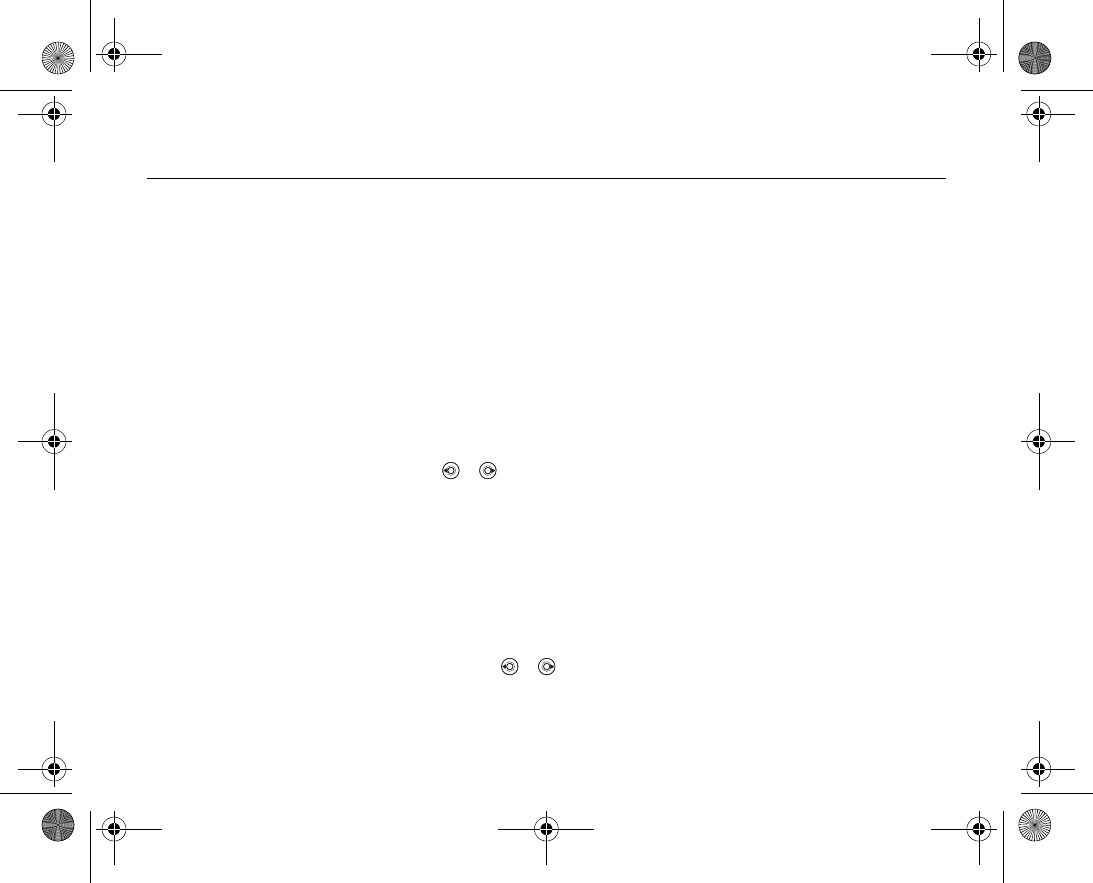
48
Diverting calls 2.14
If you cannot answer incoming calls, you can divert them to another number, for exam
ple, your answering service.
Note:
When the Restrict calls function is activated, some Divert calls options are not available.
You can choose between the following divert options:
•Divert always – divert all calls.
•When busy – divert calls if you are already on the phone.
•Not reachable – divert calls if your phone is turned off or if you are unreachable.
•No reply – divert calls that you do not answer within a specified time limit.
To activate a call divert
1. } Settings } the Calls tab } Divert calls. Use or to scroll between the
tabs.
2. Select a call type and then one of the divert options } Activate.
3. Enter the phone number to which you want your calls to be diverted, or press Look
up to find the contact } OK.
To deactivate a call divert
Scroll to the divert option } Deactivate.
To check all divert options
} Settings } the Calls tab } Divert calls } Check all. Use or to scroll
between the tabs.
VF_Nanami_UG_R1A.book Page 48 Tuesday, June 14, 2005 10:00 AM
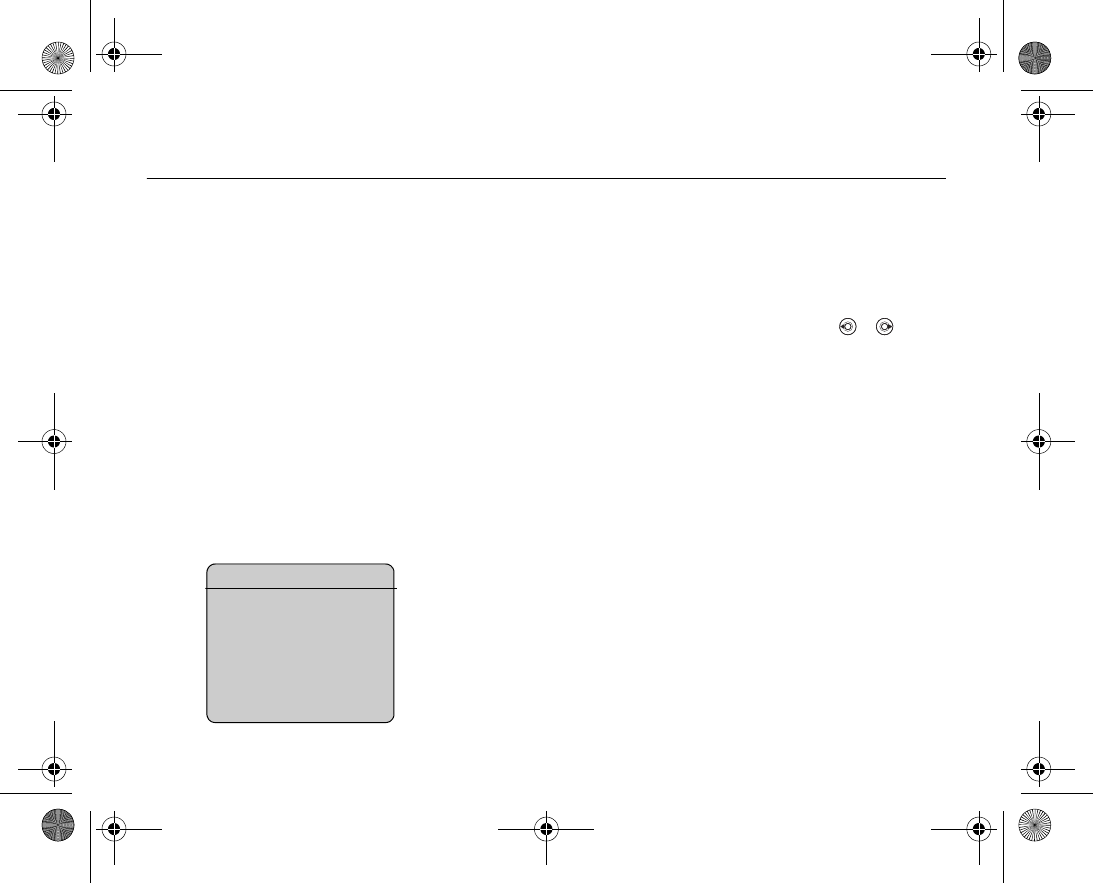
49
2.15 More than one call
You can handle more than one call simultaneously.
Call waiting service
When the service is activated, you hear a beep if you receive a second call.
To activate or deactivate the call waiting service
} Settings } the Calls tab } Manage calls } Call waiting. Use or to scroll
between the tabs.
To make a second call
1. } More } Hold call to put the ongoing call on hold.
2. Enter the number you want to call } More } Call.
Receiving a second voice call
When you receive a second call, you can do the following:
•} Answer and put the ongoing call on hold.
•} Busy to reject the second call and continue the ongoing call.
•} Replace active call to answer the second call and end the ongoing call.
Handling two voice calls
When you have one ongoing call and one call on hold, you can do the following:.
•} Switch calls to switch between the two calls.
•} More } Join calls to join the two calls into a conference call.
•} More } Transfer call, to connect the two calls. You are disconnected from both
calls.
•} End call to end the ongoing call, then press Yes to retrieve the held call.
Ongoing video call
When you have an ongoing
video call and receive a second
call you have to end the video
call to be able to answer the
second call.
VF_Nanami_UG_R1A.book Page 49 Tuesday, June 14, 2005 10:00 AM

50
•} End call } No to end both calls.
• You cannot answer a third call without ending one of the first two calls or joining
them into a conference call.
Conference calls
In a conference call, you can have a joint conversation with up to five other people. You
can also put a conference call on hold and make another call.
Note:
There may be additional charges for calls involving multiple parties, contact Vodafone
Customer Care for more information.
To join the two calls into a conference call
} More } Join calls.
To add a new participant
1. } More } Hold call to put the joined calls on hold.
2. } More } Add call and call the next person you want to include in the conference
call.
3. } More } Join calls.
4. Repeat steps 13 to include more participants.
To release a participant
} More } Release part and select the participant that you want to release from the
conference call.
To have a private conversation
1. } More } Talk to and select the participant that you want to talk to.
2. } More } Join calls to resume the conference call.
VF_Nanami_UG_R1A.book Page 50 Tuesday, June 14, 2005 10:00 AM
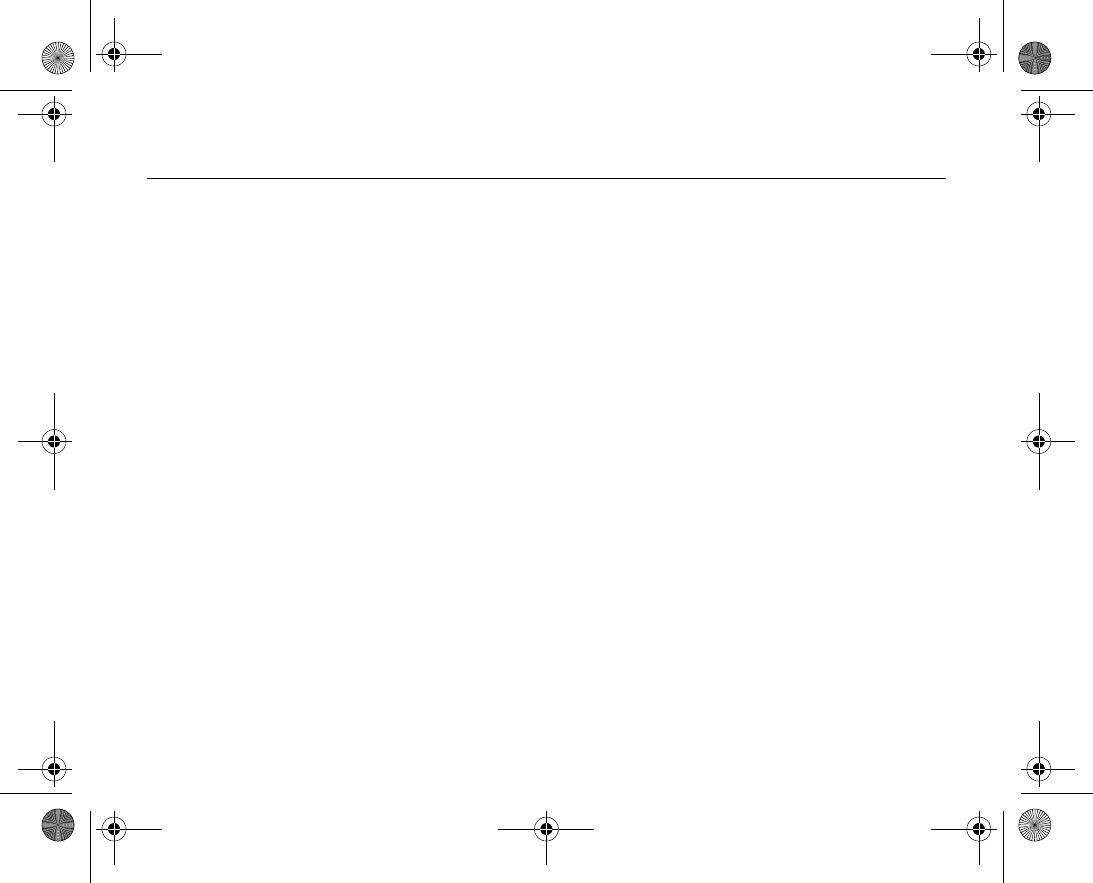
51
2.16 More call features
My numbers
View, add and edit your own phone numbers.
To check your phone numbers
} Contacts } Options } Special numbers } My numbers and select one of the
options.
Notepad
You can use the phone to make a note of a phone number during a call. When you
press the number keys, the person you are talking to hears tone signals. When you end
the call, the number remains on the screen. } Call to call the number. } More } Save
number and select a contact to save the number. If you want to create a new contact
and save the number } New contact.
Groups
You can create a group of numbers and email addresses. By doing so, you can send
messages to several recipients at the same time, %
57 Messaging
.
You can also use groups (with numbers) when you create accepted callers lists, %
52
Accept calls
.
To create a group of numbers and email addresses
1. } Contacts } Options } Groups } New group } Add.
2. Enter a name for the group } Continue.
3. } New } Add to find and select a contact number.
VF_Nanami_UG_R1A.book Page 51 Tuesday, June 14, 2005 10:00 AM
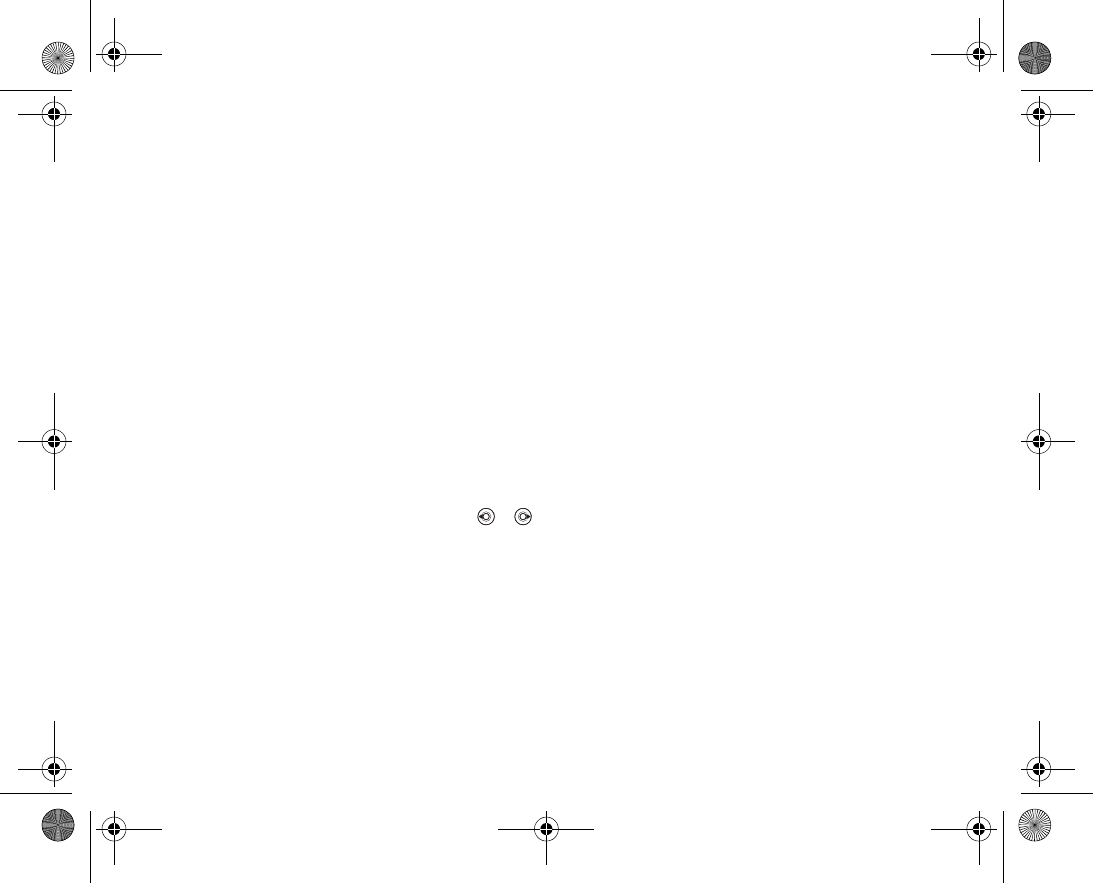
52
4. Repeat step 3 to add more numbers. } Done.
Business cards
You can add your own business card as a contact.
To add your own business card
} Contacts } Options } My business card and add information for your business
card } Save.
To send your business card
} Contacts } Options } My business card } Send my card and select a transfer
method.
Showing or hiding your number
If your subscription supports the Calling Line Identification Restriction (CLIR) service,
you can hide your phone number when making a call.
To always show or hide your phone number
1. } Settings } the Calls tab } Show or hide no.. Use or to scroll between
the tabs.
2. Select Show number, Hide number or Network default.
Accept calls
With the accept calls service, you can choose to receive calls only from certain phone
numbers. Other calls are automatically rejected by a busy tone. If the call divert option
When busy is activated, calls are diverted instead of rejected by a busy tone. The
phone numbers of calls you have rejected are saved in the call list.
VF_Nanami_UG_R1A.book Page 52 Tuesday, June 14, 2005 10:00 AM
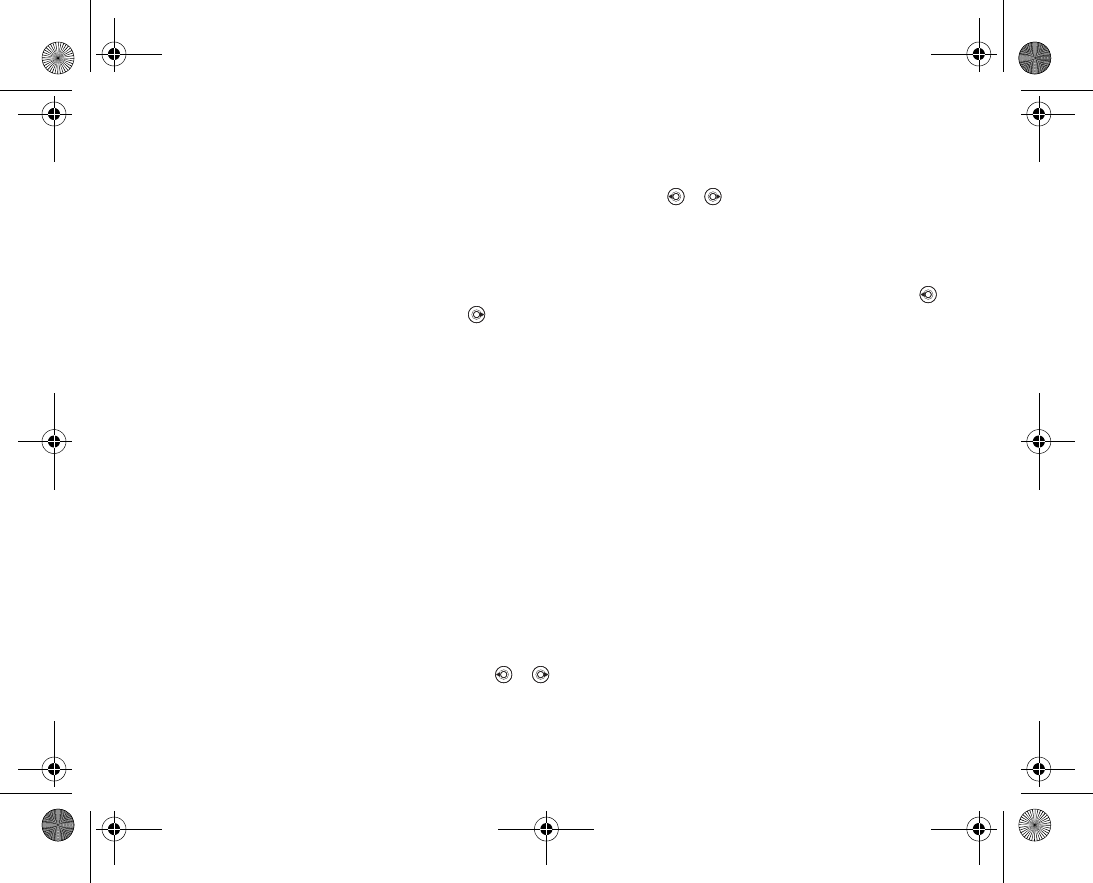
53
To add numbers to the accepted callers list
1. } Settings } the Calls tab } Manage calls } Accept calls } Only from list }
Edit } Add. Select a contact. Use or to scroll between the tabs.
2. To add a group of contacts to the accepted callers list } Groups (requires that you
have created groups, %
51 Groups
).
To accept all calls
} Settings } the Calls tab } Manage calls } Accept calls } All callers. Use
or to scroll between the tabs.
Restricted dialling
You can use the restrict calls service to restrict outgoing and incoming calls. You need a
password which you get from your service provider.
Note:
If you divert incoming calls, you cannot activate some Restrict calls options.
The following calls can be restricted:
•All outgoing – All outgoing calls.
•Outgoing intl – All outgoing international calls.
•Outgoing intl roam. – All outgoing international calls except to your home country.
•All incoming – All incoming calls.
•Inc. when roaming – All incoming calls when you are abroad (when roaming).
To activate or deactivate a call restriction
1. } Settings } the Calls tab } Manage calls } Restrict calls and select an option.
Use or to scroll between the tabs.
2. Select Activate or Deactivate, enter your password } OK.
VF_Nanami_UG_R1A.book Page 53 Tuesday, June 14, 2005 10:00 AM

54
Fixed dialling
The fixed dialling function allows calls to be made only to certain numbers saved on the
SIM card. The fixed numbers are protected by your PIN2.
Note:
You can still call the international emergency number, 112, even when the fixed dialling
function is activated.
Partial numbers can be saved. For example, saving 0123456 allows calls to be made to
all numbers starting with 0123456.
Note:
When fixed dialling is activated, you cannot view or manage any phone numbers that
are saved on the SIM card.
To activate or deactivate fixed dialling
1. } Contacts } Options } Special numbers } Fixed dialling and select Activate
or Deactivate.
2. Enter your PIN2 } OK and then } OK again to confirm.
To save a fixed number
} Contacts } Options } Special numbers } Fixed dialling } Fixed numbers }
New number and enter the information.
Two voice lines
If you have a subscription that supports an alternate line service, your phone may have
two voice lines with different phone numbers.
VF_Nanami_UG_R1A.book Page 54 Tuesday, June 14, 2005 10:00 AM
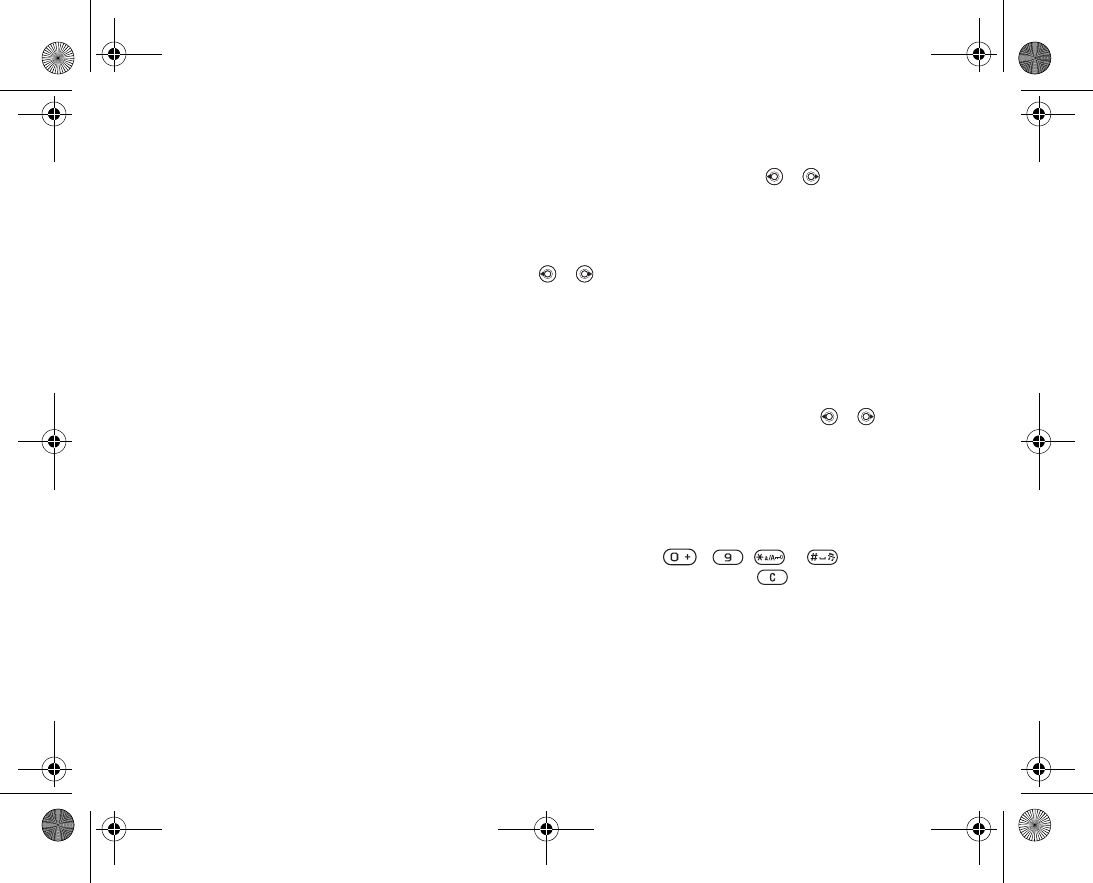
55
To select a line for outgoing calls
} Settings } the Calls tab and select line 1 or 2. Use or to scroll between the
tabs.
To change the name of a line
} Settings } the Display tab } Edit line names and select one of the lines to edit
the name. Use or to scroll between the tabs.
Call time and cost
During a call, the duration of the call is shown on the screen. You can check the dura
tion of your last call, outgoing calls and the total time.
To check the call time
} Settings } the Calls tab } Time & cost } Call timers. Use or to scroll
between the tabs.
Tone signals
You can use telephone banking services or control an answering machine by sending
tone signals during a call.
• To send the tones, press the keys , or .
• To clear the screen after the call is finished, press .
• To turn the tones off during a call, } More } Disable tones.
Activity menu
You can open the activity menu from standby to view and handle new events, and
access bookmarks and shortcuts.
VF_Nanami_UG_R1A.book Page 55 Tuesday, June 14, 2005 10:00 AM
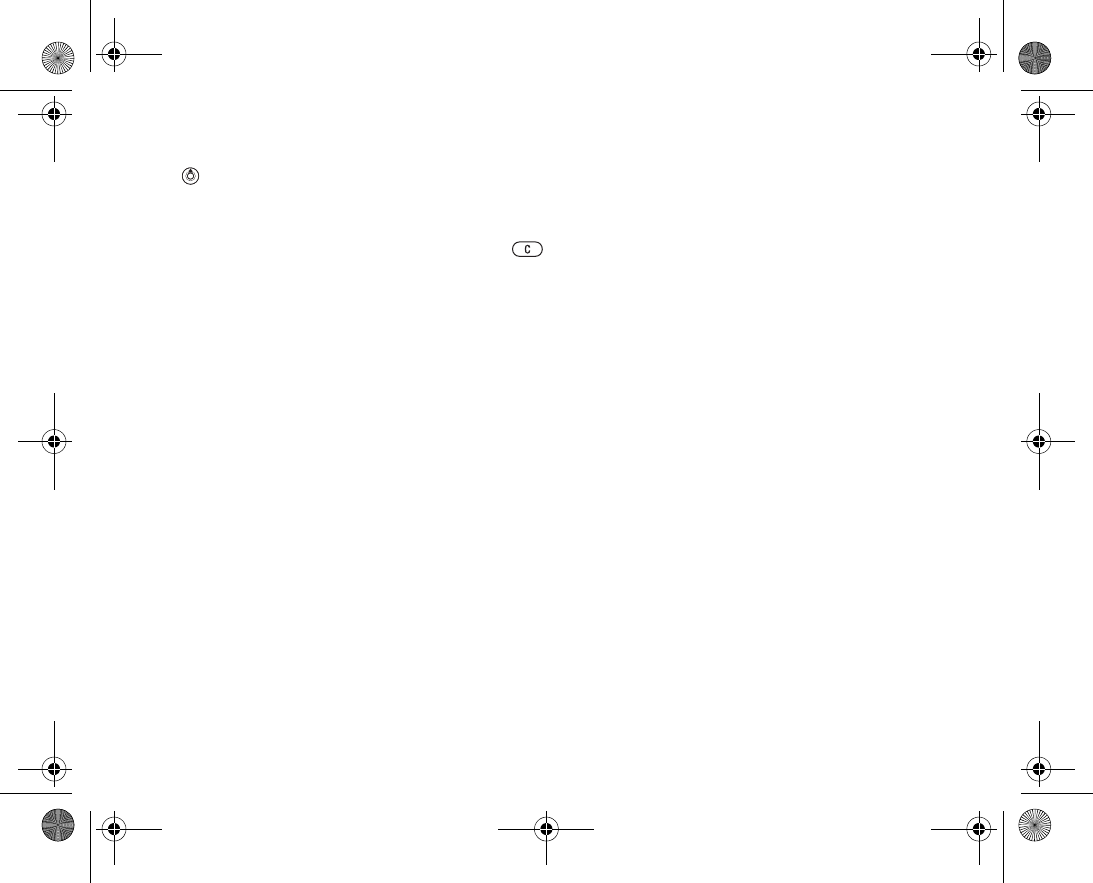
56
To open the Activity menu
Press .
Activity menu tabs
•New events – this shows new events such as missed calls and messages. When
a new event occurs, the tab appears on the screen. Press to dismiss or
delete an event from the event tab.
•My shortcuts – this shows your shortcuts and applications that are running in
the background. You can add, delete and change the order of shortcuts. When
you select a shortcut and the application opens, other programs are closed or
minimized.
•Bookmarks – this shows your own Internet bookmarks. When you select a
bookmark and the browser opens, other programs are closed or minimized.
To select a view for new events
If you want new events to appear as popup text instead of in the activity menu, } Set
tings } the General tab } New events } Popup.
VF_Nanami_UG_R1A.book Page 56 Tuesday, June 14, 2005 10:00 AM

57
Messaging
This chapter gives information about the types of messages sup
ported in your phone as well as a complete Messaging glossary.
You will find instructions on how to send, read and manage text
messages (SMS), picture messages (MMS) and email. You will also
learn about Messenger – the instant messaging function that
allows you to join chat sessions and see which of your contacts
that are online.
Details about Area Information (traffic reports etc.) and Cell Infor
mation (important information from your network operator) exist.
Please contact your service provider for more information about
these services.
VF_Nanami_UG_R1A.book Page 57 Tuesday, June 14, 2005 10:00 AM
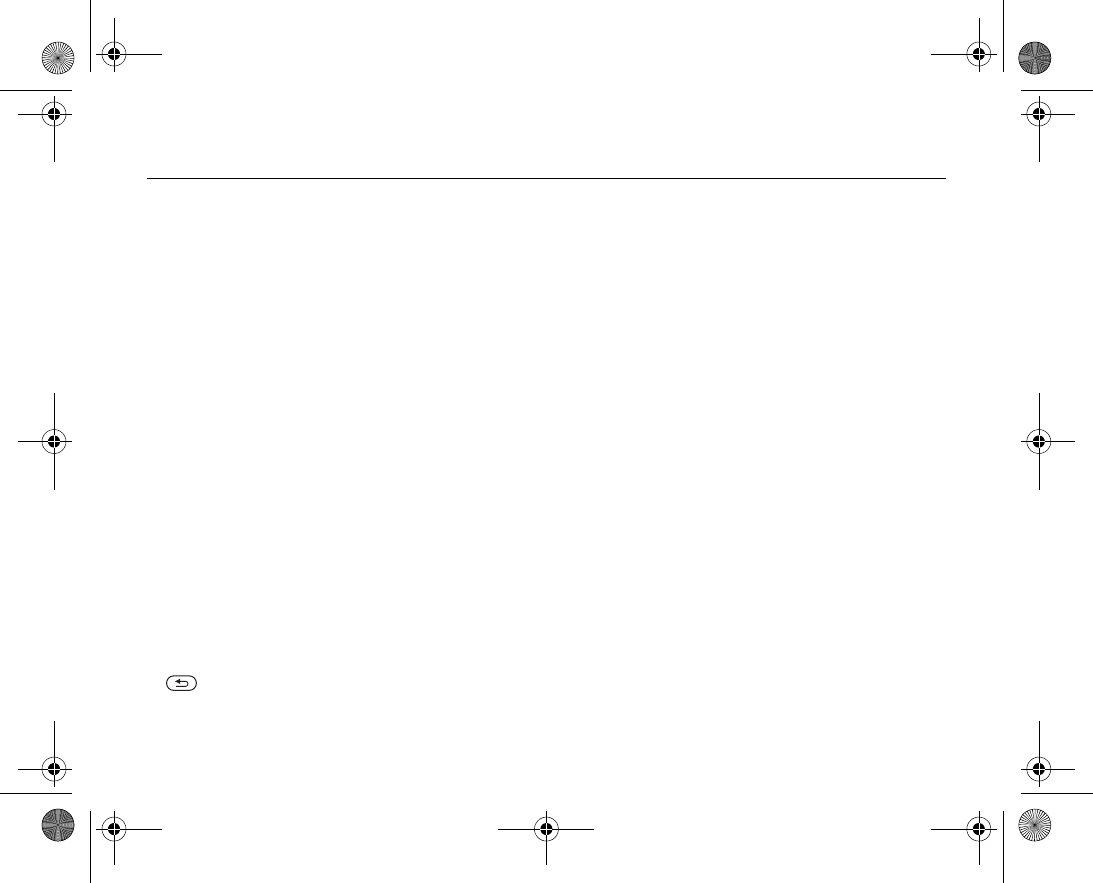
58
Text messaging (SMS) 3.1
Text messages can contain simple pictures, animations, melodies and sound effects.
Note:
If you send a text message to a group, you are charged for each member of that group.
Before you start
First make sure that the number of your service centre is set. The number is supplied by
your service provider and is usually saved on the SIM card.
To set the service centre number
1. } Messaging } Settings } SMS } Service centre. If the service centre number
is saved on the SIM card, it is shown in the list.
2. If there is no number in the list } Add and enter the number, including the interna
tional “+” sign and country code } Save.
Sending text messages
For information about entering letters, %
30 Entering letters
.
Note:
Some languagespecific characters use more space. For some languages you can
deactivate National chars. to save space,
%
32 Options list
.
To write and send a text message
1. } Messaging } Create new } SMS.
2. Write your message } Continue. If you want to save the message for later, press
. } Yes to save it in Drafts.
3. } Enter phone no. and enter the recipient’s phone number, or } Contacts look
up to retrieve a number or a group from Contacts. To enter an email address }
VF_Nanami_UG_R1A.book Page 58 Tuesday, June 14, 2005 10:00 AM
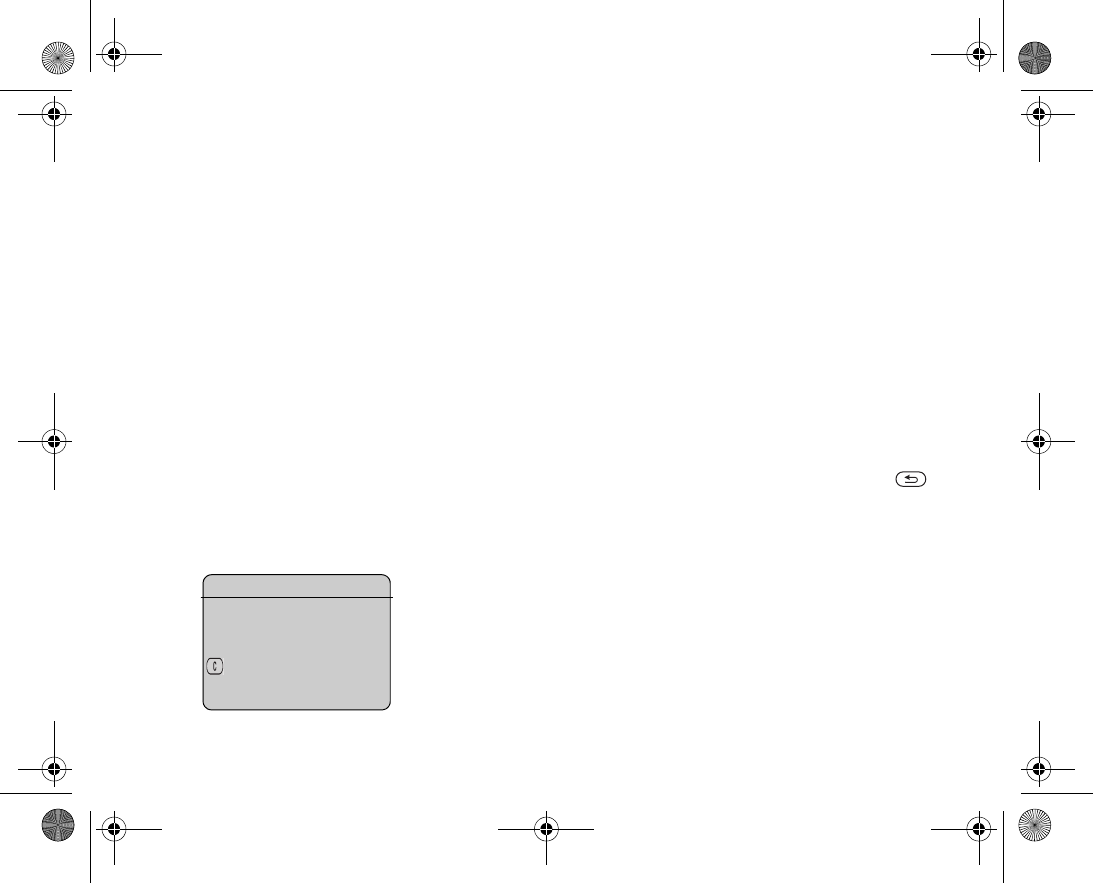
59
Enter Email addr. A list below the send options shows the last used recipients. You
can also select a recipient from this list. } Send.
Note:
To send a message to an email address, you need to set an email gateway number,
}
Messaging
}
Settings
}
SMS
}
Email gateway. The number is supplied by Vodafone.
To insert an item in a text message
1. While writing your message } More } Add item.
2. Select an item type and then select an item.
Receiving text messages
When you receive a text message, it appears in the Activity menu if New events is
set to Activity menu. } View to read the message.
If New events is set to Popup, you are asked if you want to read the text message. }
Yes to read the text message or } No if you want to read the message later.
When you have read the text message } More to view a list of options. Press to
close the text message.
To call a number in a text message
Select the phone number } Call.
Saving and deleting text messages
Text messages are saved in the phone memory. When the phone memory is full, you
must delete messages or move them to the SIM card to be able to receive new mes
sages. Messages that you have saved on the SIM card remain there until you delete
them.
To save a message to the SIM card
} Messaging } Inbox } More } Save message } Saved messages.
Delete a message
You can select a message from
the list of messages and press
to delete the entire mes
sage.
VF_Nanami_UG_R1A.book Page 59 Tuesday, June 14, 2005 10:00 AM
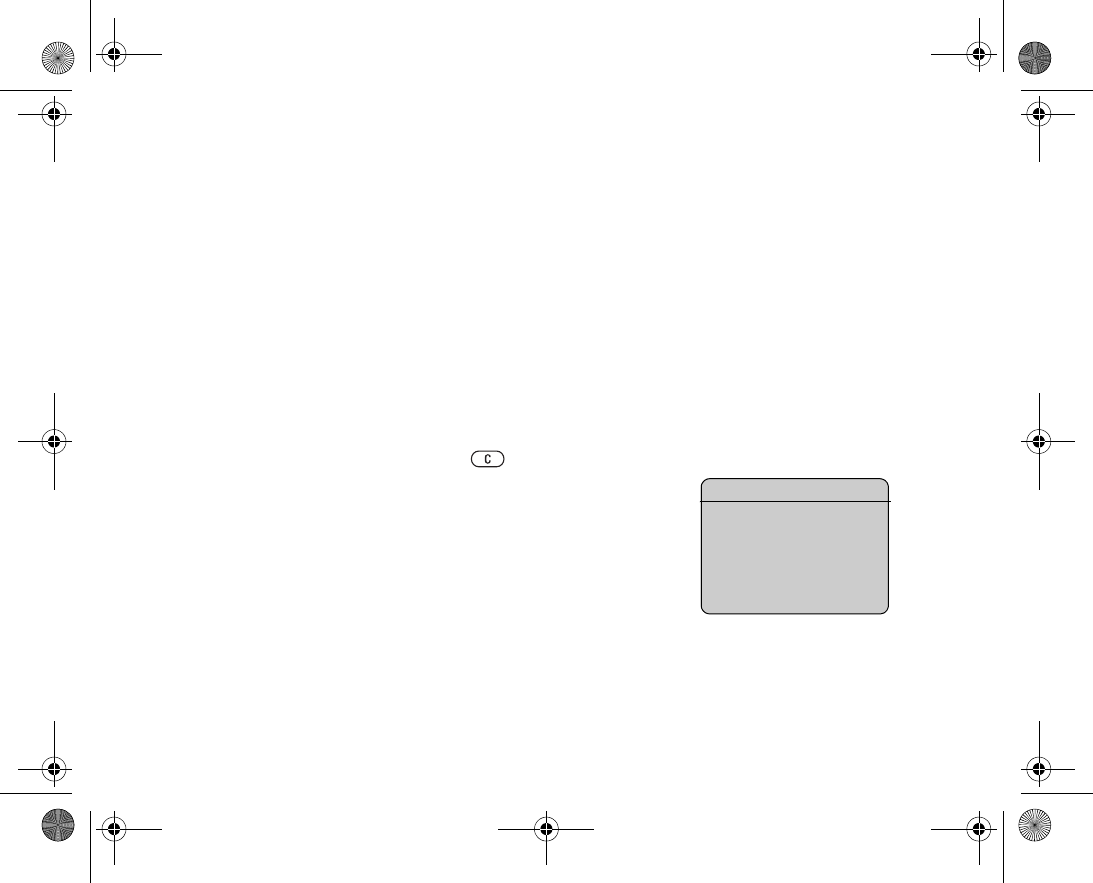
60
To save an item from a text message
1. Select the phone number, Web address, picture or sound that you want to save in
the message } More.
2. If you have selected to save a phone number } Use } Save number. If you have
selected a Web address } Save bookmark, a picture } Save picture, a melody }
Save sound.
To save or delete several messages
1. } Messaging and select a folder.
2. Select a message } More } Mark several.
3. Scroll and select more messages by pressing Mark or Unmark.
4. } More } Save messages or } More } Delete messages.
To delete a message
1. } Messaging and select a folder.
2. Select the message that you want to delete and press .
Long messages.
The number of characters that a text message can contain depends on the language
you are writing in. You can send a longer message by linking two or more messages.
You are charged for each of the messages linked in a long message. You may not
receive all parts of a long message at the same time.
Note:
Check with Vodafone for the maximum number of messages that can be linked.
To turn long messages on
} Messaging } Settings } SMS } Max. msg length } Max. available.
Long messages
Check with Vodafone Customer
Care for the maximum number
of messages that can be linked.
VF_Nanami_UG_R1A.book Page 60 Tuesday, June 14, 2005 10:00 AM

61
Templates
If you have messages that you send often, you can save these as templates. You can
create your own templates.
To create a template
1. } Messaging } Templates } New template } Add } Text.
2. Write the message } OK.
3. Enter a title for the message } OK.
Message options
You can set a default value for several message options or choose the settings each
time you send a message. To check the delivery status of a sent message, the delivery
report option must be on.
To set a default text message option
} Messaging } Settings } SMS and select an option.
To set a message option for a specific message
1. When you have selected a recipient to send your text message to } More }
Advanced.
2. Select the option that you want to change } Edit and select a new setting.
3. } Done when you have changed the options.
To check the delivery status of a sent message
} Messaging } Sent messages and select a text message } View } More }
Details.
VF_Nanami_UG_R1A.book Page 61 Tuesday, June 14, 2005 10:00 AM
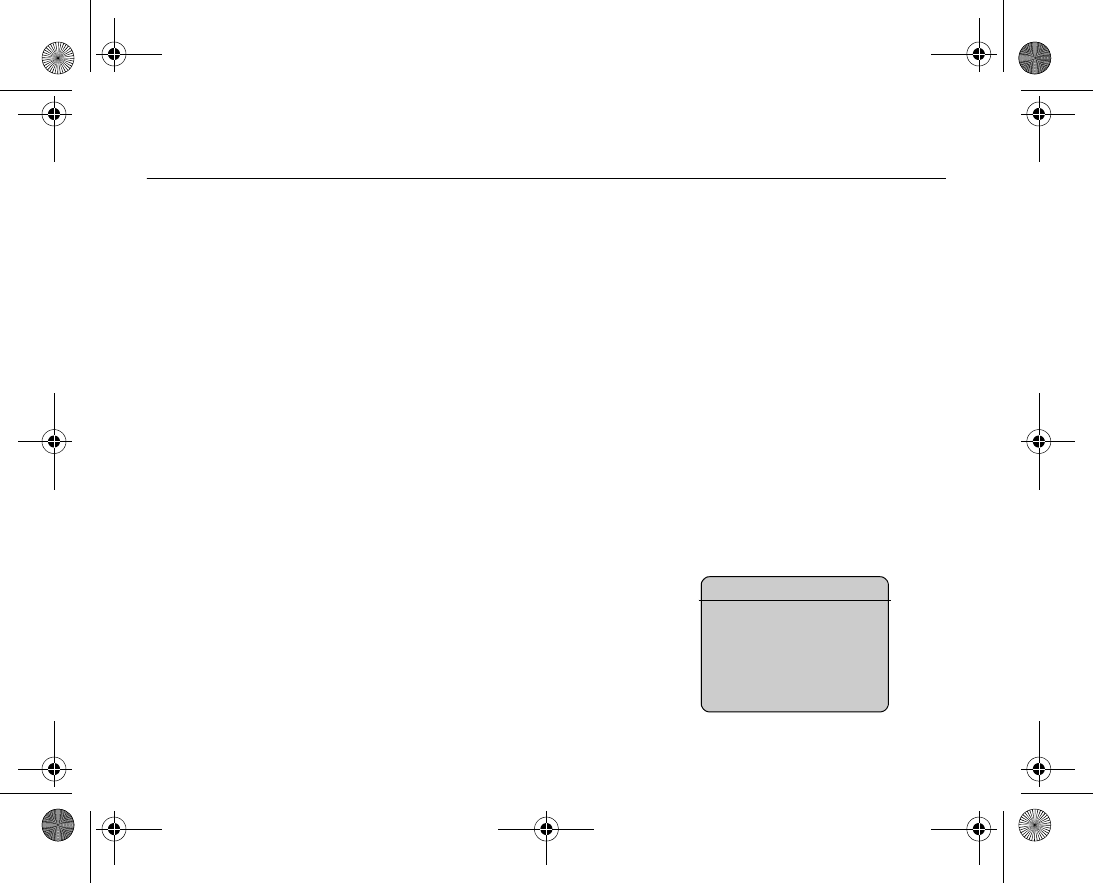
62
Picture messages (MMS) 3.2
Picture messages can contain text, pictures, video clips, camera pictures, sound
recordings, and business cards. Both you and the receiver of the picture message must
have a subscription that supports MMS. You can send picture messages to a mobile
phone or an email address, %
68 Email
.
Before you start
Before sending a picture message, make sure that:
1. The address of your message server is set } Messaging } Settings } MMS }
Message server.
2. You have entered the correct settings } Messaging } Settings } MMS } Inter
net profile. If no Internet profile exists } New profile and enter the required set
tings.
Settings may already be entered when you buy your phone. If not, you can automatically
receive all the settings in a message from Vodafone or from
www.vodafone.com
.
Creating and sending picture messages
When composing a picture message, you can select different items such as: Picture,
Text, Sound, Video, Sound recording and Page. You can also select Use camera to
take a new picture or record a new video clip.
Before sending a picture message, you can select from different options to adjust and
enhance your message.
To create and send a picture message
1. } Messaging } Create new } MMS } Add to view a list of items to add to your
message. Select an item.
Sending your business card
You can send your business
card as an attachment in a pic
ture message.
VF_Nanami_UG_R1A.book Page 62 Tuesday, June 14, 2005 10:00 AM
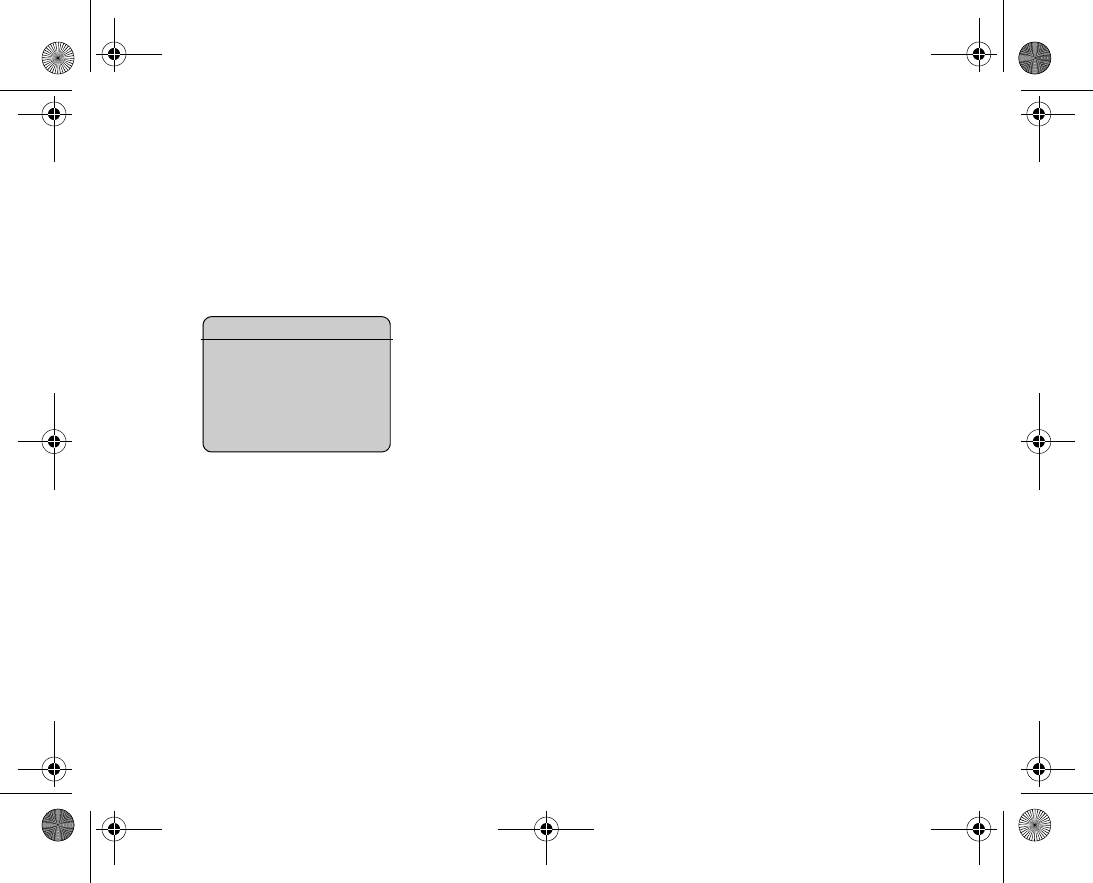
63
2. } Add to add more items to the message. You can view and select options to
enhance the message by highlighting items in the message and pressing the left
selection key.
3. When you have finished composing your message } More } Send to.
4. } Enter phone no. and enter the recipient’s phone number, or } Contacts look
up to retrieve a number or a group from Contacts. To enter an email address }
Enter Email addr.. A list below shows the last 10 recipients. You can also select a
recipient from this list. } Send.
To make a call while creating a picture message
1. While writing your message } More.
2. } Make a call and enter or retrieve a phone number } Call. You return to the mes
sage.
3. To end the call } More } End call.
Default message options
You can request a read report, a delivery report and set a priority for a specific mes
sage.
To set a default message option
} Messaging } Settings } MMS and select one of the options.
Additional send options
You can edit the message subject and add or edit recipients and attachments.
To select additional send options
When you have entered the recipient’s phone number } More and select one of the
options.
View the size of the message
The size of the message is dis
played in the top right corner of
the screen.
VF_Nanami_UG_R1A.book Page 63 Tuesday, June 14, 2005 10:00 AM
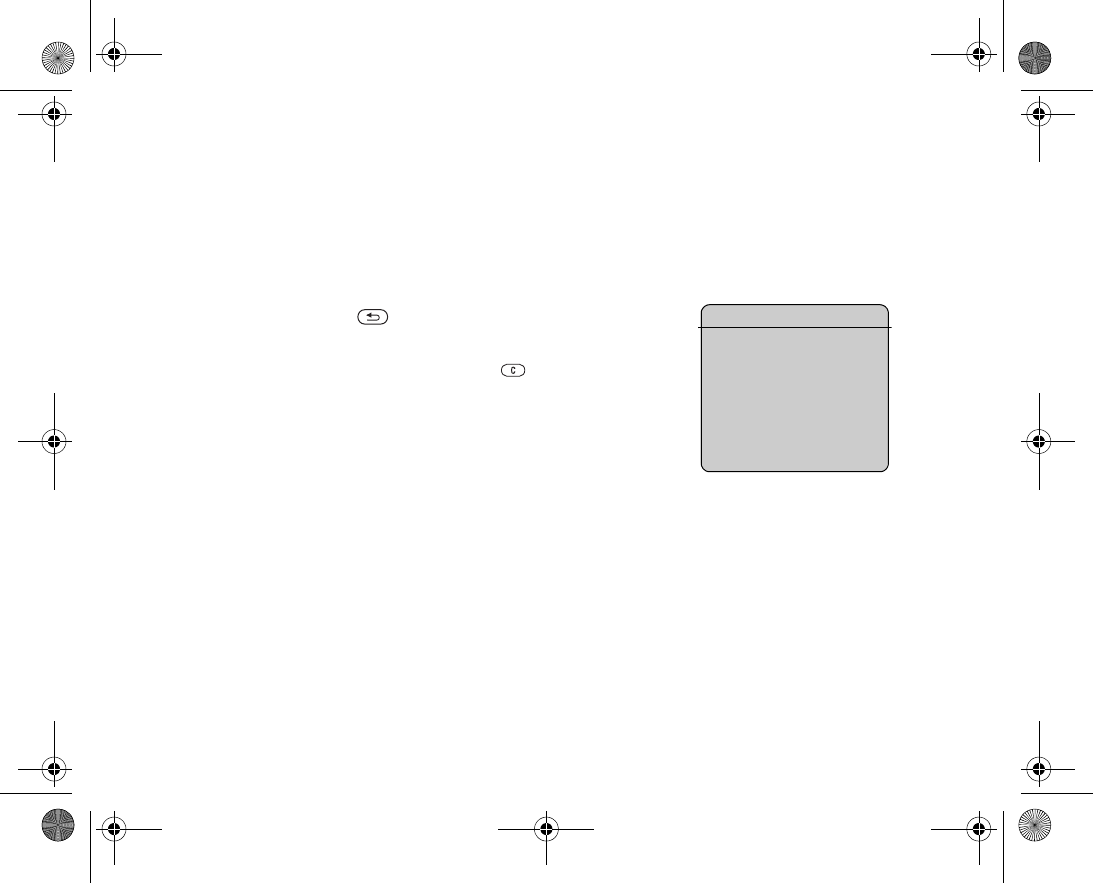
64
Receiving picture messages
When you receive an automatically downloaded picture message, the picture message
appears in the Activity menu if New events is set to Activity menu. } View to read
the message.
If New events is set to Popup, you are asked if you want to read the picture mes
sage. } Yes to read or play the message. } Stop to stop the message.
When you have read the message, select } Reply to reply immediately or select }
More to view a list of options. Press to close the message.
Note:
You can select a message from the list of messages and press to delete the entire
message.
To save items from a picture message
When you have viewed a picture message } More } Save items and select an item
from the list that appears.
Delete picture messages
Picture messages are saved in the phone memory. When the phone memory is full, you
must delete messages to be able to receive new messages, %
59 Saving and deleting
text messages
.
Templates
You can base your message on one of the templates. You can also add new templates.
To use a template for a picture message
1. } Messaging } Templates and select a template.
2. } Use } Add to add new items.
3. } More } Send to to send the message.
Saving several messages
When you want to save several
messages at a time you can use
Mark several. See the instruc
tions for %
59 Saving and delet
ing text messages
.
VF_Nanami_UG_R1A.book Page 64 Tuesday, June 14, 2005 10:00 AM
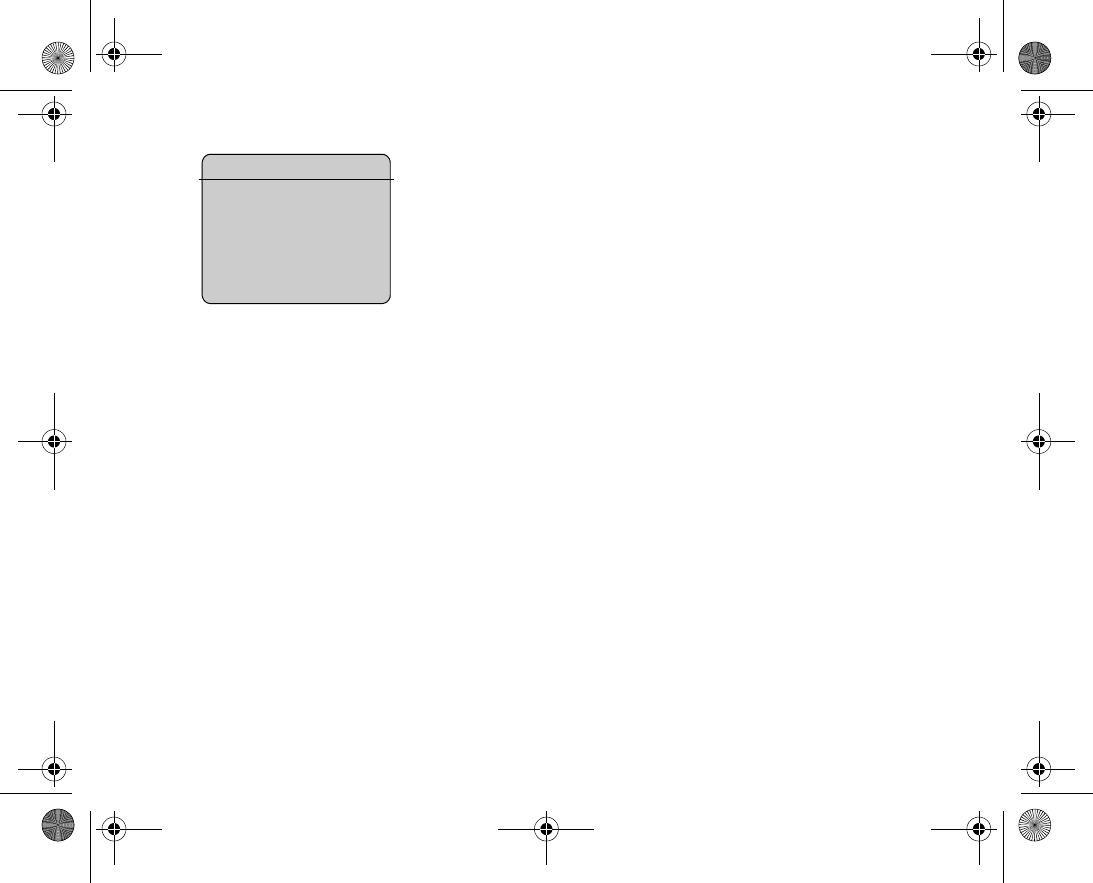
65
Automatic download
You can select how you want your picture messages to be downloaded.
} Messaging } Settings } MMS } Auto download to view the following:
•Always – your phone automatically downloads messages to your phone as soon as
they come to your network operator’s server. This is default.
•Ask in roaming – you will be asked if you want to download messages when you
are in a network other than your home network.
•Not in roaming – the messages are never downloaded when you are in a network
other than your home network.
•Always ask – You will always be asked if you want to download messages, regard
less of network used.
•Off –New messages appear in the inbox as icons. Select the message } View to
download.
Downloading messages
You can always download previ
ously not downloaded messages
in the Inbox by highlighting the
message } View.
VF_Nanami_UG_R1A.book Page 65 Tuesday, June 14, 2005 10:00 AM
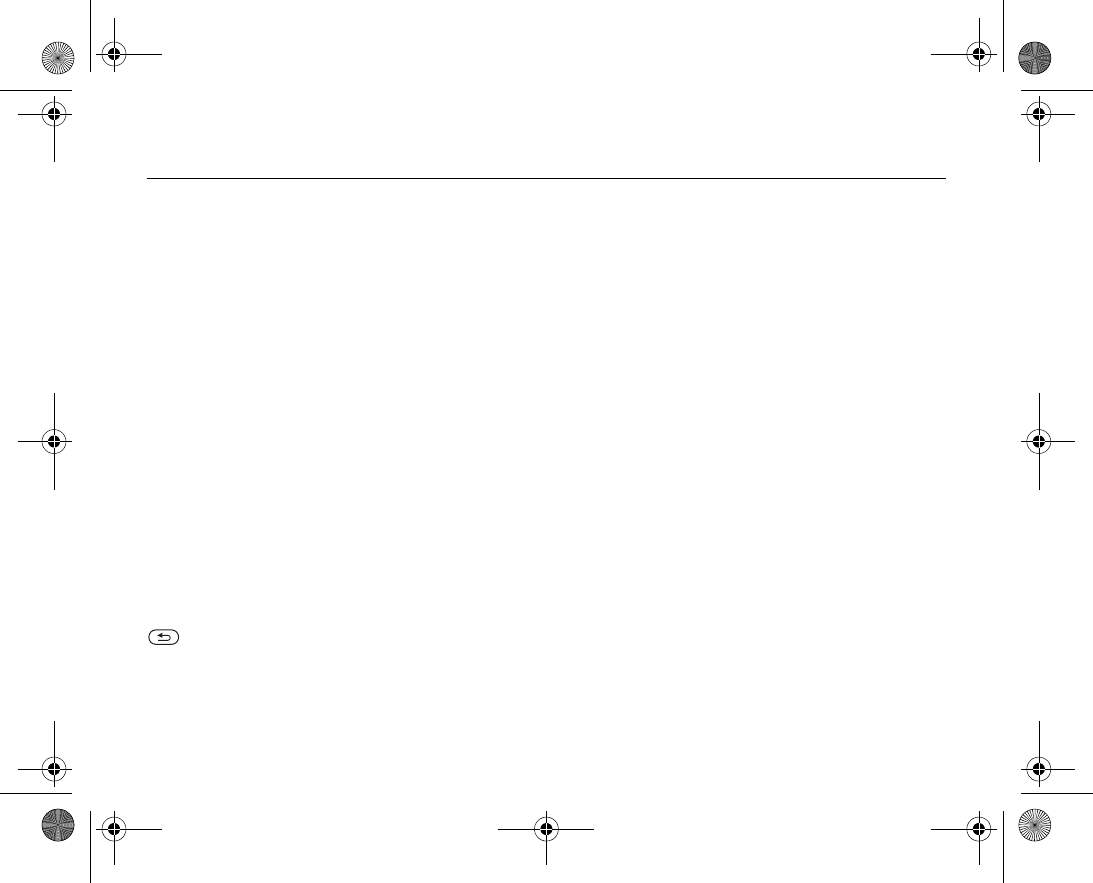
66
Voice messages 3.3
Voice messages offer a quick way to send and receive sound recordings as messages.
A voice message can only contain one sound recording. Both you and the receiver of
the voice message must have a subscription that supports MMS.
To record and send a voice message
1. } Messaging } Create new } Voice message. The sound recorder starts.
2. Record your message. } Stop to end the recording.
3. } Send to send the message.
4. } Enter phone no. and enter the phone number of the recipient, or } Contacts
lookup to retrieve a number or a group from Contacts. To enter an email address }
Enter Email addr.. A list below the send options shows the last 10 recipients. You
can also select a recipient from this list. } Send.
Receiving voice messages
When you receive a voice message, the voice message appears in the Activity menu if
New events is set to Activity menu. } Play to listen to the message.
If New events is set to Popup, you are asked if you want to listen to the voice mes
sage. } Yes to listen to the voice message or } No if you want to listen to the message
later.
When you have listened to the voice message } More to view a list of options. Press
to close the message.
VF_Nanami_UG_R1A.book Page 66 Tuesday, June 14, 2005 10:00 AM
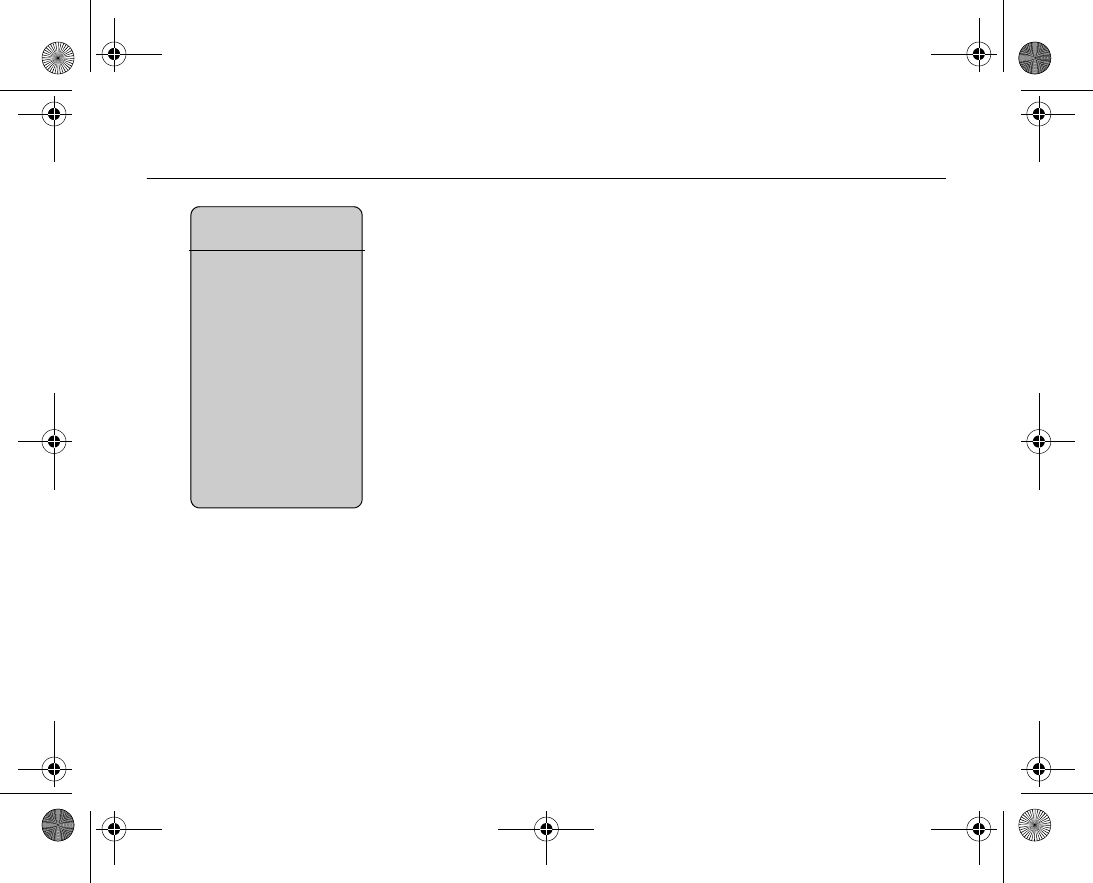
67
Postcard 3.4
As part of Vodafone live! you can have a message with picture and text delivered as a
postcard to a street address.
To send a postcard
1. } Messaging } Create new } Live! Postcard.
2. Select Picture to add a picture to your postcard, or Use camera if you want to take
a picture to include in the postcard.
3. Write message to accompany the picture } OK.
4. } Send to } Address to enter name and address, or you can either select Con
tacts lookup to retrieve a contact, or select a recipient from the list of previous
recipients.
5. When you have entered name and address } OK } Send. The picture and message
will be printed on a postcard and sent to the address that you select.
To view a sent postcard
} Messaging } Sent messages and highlight the message } View.
Note:
Visit www.vodafone.com, or www.vodafone.co.uk/postcards in the UK, for details. This
service is not available in all countries.
More ways of sending post
cards
Another way of sending a
postcard is to use contacts
by selecting a contact, More
} Send message } Live!
Postcard.
You can also create a post
card by selecting My Items
} Pictures. Select a picture
} More } Send } Live!
Postcard
VF_Nanami_UG_R1A.book Page 67 Tuesday, June 14, 2005 10:00 AM
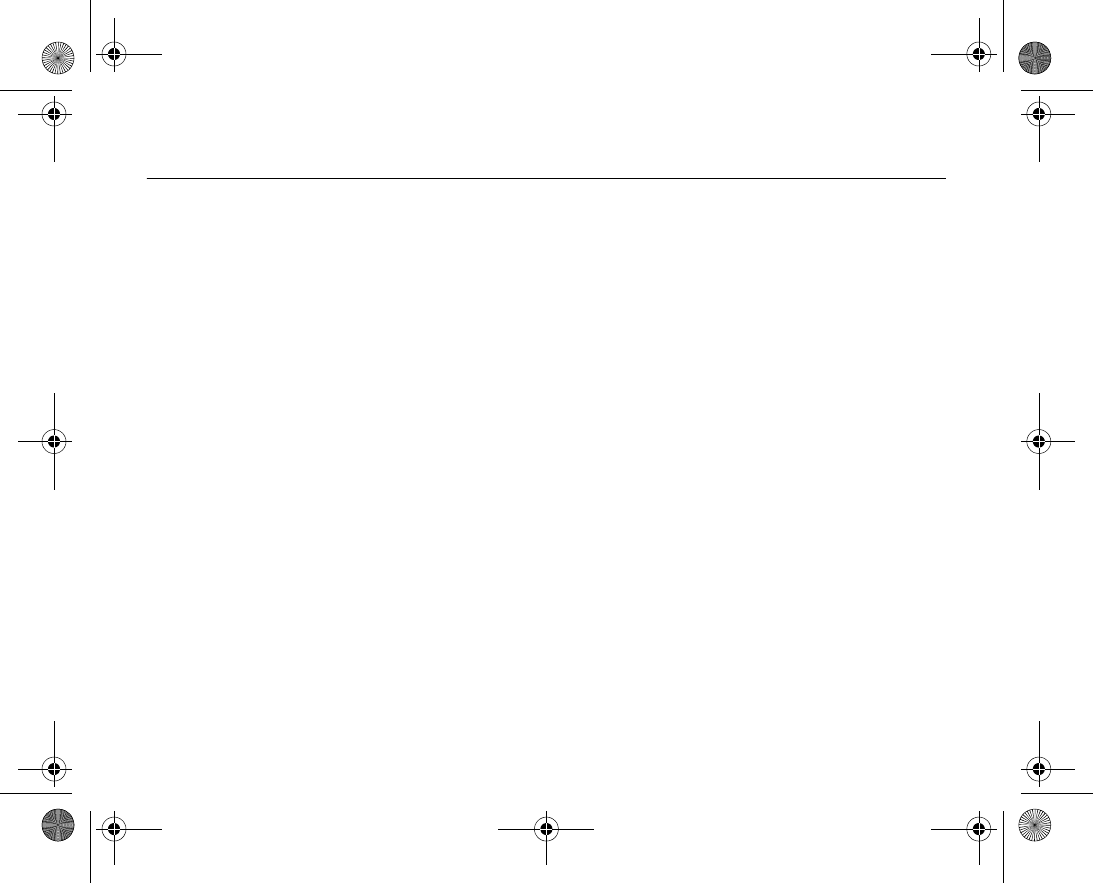
68
3.5 Email
You can use your phone to send and receive email messages. Please note that you
need a subscription that supports data transmission. For more information, contact
Vodafone Customer Service.
Before you start
First make sure that:
• Settings are in your phone, if not, %
119 Settings
.
• You have set up and selected an email account. The necessary settings for Vodafone
mail have been preconfigured in your phone. However, you must configure your per
sonal Vodafone Mail user name and password. If you are not a Vodafone Mail cus
tomer, visit
www.vodafone.com/live
for more information or call Vodafone Customer
Services.
Default email account
If you have both an office and a home email account, you can set one of them as
default:
} Messaging } Email } Settings } Account settings and select an account.
To write and send an email message
1. } Messaging } Email } Create new.
2. Write the subject for your message } Continue and then write the text } Continue.
3. } Enter Email addr. to enter an email address or } Contacts lookup to retrieve
an address from Contacts.
4. Select } Send to send your email message or select } More to view a list of options
for your message.
VF_Nanami_UG_R1A.book Page 68 Tuesday, June 14, 2005 10:00 AM
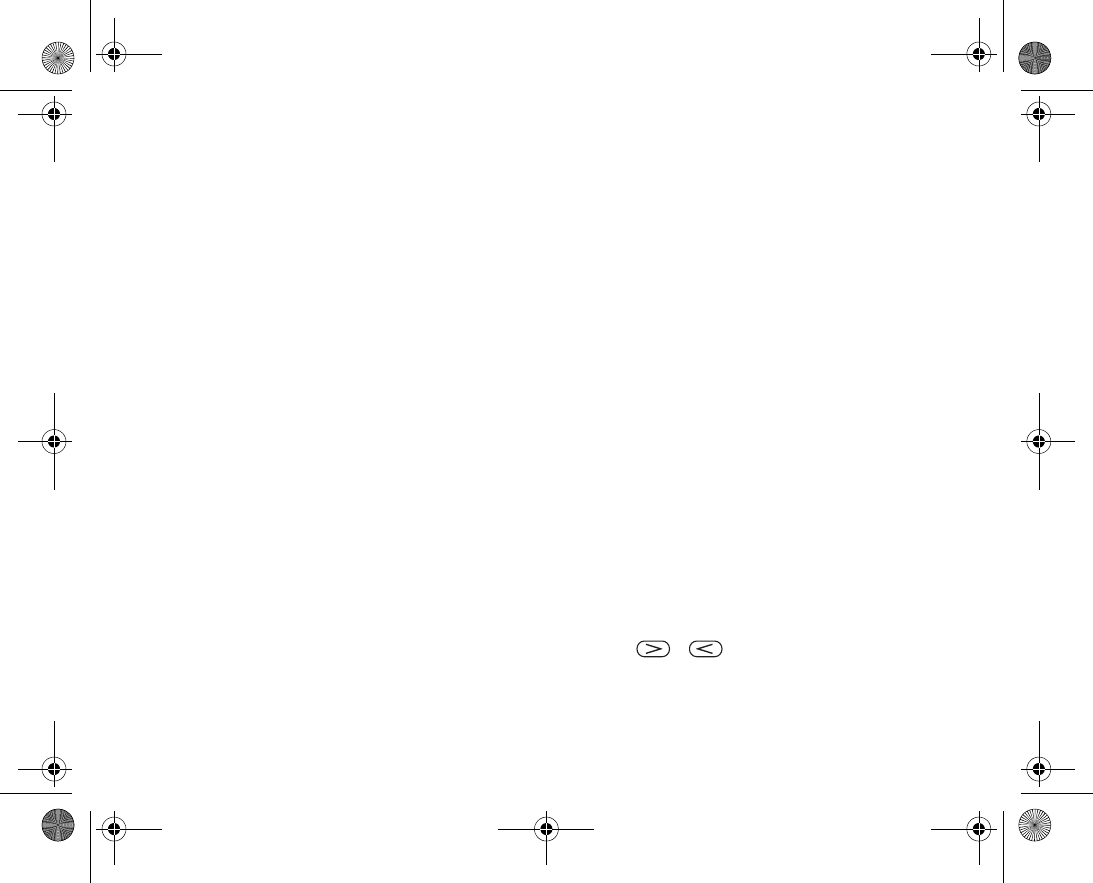
69
To send, receive and read email messages
1. } Messaging } Email } Inbox } Send&rec (when inbox is empty) or } Messag
ing } Email } Inbox } More } Send & receive to send or download new mes
sages.
2. Select a message } View to read it.
To reply to an email message
1. Open the email message } Reply.
2. } Include message to include the original message in your reply or } Create new
to exclude the original message. Write your message } Continue.
3. } Enter Email addr. to enter an email address or } Contacts lookup to retrieve
an address from Contacts.
4. Select } Send.
To save an email address or a phone number in an email message
1. Select the email address or phone number that you want to save } More.
2. To save an email address } Save address. To save a phone number } Use } Save
number.
To save an email message
1. Open the email message } More } Save message } Saved Email.
2. The message is saved in Saved Email in the Email menu.
Note:
The number of email messages that can be saved depends on how much memory there is left
in the phone. From standby, press
or
to view status information.
All email mes
sages are also saved on your email server, and you can view both older and newer messages
on the server.
VF_Nanami_UG_R1A.book Page 69 Tuesday, June 14, 2005 10:00 AM

70
To save several email messages
1. } Messaging } Email } Inbox.
2. Select a message } More } Mark several.
3. Scroll and select more messages by pressing Mark or Unmark.
4. } More } Save messages.
To delete an email message (POP3 users)
1. } Messaging } Email } Inbox and select the message } More.
2. } Mark for deletion. The message is deleted the next time you connect to your
email server. If you want to delete several messages } Mark several. Scroll and
select more messages by pressing Mark or Unmark. } More } Mark for dele
tion.
To delete an email message (IMAP4 users)
1. } Messaging } Email } Inbox and select the message } More.
2. } Mark for deletion. The message is marked for deletion on the server. If you want
to delete several messages } Mark several. Scroll and select more messages by
pressing Mark or Unmark. } More } Mark for deletion.
3. } More } Clear inbox. and select With send & rec. or No send & rec. to delete
messages.
VF_Nanami_UG_R1A.book Page 70 Tuesday, June 14, 2005 10:00 AM
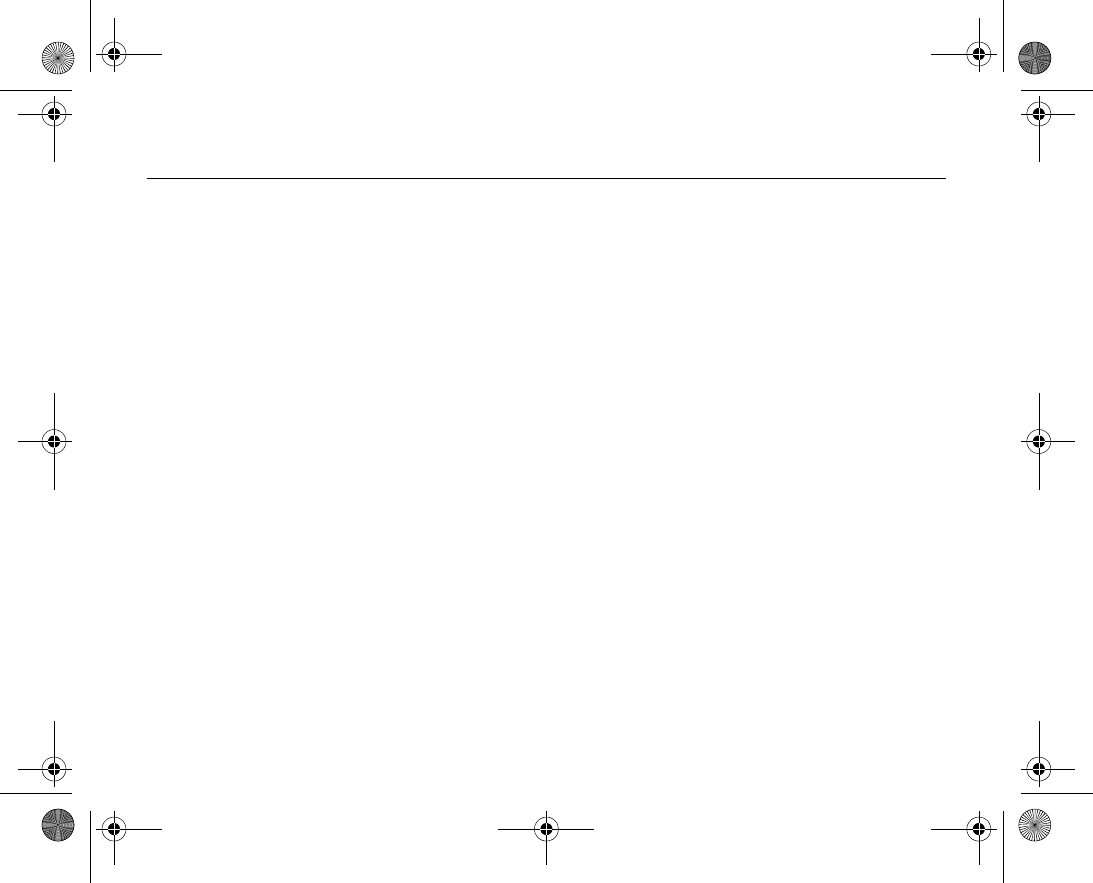
71
Vodafone Messenger 3.6
Messenger
Connect and log in to the Messenger server to communicate online with your favourite
contacts. If your subscription supports it, you can see contact status if they are online,
and send and receive instant messages.
Note:
Visit www.vodafone.com for details. This service (menu option) is not available in all
countries.
To log in to your Messenger server
} Messaging } Messenger } Myself } Log in.
List of contacts
You can create a list of contacts from your Messenger server, people you want to send
messages to on a regular basis.
To add a contact
} Messaging } Messenger } More } Add contact and select an option.
To send an instant message from Messenger
1. } Messaging } Messenger and select a contact.
2. } Send IM and type your message } Send.
Status
You can change your status shown to others. You can also choose to display it for your
contacts only or for all users on the Messenger server.
VF_Nanami_UG_R1A.book Page 71 Tuesday, June 14, 2005 10:00 AM

72
To change your own status
} Messaging } Messenger }Myself } Change.
Chatroom
A chatroom can be started by your service provider, by an individual Messenger user or
by yourself. You can save chatrooms either by saving a chat invitation or by searching
for a specific chatroom.
To start a chatroom
1. } Messaging } Messenger } More } Start chatroom.
2. Select contacts to invite to the chatroom from your list of contacts } Continue.
3. Enter a short invitation text } Continue } Send.
VF_Nanami_UG_R1A.book Page 72 Tuesday, June 14, 2005 10:00 AM
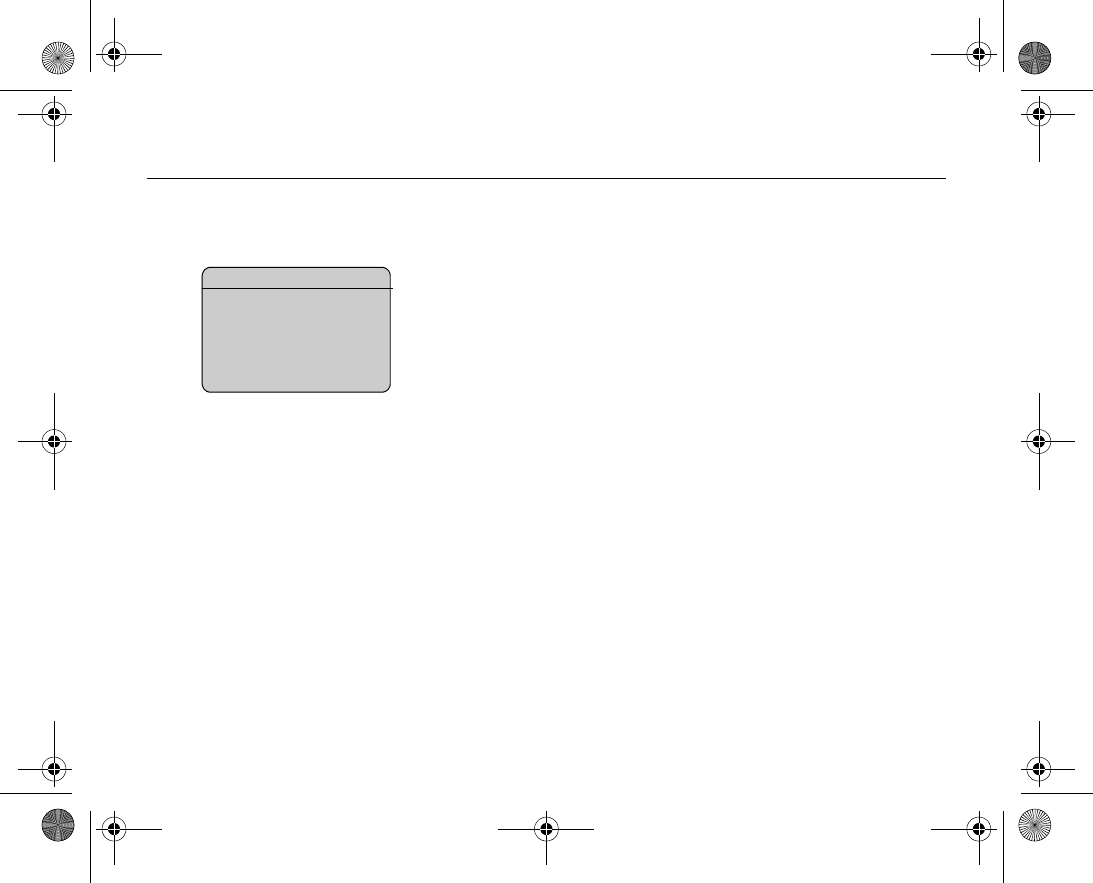
73
Area information 3.7
Area information is a type of text message that is sent to all subscribers within a certain
network area. When you receive an area information message, the message automati
cally appears on the screen. Press Save to save the message in your inbox, or Discard
to delete the message.
To turn area information on or off
} Messaging } Settings } Area info } Reception.
Cell information
The cell information channel is used by some network operators to send messages
about a certain network area to their subscribers within that area.
To turn on cell information
} Messaging } Settings } Area info } Cell information.
Area information
Please consult your service pro
vider for more information
about area information.
VF_Nanami_UG_R1A.book Page 73 Tuesday, June 14, 2005 10:00 AM

74
VF_Nanami_UG_R1A.book Page 74 Tuesday, June 14, 2005 10:00 AM

75
Pictures and sounds
Here you can see how to take photos and record video clips. These
can be sent as messages or uploaded to a personal album on
Vodafone live!. With the Postcard function, you can learn how to
send photos as a traditional postcard.
You can also see how to compose your own melodies using
MusicDJ™ and record sounds with the sound recorder.
VF_Nanami_UG_R1A.book Page 75 Tuesday, June 14, 2005 10:00 AM
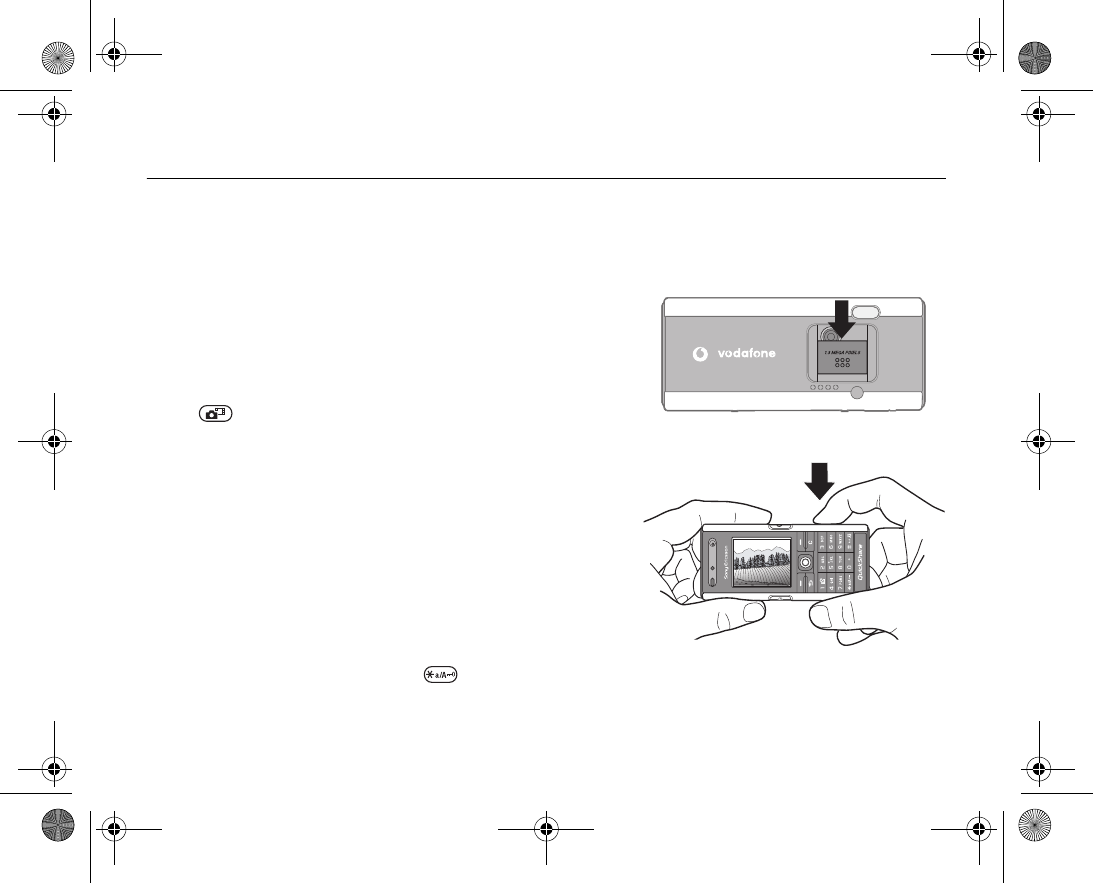
76
Camera and video recorder 4.1
Your phone has a digital camera which also works as a digital video recorder. You can
take pictures, record video clips, save and view them and send them as email attach
ments, %
68 To write and send an email message
, or send them in picture messages
via MMS, %
62 To create and send a picture message
.
To activate the camera
While in standby, slide the lens cover to activate the camera.
To take pictures and video clips
1. Use the navigation key to switch between camera and video recorder.
2. Press to take a picture or start recording.
3. To end video recording, press again. To deactivate the camera, close the lens cover.
Note:
If you try to record a strong light source such as direct sunlight or a lamp, the screen
may black out or the picture may be distorted
To use the zoom
Use the volume buttons on the side of the phone to zoom in and zoom out.
To adjust brightness
Use the navigation key to increase or decrease brightness.
To turn on the photo light
To take pictures in a dimly lit environment, press .
VF_Nanami_UG_R1A.book Page 76 Tuesday, June 14, 2005 10:00 AM

77
To view your pictures and video clips
When the camera or video is activated } View.
Camera and video options
When the camera or video is activated } Settings to view more options. Before you
take a picture or make a video clip, the following options are available:
•Switch to video camera – to record a video clip instead of taking a picture.
•Switch to still camera – to take a picture instead of recording a video clip.
•Shoot mode
(camera)
– select from Normal for no frame, Panorama to combine
several pictures into one wide picture, Frames to add a frame to your picture and
Burst to take four pictures in rapid succession.
•Shoot mode (video) – select High quality video or For MMS if you want to send
your video clip as a picture message.
•Picture size – choose between 1280x1024, 640x480 and 160x120. All phones
that support pictures can receive the size 160x120.
•Video size – choose between Large 176x144 and Small 128x96.
•Turn on night mode – enhance picture or video quality in poor lighting conditions
with longer exposure time.
•Turn on light – to enhance lighting conditions.
•Turn on selftimer – the picture is taken a few seconds after you press the camera
button.
•Effects – select different effects for your picture or video.
•White balance – adjust the picture or video colour to the lighting conditions.
•Picture quality – choose between Normal and Fine picture quality.
•Turn on time and date – add a time and date to your picture.
VF_Nanami_UG_R1A.book Page 77 Tuesday, June 14, 2005 10:00 AM
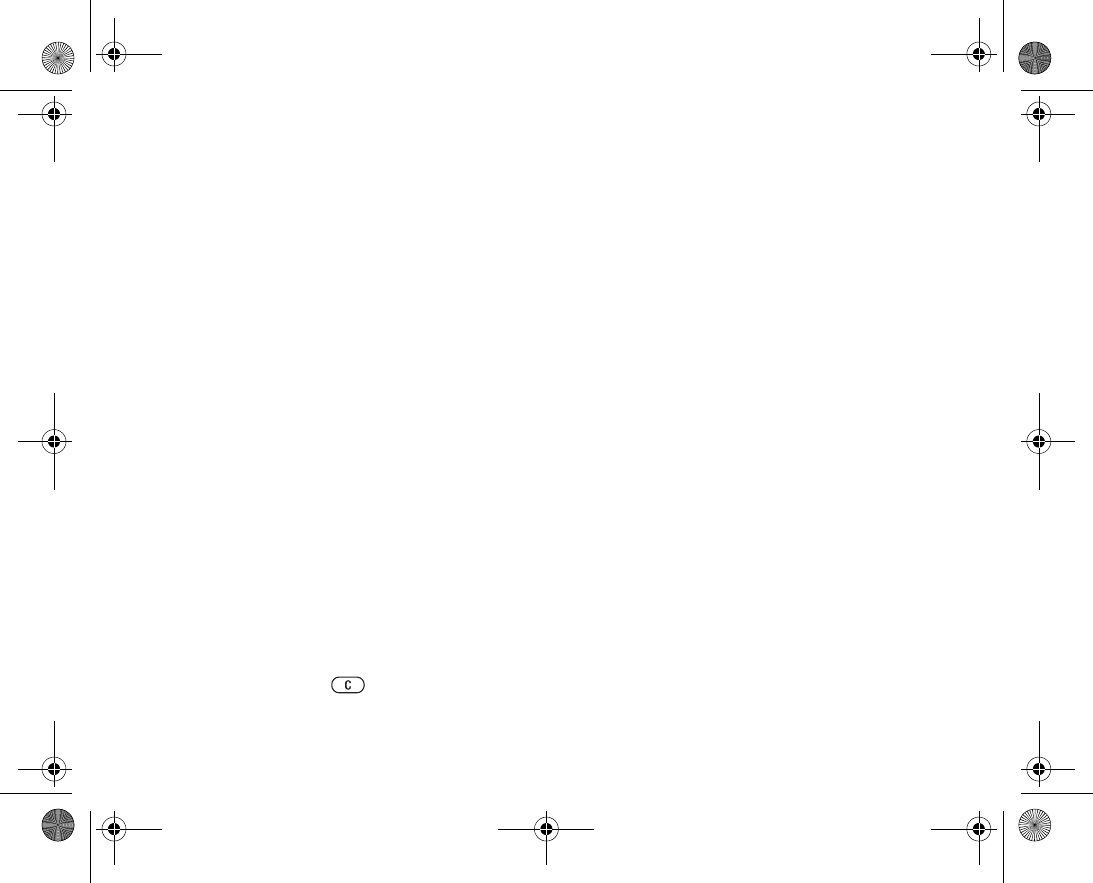
78
Saving pictures and video clips
When you have taken a picture or recorded a video clip, it is saved in the phone mem
ory, %
33 My items
. You can also choose to store your pictures and video clips on your
computer, %
117 Transferring files using the USB cable
.
Sending pictures and video clips
When you have taken a picture or recorded a video clip, you can send it as a picture
message if the file size has not exceeded the limit, %
62 Creating and sending picture
messages
. For settings that affect the file size, %
77 Camera and video options
.
Before you start the receiving phone needs to support data transmission and picture
messaging in order to receive and show the picture or video clip.
• Before you send a picture or video clip using picture messaging make sure that you
have set the address of your message server for picture messaging, %
62 Picture
messages (MMS)
and that Internet settings are entered in your phone, %
94 Set
tings
.
• Before you send a picture or video clip using email make sure that you have entered
settings for a data account and for an email account in your phone, %
68 Email
.
To exchange pictures and video clips using other transfer methods %
82 Exchanging
pictures
.
To send a picture
When you have taken a picture } Send to send the picture.
To send and play video clips
When you have finished your recording, } Send to send the video clip.
} More } Play to play or press to delete the video clip.
VF_Nanami_UG_R1A.book Page 78 Tuesday, June 14, 2005 10:00 AM
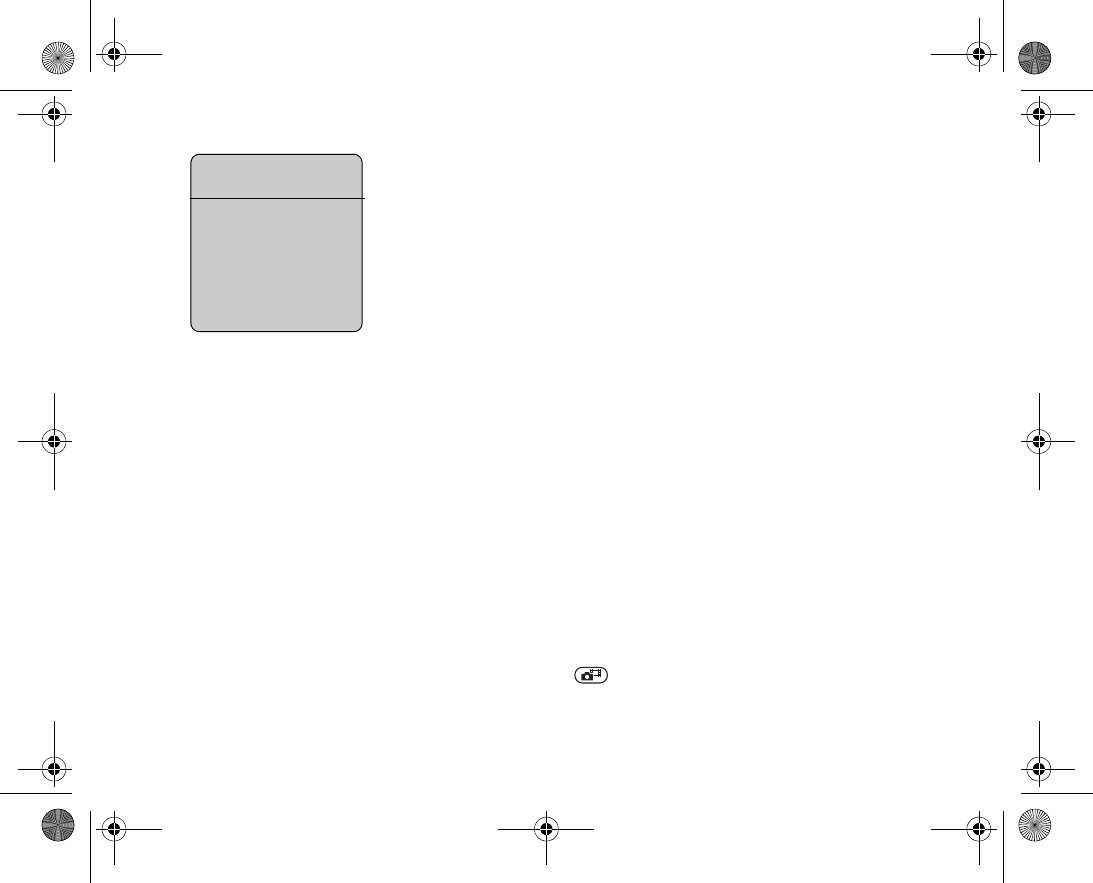
79
Postcard
As part of
Vodafone live!
you can have a message with picture and text delivered as a
postcard to a street address.
To send a postcard
1. Take the picture by pressing the camera button.
2. } Send } Live! Postcard.
3. Write your message } OK.
4. } Send } Address to enter name and address, or you can either select Contacts
lookup to retrieve a contact, or select a recipient from the list of previous recipi
ents.
5. When you have entered name and address } OK } Send. The picture and message
will be printed on a postcard and sent to the address that you select.
Note:
Visit www.vodafone.com, or www.vodafone.co.uk/postcards in the UK, for details. This
service is not available in all countries.
live! Studio
With
Vodafone live!
, you can save pictures in a Webbased album. This is useful if you
are running out of phone memory, or if you wish to share your pictures with friends in a
virtual album that they (and you) can access on the Web. You can upload a picture in the
following ways:
To upload a picture
•} My Items } Pictures, select a picture, More } Send } live! Studio.
•From the camera, } Send } live! Studio.
• You can also upload a message by selecting a folder in Messaging, highlight a
message, More } live! Studio.
More ways of sending post
cards
You can also create a post
card by selecting My Items
} Pictures. Select a picture
} More } Send } Live!
Postcard.
VF_Nanami_UG_R1A.book Page 79 Tuesday, June 14, 2005 10:00 AM

80
Note:
Visit www.vodafone.com for details. This service is not available in all countries.
VF_Nanami_UG_R1A.book Page 80 Tuesday, June 14, 2005 10:00 AM
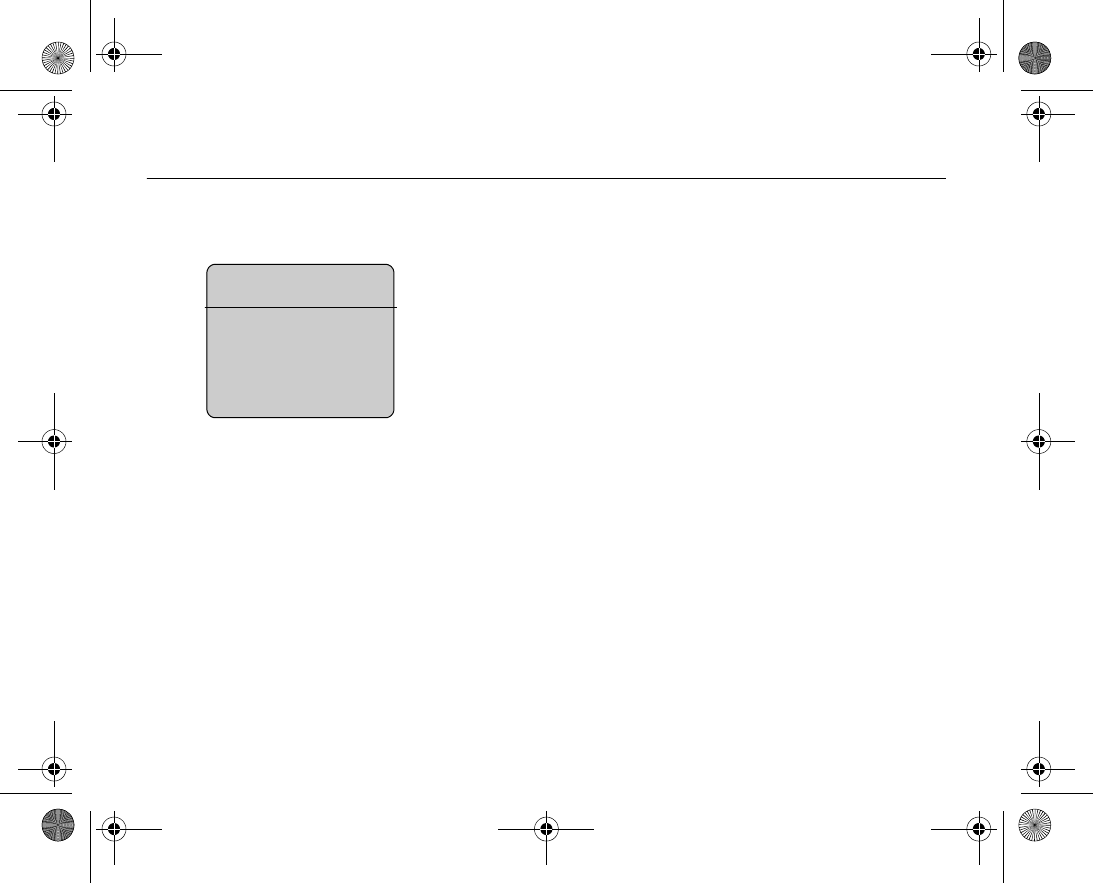
81
Pictures 4.2
Your phone comes with a number of pictures and animations. You can delete these pic
tures if you want to free memory. All pictures are saved in My Items } Pictures. You
can:
• Use a picture as wallpaper and as a screen saver.
• Assign a picture to a contact. %
37 To add a picture or a ringtone to a phone contact
.
• Exchange pictures using one of the available transfer methods.
• Upload pictures to the Vodafone live! Studio, %
79 live! Studio
.
Handling pictures
You can add, edit and delete pictures in My Items. The number of pictures that you can
save depends on the size of the pictures, %
81 To view information about a picture or
video clip
. File types supported are, for example, GIF, JPEG, WBMP, BMP, PNG and SVG
Tiny.
To view your pictures
1. } My Items } Pictures.
2. The pictures are shown in thumbnail view. To get a full view } View.
To display pictures in a slide show
1. } My Items } Pictures and scroll to a picture.
2. } View } More } Slide show.
To view information about a picture or video clip
1. } My Items } Pictures or Videos, select the picture or video clip.
2. } More } Information.
Setting screen savers and wall
papers from My Items
} My Items } Pictures, high
light a picture } More } Use
as } Screen saver or
Wallpaper
VF_Nanami_UG_R1A.book Page 81 Tuesday, June 14, 2005 10:00 AM
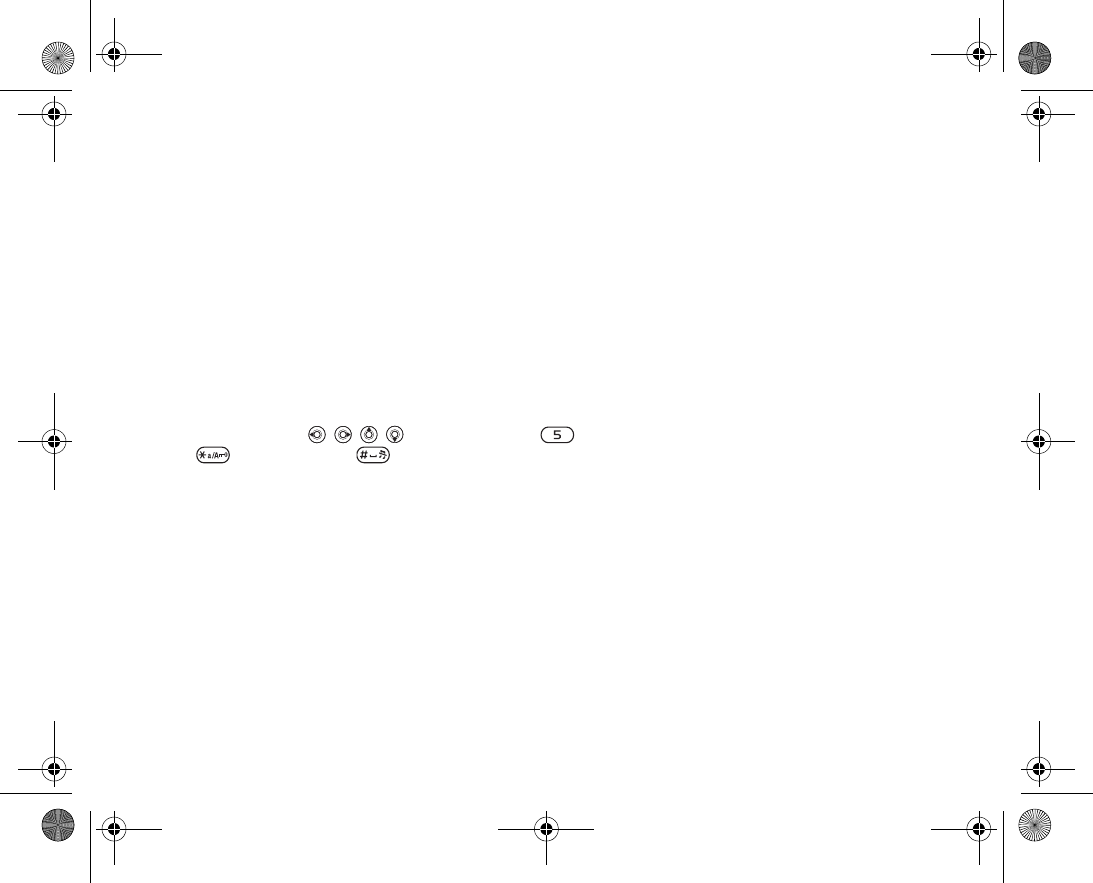
82
Using pictures
You can use a picture for several purposes, for example, add it to a contact, use it in the
startup screen, or use it as a screen saver.
The screen saver is activated automatically when you have not pressed any key for a
few seconds. After a few more seconds, the screen saver changes to sleep mode, to
save power. Press any key on the keypad and the screen turns on again. If you have a
picture as wallpaper, this picture is shown in standby mode.
To use a picture
1. } My Items } Pictures and scroll to the picture you want to use } More } Use
as.
2. Select what you want to use the picture for.
PhotoDJ™
When editing pictures press , , , and the following keys: to activate
the tool, to select the tool and to select a colour.
To edit and save a picture
1. } Entertainment } PhotoDJ™ and scroll to the picture you want to edit } Select.
Some pictures you have taken with the camera can be edited.
2. To save the edited picture } More } Save picture.
Exchanging pictures
You can exchange pictures using one of the available transfer methods. Please note
that you are not allowed to exchange copyrightprotected material. For more informa
tion on sending pictures in messages %
62 Picture messages (MMS)
.
To send a picture
} My Items } Pictures and scroll to the picture you want. } More } Send and select
a transfer method.
VF_Nanami_UG_R1A.book Page 82 Tuesday, June 14, 2005 10:00 AM

83
To receive and save a picture
1. Open the message you received the picture in, or turn on Bluetooth or the infrared
port if one of these transfer methods was used to send the picture.
2. If you received the picture in a message, select the picture and save it. If you
received the picture via Bluetooth or infrared, follow the instructions that appear on
the screen.
Note:
All phones that support pictures can receive the picture size 160x120. Some phones
that support pictures cannot receive picture sizes of more than 160x120. The best pic
ture size to view on a computer is 1280x1024.
Remote screen
You can view your pictures on a remote screen, for example, a TV, using a compatible
Bluetooth adapter. The adapter is an accessory and not included in the box. You can
then use the phone to control the screen. Use the slide show function to show several
pictures in succession.
To connect to a remote screen
} My Items } Pictures and scroll to the picture you want } View } More } Remote
screen. The phone searches for other Bluetooth devices and a list of available devices
is displayed. Select the device you want to use.
VF_Nanami_UG_R1A.book Page 83 Tuesday, June 14, 2005 10:00 AM
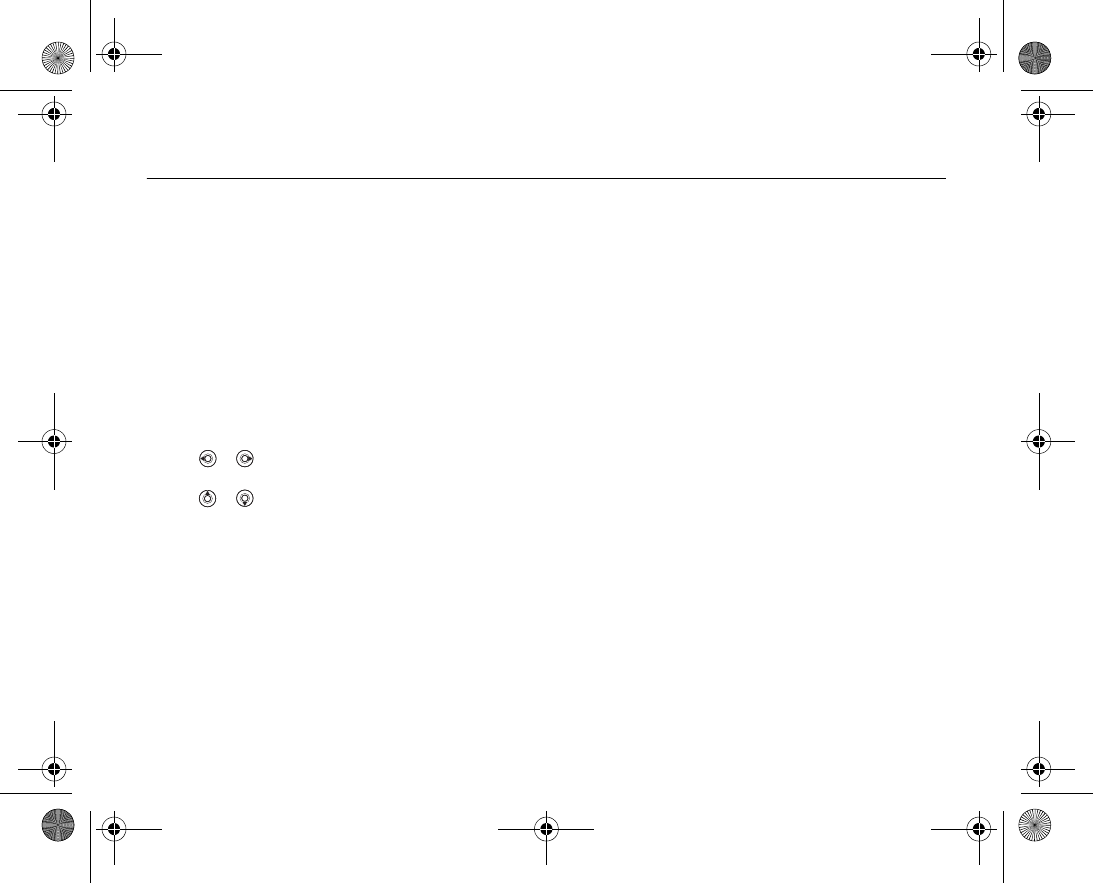
84
Radio 4.3
Your phone features an FM radio with RDS functionality. To use the radio, you must con
nect the handsfree to your phone. The handsfree works as an antenna and makes the
reception better. The radio can be used as an alarm signal, %
136 Alarm clock
.
Note:
You must switch your phone on to use the radio. Do not switch the phone on in areas
where mobile phones are prohibited,
%
166 Guidelines for Safe and Efficient Use.
To listen to the radio
Connect the handsfree to your phone } Radio.
Radio control
•} Search to find the next channel on the band.
• Press or to move 0.1 MHz along the FM band. Press and hold to move con
tinuously.
• Press or for the next preset channel.
Saving radio channels
You can save up to 20 of your favourite radio channels.
Note:
To save channels quickly in positions 1 to 10, press and hold 0–9, (where 0 represents
the number 10). To select a channel you have saved in positions 1 to 10, press 0–9.
To save a radio channel
} More } Save } Insert. The channel is saved in a list.
VF_Nanami_UG_R1A.book Page 84 Tuesday, June 14, 2005 10:00 AM
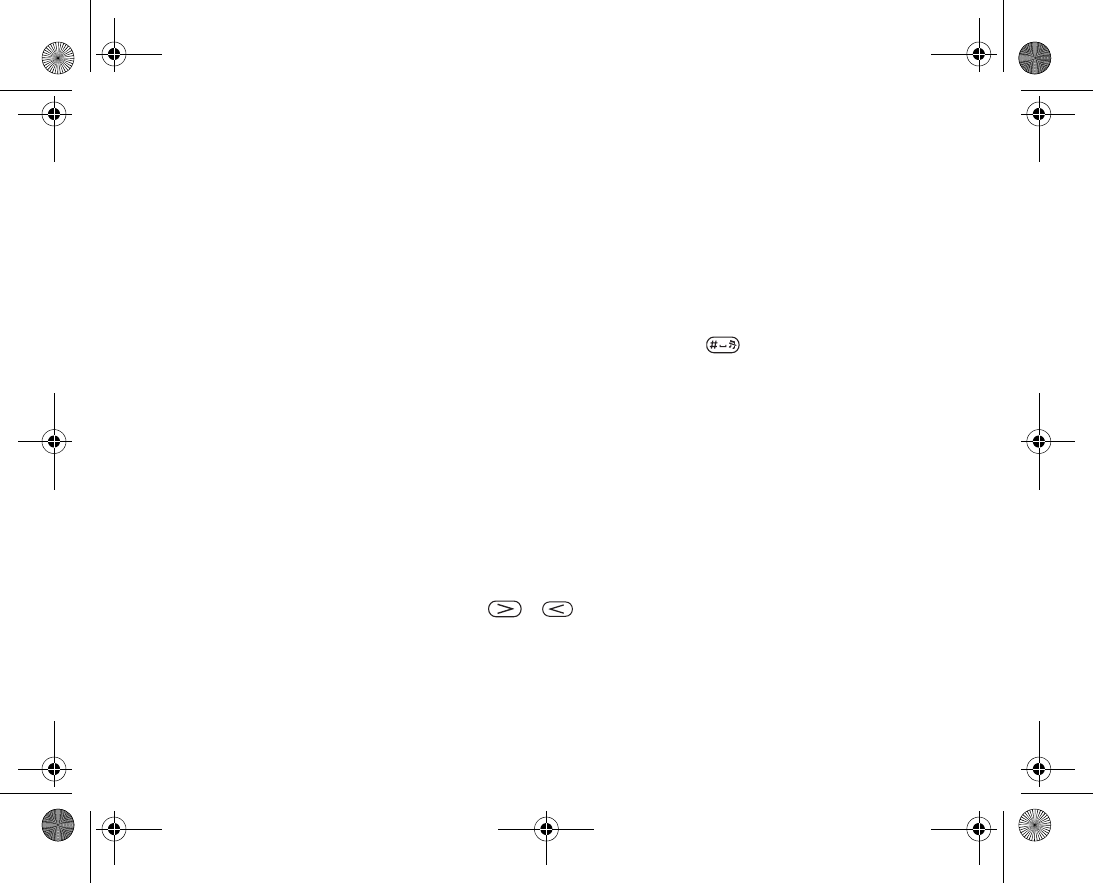
85
Radio options
} More for the following options:
•Minimize – return to standby to use other functions with the radio still playing.
•Save – save the current frequency in a list of channels.
•Channels – select, rename, replace or delete saved channels.
•Turn on speaker – listen through the loudspeaker.
•Auto save – automatically search for and save channels in a list of channels. Previ
ously saved channels will be replaced.
•Set frequency – enter a frequency manually. The figures you enter will be automat
ically adjusted to valid frequencies. Press to go directly to Set frequency.
•RDS – options to turn on or off alternative frequency (AF) and to show or hide station
information.
•Turn on Mono – turn mono sound on.
While listening to the radio
If you minimize the radio display, you can listen to the radio and use another functional
ity at the same time. For example, you can make and receive calls, send messages and
play games.
To minimize the radio display
} Radio } More } Minimize.
To adjust the volume
Press or .
VF_Nanami_UG_R1A.book Page 85 Tuesday, June 14, 2005 10:00 AM
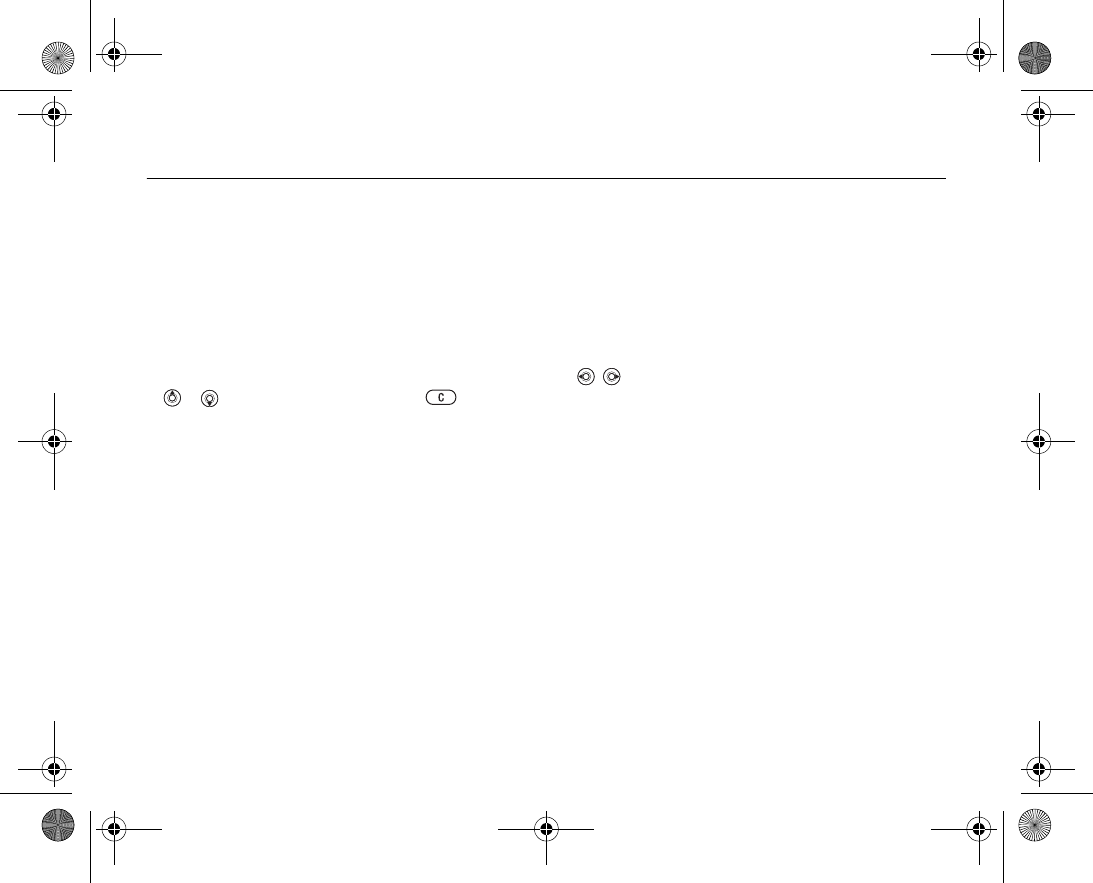
86
Composing melodies 4.4
You can compose and edit melodies to use as ringtones using the MusicDJ™. A melody
consists of four types of tracks – Drums, Basses, Chords, and Accents. A track con
tains a number of music blocks. The blocks consist of prearranged sounds with differ
ent characteristics. The blocks are grouped into Intro, Verse, Chorus and Break. You
compose a melody by adding music blocks to the tracks.
To compose a melody
1. } Entertainment } MusicDJ™.
2. Choose to Insert, Copy and Paste blocks to compose your melody. Use , ,
or to move between the blocks. Press to delete a block. } More to
view more options.
To edit a previously created melody
} My Items } Sounds and select the melody } More } Edit.
Sending and receiving
You can send and receive melodies using one of the available transfer methods. Please
note that you are not allowed to exchange copyrightprotected material.
Note:
You cannot send a polyphonic melody or an MP3 file in a text message.
To send a melody
1. } My Items } Sounds and select a melody.
2. } More } Send and select a transfer method.
VF_Nanami_UG_R1A.book Page 86 Tuesday, June 14, 2005 10:00 AM

87
To receive a melody
1. Open the message you received the melody in, or turn on Bluetooth or the infrared
port if these transfer methods are being used to send the melody.
2. When you receive the melody, follow the instructions that appear on the screen.
VF_Nanami_UG_R1A.book Page 87 Tuesday, June 14, 2005 10:00 AM
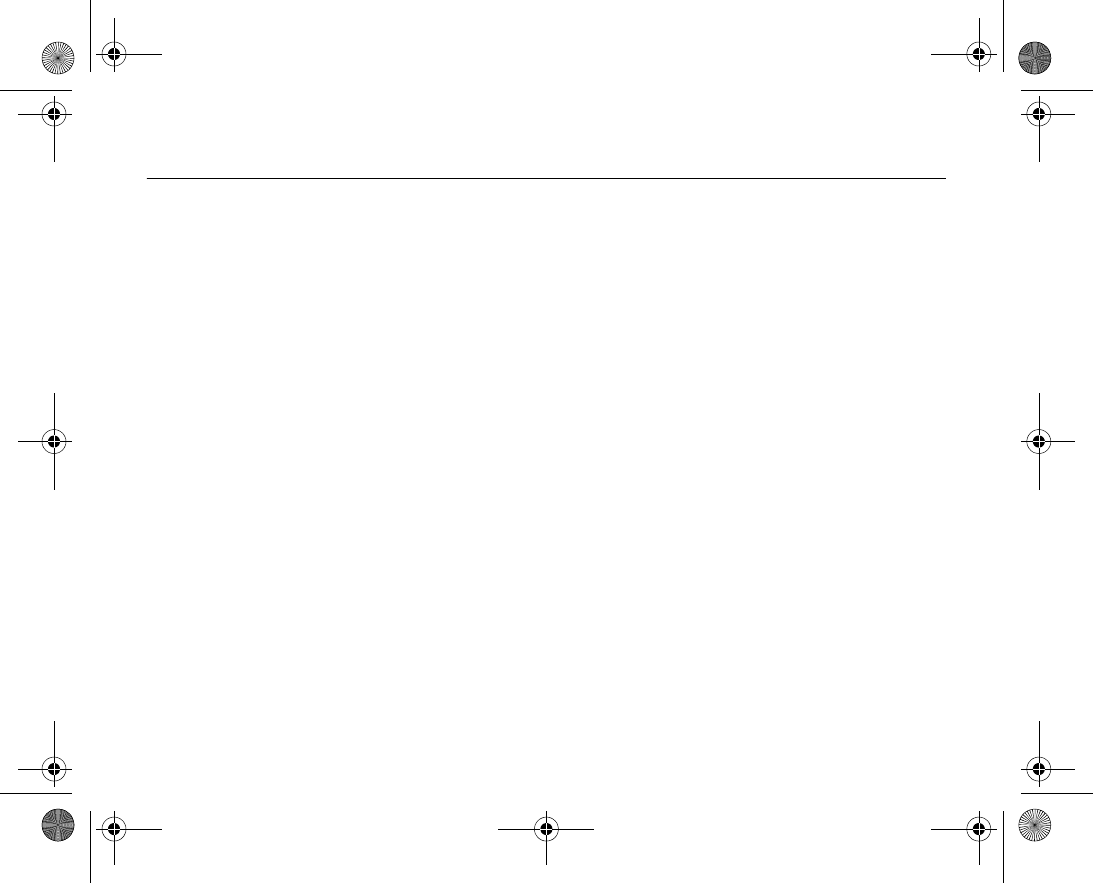
88
Creating movies 4.5
With the VideoDJ™, you can create movies by combining video clips and pictures that
you have saved in your phone. You can also use VideoDJ™ to trim video clips and edit
video items.
To create a movie
1. } Entertainment } VideoDJ™.
2. } Add. Select to add a Video clip, a Picture or Text } Select.
To edit a video clip
1. } My Items } Videos } Open and choose the video clip you want to open.
2. } More } Edit } Edit to Trim, Replace or Delete a clip from the current movie.
To edit a picture
1. } Entertainment } VideoDJ™.
2. } Add } Picture. Choose the picture you want to edit and } Select.
3. } Edit.
4. } Replace to replace a picture, } Duration to change the picture duration in the
movie or } Delete to delete the picture from the current movie.
To edit text
} Edit to change a text string, } Background to change the text background, } Text
colour to change the font colour, } Duration to change the duration of the text in the
movie or } Delete to delete the text from the current movie.
VideoDJ™ options
When a movie is selected, } More to view more options:
VF_Nanami_UG_R1A.book Page 88 Tuesday, June 14, 2005 10:00 AM

89
•Preview – to view the movie.
•Insert – to insert an item.
•Save – to save the current movie.
•Send – to send the current movie.
•New – to open another movie.
•Soundtrack – to add a soundtrack to the current movie.
Sending and receiving movies
You can send a movie using one of the available transfer methods. Short movies can be
sent using MMS. If a movie is too long, you can use the Trim function to make a movie
shorter.
Movies that you receive and save are saved in messenger.
To trim a video clip
1. Select a video from the storyboard } Edit } Trim.
2. } Set to set the start point and } Start.
3. } Set to set the end point and } End.
4. You can repeat steps 2 and 3 until you are satisfied. } Done to finish the trim.
VF_Nanami_UG_R1A.book Page 89 Tuesday, June 14, 2005 10:00 AM
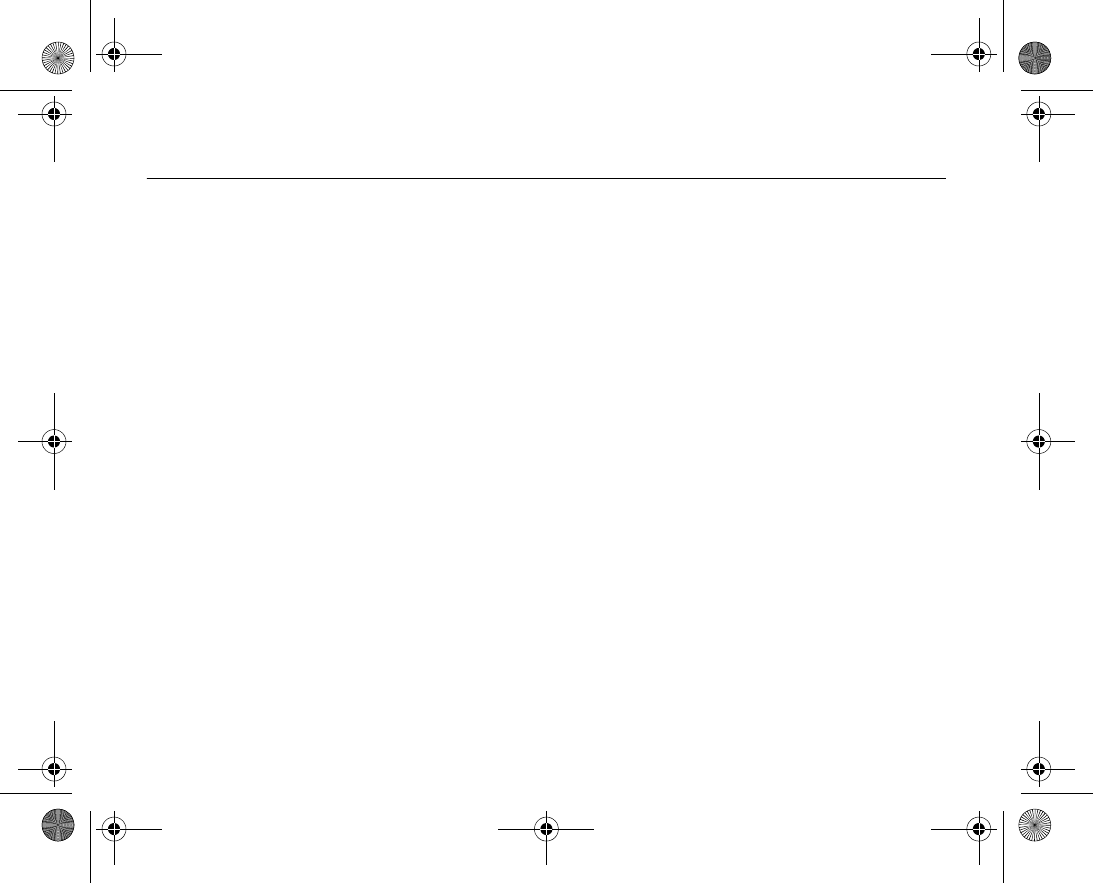
90
Sound recorder 4.6
With the sound recorder, you can record either your own memos or calls. Recorded
sounds can also be set as ringtones. Recording of a conversation is stopped if a partic
ipant ends the call. Recording of all sounds stops automatically if you receive a call. If
the recordings are saved in the phone they can be accessed even if you change your
SIM card.
Note:
In some countries or states it is required by law that you inform the other person before
recording the call.
To start a sound recording
1. } Entertainment } Record sound.
2. Wait until you hear a tone. When the recording starts, Recording is displayed
together with the time of the current recording (increasing).
3. } Save to end the recording, and } Play to listen to the recording. } More to view
the following options: Record new, Send, Rename, Delete, Recorded sounds.
To listen to your recordings
1. } My Items } Sounds and select the recording you want to hear.
2. } Play to listen to the recording and } Stop to stop playback.
VF_Nanami_UG_R1A.book Page 90 Tuesday, June 14, 2005 10:00 AM